 �A�x�𗘗p���ăh�C�c�E�h���C�u���s�ɏo�����܂����B�h�C�c�̍������H�͗L���ȁu�A�E�g�o�[���v�B�Ɩ����͂Ȃ��A�����B�������x�͖������̂Ƃ��������B�܂��Ȃ��L���ɂȂ�̂ł́c�Ƃ������Ă��܂��B�u�A�E�g�o�[���v�ŏa�Ƀn�}��܂����c �A�x�𗘗p���ăh�C�c�E�h���C�u���s�ɏo�����܂����B�h�C�c�̍������H�͗L���ȁu�A�E�g�o�[���v�B�Ɩ����͂Ȃ��A�����B�������x�͖������̂Ƃ��������B�܂��Ȃ��L���ɂȂ�̂ł́c�Ƃ������Ă��܂��B�u�A�E�g�o�[���v�ŏa�Ƀn�}��܂����c
We went on a journey to Germany by car on this consecutive holidays. The famous "autobahn" is German highways. There are no floodlights and it's free. Some areas don't have speed limit. It is said it will be charged a fee soon. We got stuck in traffic in autobahn. |
| �@�h�C�c���s Trip to Germany�@Masaki�@ 2015�N5��7��(��) 3:29 |
�C�� |
 �܂��̓~�����X�^�[�́u�h�C�c��Ԕ����فv�ɓ����B���̓W���̒��S��40���̐��h�C�c�A�M�R�Ƌ����h�C�c�R��ԕ��тɑ�2����풆��40���̋��h�C�c���h�R��ԂƎԗ��ł��B�����đ�풆�̃��V�A�ԌR�A�p�ČR�̐�Ԃ�����܂��B�قƂ�ǂ̎ԗ��͋@�\���C�����ĉғ��\�ƂȂ��Ă��܂��B�����كX�^�b�t�͂��ׂĂ̎ԗ��̌��X�̎p�Ɠh����Ԃ����߂����߂̍L�͈͂Ȓ������s���Ă��܂�� �܂��̓~�����X�^�[�́u�h�C�c��Ԕ����فv�ɓ����B���̓W���̒��S��40���̐��h�C�c�A�M�R�Ƌ����h�C�c�R��ԕ��тɑ�2����풆��40���̋��h�C�c���h�R��ԂƎԗ��ł��B�����đ�풆�̃��V�A�ԌR�A�p�ČR�̐�Ԃ�����܂��B�قƂ�ǂ̎ԗ��͋@�\���C�����ĉғ��\�ƂȂ��Ă��܂��B�����كX�^�b�t�͂��ׂĂ̎ԗ��̌��X�̎p�Ɠh����Ԃ����߂����߂̍L�͈͂Ȓ������s���Ă��܂��
First of all, we arrived at "German Tank Museum" in Munster. The heart of the exhibition is a collection of about 40 Bundeswehr and former East German (Nationale Volksarmee) tanks as well as 40 German tanks and other Wehrmacht vehicles from the Second World War. In addition there are tanks from the Red Army, British Army and United States Army from the war. Most of the vehicles are in working order, with restoration work ongoing to render all examples functional. The restoration staff of the museum do extensive research on every vehicle in order to return it to its original configuration and paint scheme. |
| �@�h�C�c���s�@Masaki�@ 2015�N5��7��(��) 3:33 |
�C�� |
 �u�ˌ���� A7V�v(���v���J) �u�ˌ���� A7V�v(���v���J)
A7V�͑�1����풆��1918�N�̃h�C�c����Ԃł��B20����1918�N3������10���̍��Ŏg���A���ꂪ�P�����Ŏg��ꂽ�B��̃h�C�c����Ԃł����B����7.34m�A��3m�A�����i�ō��l�j��3.3m�ł����B���ʑ��b��20mm�A�S�ʑ��b��30mm�A��ʑ��b��10mm�ł����B���̐�Ԃ�6����7.92 mm MG08�@�֏e��5.7cm�J�m���C���O�ʂɑ�������Ă��܂����B�J�m���C�̓C�M���X���ł������͐푈�����Ƀx���M�[���b�l����A�c���1918�N�Ƀ��V�A���b�l����܂����B
"A7V"(replica of the original tank)
The A7V was a tank introduced by Germany in 1918, during World War I. 20 tanks were used in action from March to October in 1918, and were the only tanks produced by Germany in World War I to be used in operations. The A7V was 7.34 metres long, 3 metres wide, and the maximum height was 3.3 metres. The tank had 20 mm of steel plate at the sides, 30 mm at the front and 10 mm for the roof. The A7V was armed with six 7.92 mm MG08 machine guns and a 5.7 cm Maxim-Nordenfelt cannon mounted at the front. Some of these cannons were of British manufacture and had been captured in Belgium early in the war, others were captured in Russia in 1918. |
| �@�h�C�c���s Trip to Germany�@Masaki�@ 2015�N5��7��(��) 3:33 |
�C�� |
 �u�c�F���_�b�v/KS750���h�R�T�C�h�J�[�v �u�c�F���_�b�v/KS750���h�R�T�C�h�J�[�v
�c�F���_�b�v��1917�N�Ƀj���[�����x���O�Őݗ����ꂽ��v�ȃh�C�c�̃I�[�g�o�C������Ђł��B1984�N�ɔj�Y���܂����B���̃o�C�N�̓h�C�c�E�A�t���J�R�c�d�l�ŃT���h�E�C�G���[�ɓh���Ă��܂��B
"Zuendapp KS750 Wehrmacht sidecar"
Zuendapp) was a major German motorcycle manufacturer founded in 1917 in Nuremberg. The company collapsed in 1984. This bike is painted with sand-yellow in German Africa Corps spec. |
| �@�h�C�c���s Trip to Germany�@Masaki�@ 2015�N5��7��(��) 3:36 |
�C�� |
 �u�N���b�v �v���b�c�F Kfz.70 �����A���^�v �u�N���b�v �v���b�c�F Kfz.70 �����A���^�v
1934�N����1941�N�ɐ��Y���ꂽ�h�C�c��6�ց~4�쓮�g���b�N�A�����Ԃő�2�����ōL���g���܂����B55�n�́A�Ȃ���60�n�́i36�N����j��4�C��M304�K�\�����G���W���𓋍ڂ��Ă��܂����B�����Y�ʂ͖�7000���ł��B
"Krupp Protze Kfz.70-Standard configuration for personnel carrying"
It was a six-wheeled 6x4 German truck and artillery tractor produced between 1934 and 1941 and heavily used in World War II. It was powered by a 55 hp or 60 hp (since 1936) Krupp M 304 4-cylinder petrol engine. Total production was about 7,000 units. |
| �@�h�C�c���s Trip to Germany�@Masaki�@ 2015�N5��7��(��) 3:39 |
�C�� |
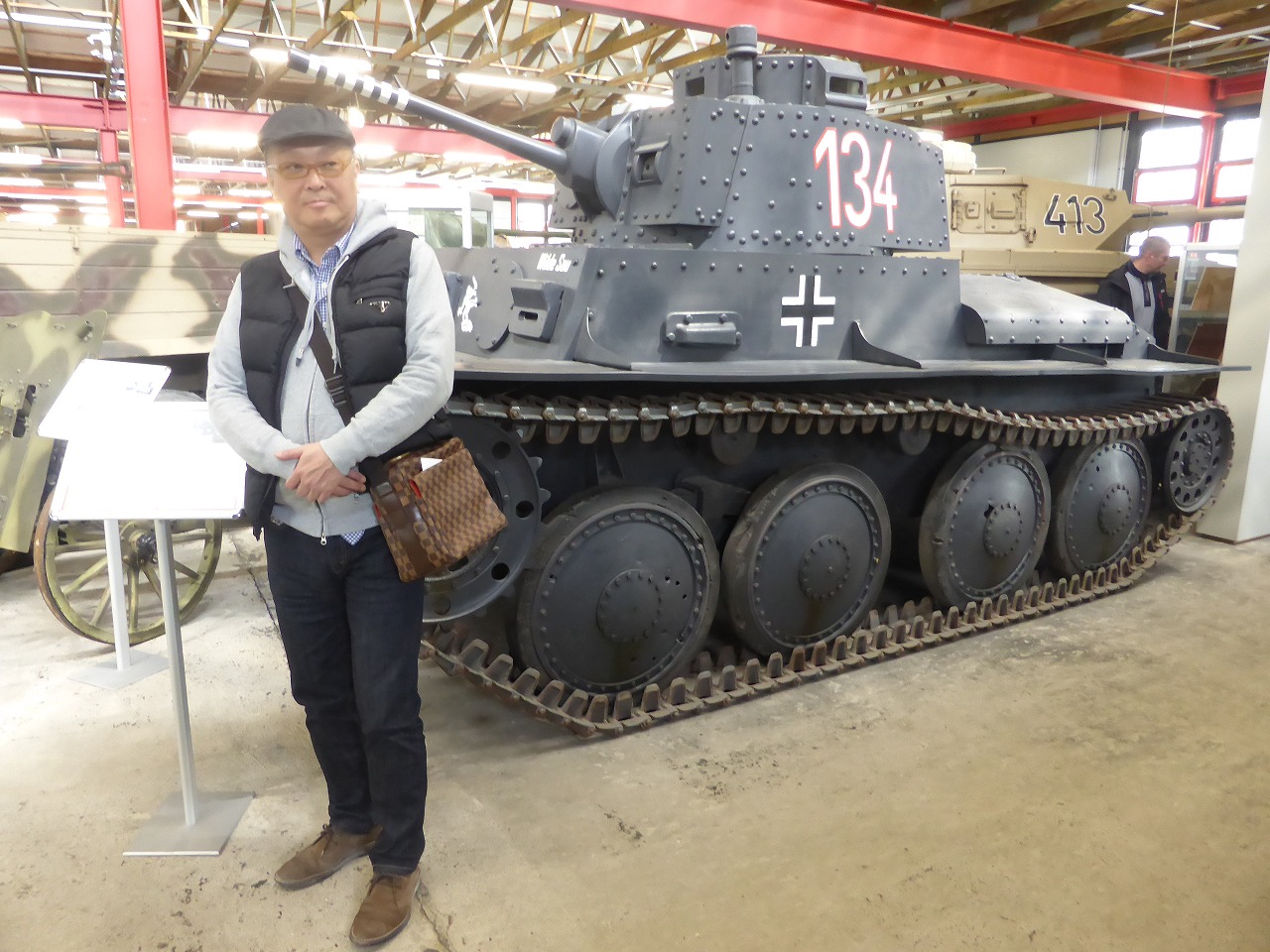 �u38(t)��ԁv �u38(t)��ԁv
���̐�Ԃ͌��X��2�����O�̃`�F�R����Ԃł��B�h�C�c�R�̃`�F�R��̂̌�A�|�[�����h�A�t�����X�A���V�A�N�U������Ƀh�C�c���R�ɍ̗p����܂����B���b���s�\���ƍl����ꐶ�Y��1942�N�ŏI�����܂����B�ŏI�I��1400���ȏオ���Y����܂����B�V���V�[�̓}�[�_�[�V�̂��߂ɐ��Y���p������A�������̍\���i�͌�ɋ쒀��ԃw�b�c�@�[�Ɏg�p����܂����B(t)�̓h�C�c��Ń`�F�R��\���܂��B��v������37mm�X�R�_��A7�C�ł����B
"Panzer 38(t)"
This tank was originally a Czech tank of pre-World War II design. After Czechoslovakia was taken over by Germany, it was adopted by the German Army, seeing service in the invasions of Poland, France and Russia. Production ended in 1942, when its armament was deemed inadequate. In all, over 1400 were manufactured. The chassis continued to be produced for the Marder III (1942-1944) with some of its components used in the later Jagdpanzer 38 (1944-1945) tank destroyers. The (t) stands for tschechisch, the German word for Czech. Main armament was 37.2 mm Skoda A7 gun. |
| �@�h�C�c���s Trip to Germany�@Masaki�@ 2015�N5��7��(��) 3:40 |
�C�� |
 �u37mm�ΐ�ԖCPak36�v �u37mm�ΐ�ԖCPak36�v
37mm���a�̑ΐ�ԖC�ł��1941�N���܂Ńh�C�c���h�R�̎�͑ΐ�ԖC�ł����B�������A41�N�㔼�܂ł̃\�A�R����Ԃ̑�ʏo���͋}���ɂ��̖C�͉����܂����B��������ɂ������T-34��Ԃɑ���݂��߂Ȍ��ʂɂ��Heeresanklopfgerat�i����h�A�m�b�J�[�j�Ƃ��������������܂����B����͋�����p�x�ɂ�����炸�A�e���o�E���h���P�ɑ��b���ւ��܂��đΐ�ԖC�̑��݂ʂɒm�点�邱�Ƃ������Ă�T-34�ɑ��Ȃ�̌��ʂ����������Ȃ��\�͂̂����ł����B
"37mm Pak 36"
The Pak36 was a German anti-tank gun that fired a 3.7 cm calibre shell. It was the main anti-tank weapon of Wehrmacht infantry units until mid-1941. By late 1941, however, the widespread introduction of Soviet medium tanks quickly erased the gun's effectiveness; miserable performance against the T-34 on the Eastern Front led to the Pak 36 being nicknamed Heeresanklopfgerat (literally "army door-knocking device"), for its inability to produce any effect on the T-34 aside from notifying the tank of its presence by futilely bouncing rounds off its armor (regardless of the angle or distance). |
| �@�h�C�c���s Trip to Germany�@Masaki�@ 2015�N5��7��(��) 3:45 |
�C�� |
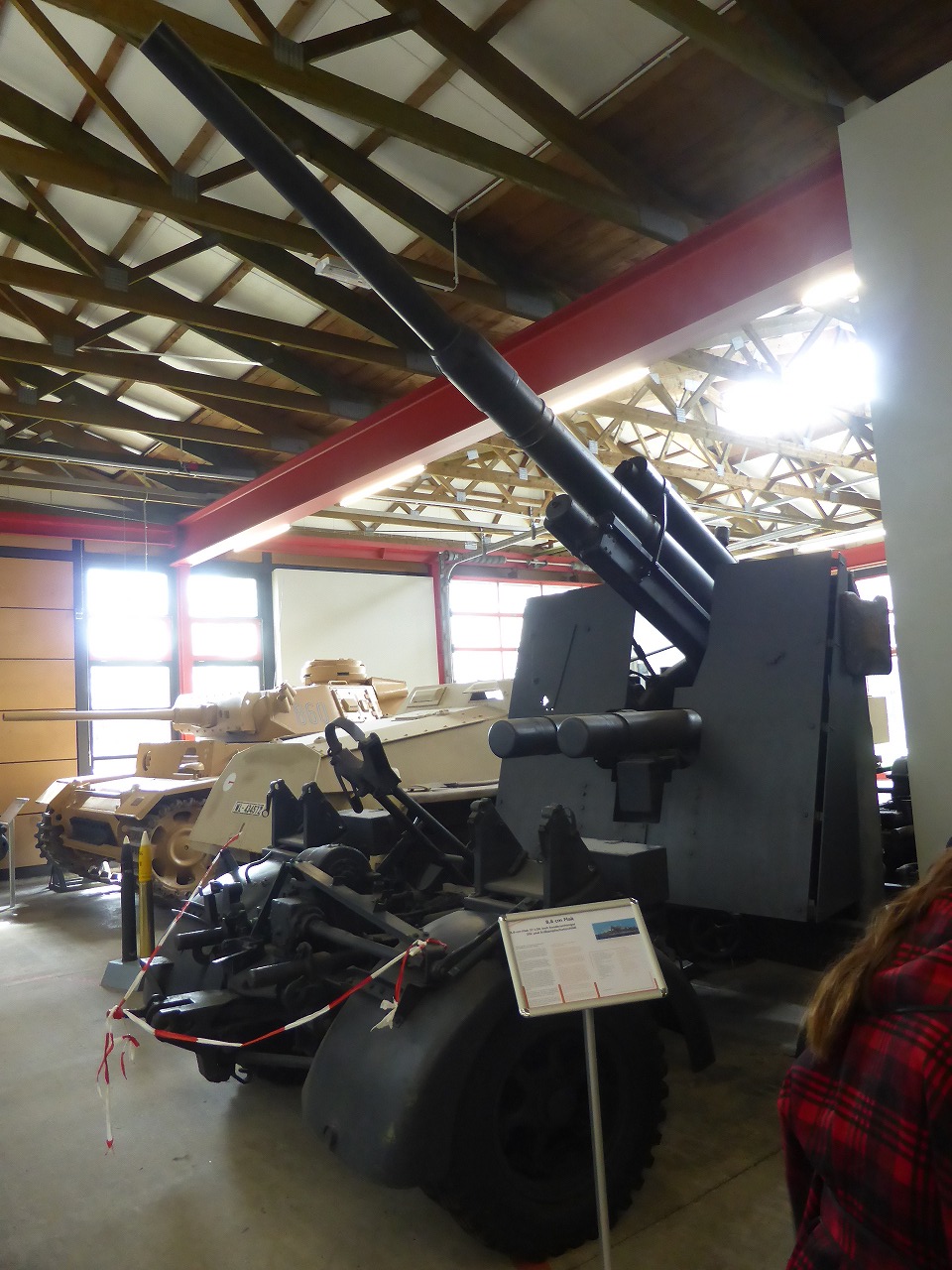 �u88mm���˖CFlak37�v �u88mm���˖CFlak37�v
88mmFlak37�i��ʓI��88�ƌĂ�Ă��܂��j�͑�2����펞�̌�����C���тɑΐ�ԖC�ł��B����ރh�C�c�R�ɍł��g��ꤍł�����Ƃ��ĔF�߂��܂����BFlak��88mm�C�̌��X�̖ړI�ł���h�C�c��̑Δ�s�@�C���Ӗ����܂��B�p��ł�Flak�͒n��̈�ʓI���̂ƂȂ��Ă��܂��B88mm�C�͖{���̖ړI�ł����퓬�Ɠ��l�A�ΐ�Ԑ퓬�ł��D�G�����ؖ����܂����B���̐����͂��̑��˂ɂ���܂��B����̂��̂ƈႢ�A��ʓI�ȑ�C�͐��������ȉ��ɖC�g�������܂���ł����B��킪�i�ނɂ�A�ʏ�̑ΐ�ԖC���G�̏d��Ԃ��ђʂł��Ȃ����Ƃ��܂��܂����炩�ɂȂ�A���R�̎w�����͂܂��܂�88mm�C��ΐ�ԖC�Ƃ��Ċ��p���n�߂܂����B
"88mm Flak37"
The 88mm Flak37 (commonly called the eighty-eight) was a German 88 mm anti-aircraft and anti-tank artillery gun from World War II. It was widely used by Germany throughout the war, and was one of the most recognized German weapons of that conflict. Flak is a contraction of German Flugzeugabwehrkanone, meaning "aircraft-defense cannon", the original purpose of the eighty-eight. In English, "flak" became a generic term for ground anti-aircraft fire. The 88mm Flaks performed well in its original role of an anti-aircraft gun, and it proved to be a superb anti-tank gun as well. Its success was due to its versatility: the standard anti-aircraft platform allowed gunners to depress the muzzle below the horizontal, unlike most of its contemporaries. As WW2 progressed, it was becoming increasingly clear that existing anti-tank weapons were unable to pierce the armor of heavier enemy tanks. Ground commanders began increasingly to utilize the 88mm Flak against enemy tanks. |
| �@�h�C�c���s Trip to Germany�@Masaki�@ 2015�N5��7��(��) 3:46 |
�C�� |
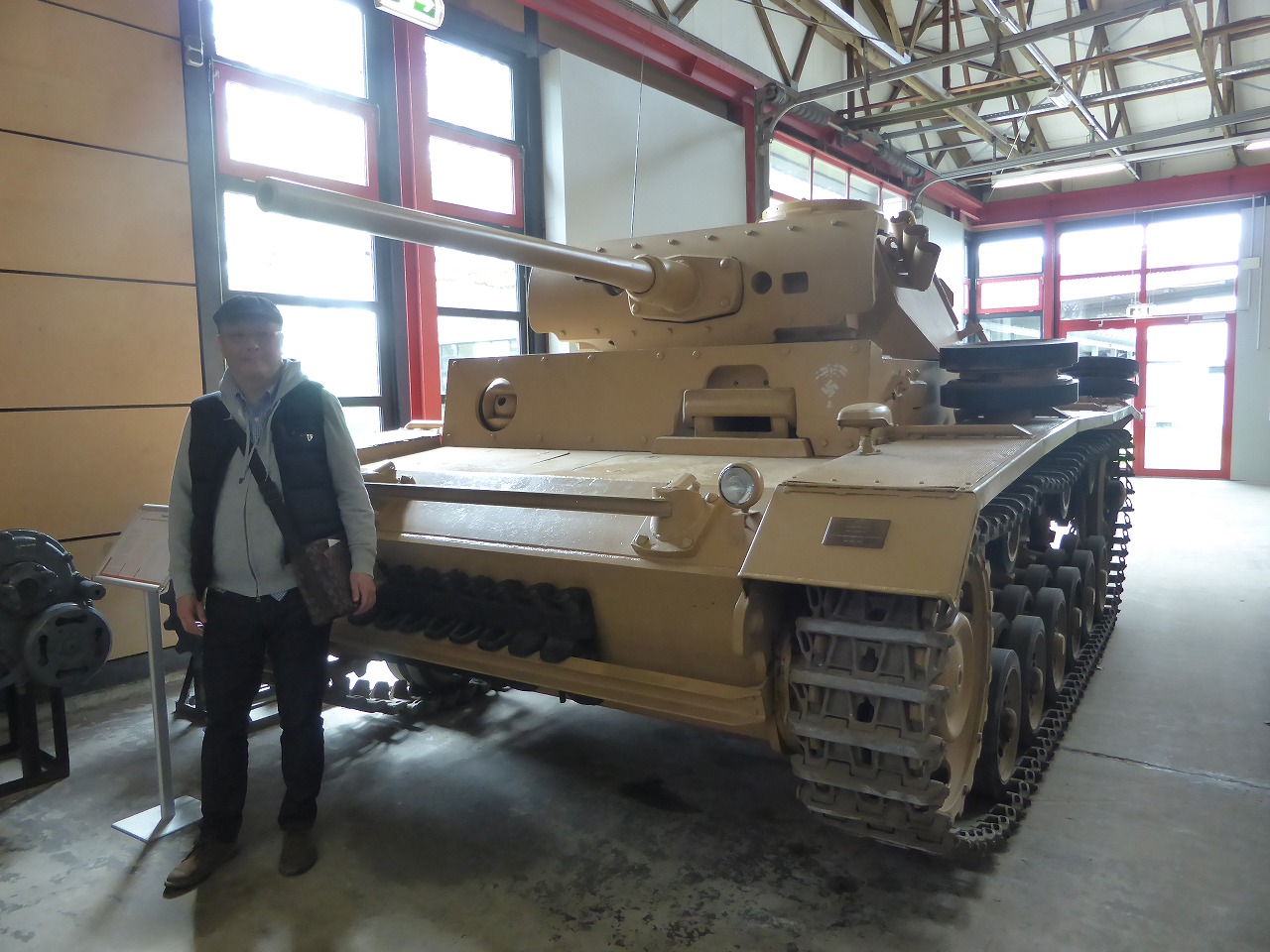 �u�V�����M�^�v �u�V�����M�^�v
�V����Ԃ�1930�N��Ƀh�C�c�ŊJ�����ꂽ���^��Ԃ̈�ʖ��̂ő�2�����ōL���g���܂����B�����ȃh�C�c���̂�|��Ε����퓬�ԗ��ƂȂ�܂��B�ΐ�ԗp��ԂŞ֒e�C�x����Ԃ̇W����Ԃ̘e�Ŏ��͂��ł������A���͂�T-34��ԂƑ��������h�C�c�R�͂�苭�͂ȑΐ�ԖC���K�v�ƂȂ�܂����A���̂��߂��傫�ȖC���a���������W����ԂƖ������t�]���܂����B�W����Ԃ͒��C�g��75mm�C�𓋍ڂ��A�ΐ�Ԑ퓬�̖����ƂȂ�܂����B1942�N�̍ŏI�o�[�W�����ł���N�^��24���a75mm�C�𓋍ڂ��A�����x���ɂ��K�������̂ƂȂ�܂����B�V����Ԃ̐��Y��43�N�ŏI�����܂������A���̗L�p�ȃV���V�[�͇V���ˌ��C�̂��߂ɍŌ�܂Ő��Y����܂����BA�^����F�^�����܂ł�45���a37mm�C�𓋍ځB���̖C��39�N����40�N�܂ł̐퓬�ł͗L�������ؖ�����܂������AF�^�������J�^�܂ł�42���a50mm�C�����ڂ���܂����B�����ĉ��䂩��J�^����M�^�܂ł͑��傷���苭�͂ȓG�ɑR���邽�ߒ��C�g60���a50mm�C�����ڂ���܂����B
"Panzer III Ausf. M"
Panzer III was the common name of a medium tank that was developed in the 1930s by Germany and was used extensively in World War II. The official German designation was Panzerkampfwagen III Sd Kfz. 141 (abbreviated PzKpfw III) translating as "armoured fighting vehicle". It was intended to fight other armoured fighting vehicles and serve alongside the HE support Panzer IV; however, as the Germans faced the formidable T-34, stronger anti-tank guns were needed. Since the Panzer IV had a bigger turret ring, the roles were reversed. The Panzer IV mounted the long barrelled 7.5 cm KwK 40 gun and engaged in tank-to-tank battles. From 1942, the last version of Panzer III, Aust.N, mounted the 7.5 cm KwK 37 L/24, better suited for infantry support. Production of the Panzer III ended in 1943. However, the Panzer III's capable chassis provided hulls for the Sturmgeschutz III assault gun until the end of the war. The Ausf. A to early Ausf. F were equipped with a 3.7 cm KwK 36 L/45, which proved adequate during the campaigns of 1939 and 1940, but the later Ausf. F to Ausf. J were upgraded with the 5 cm KwK 38 L/42 and some of the Ausf. J to M with the longer 5 cm KwK 39 L/60 gun in response to increasingly better armed and armoured opponents. |
| �@�h�C�c���s Trip to Germany�@Masaki�@ 2015�N5��7��(��) 3:48 |
�C�� |
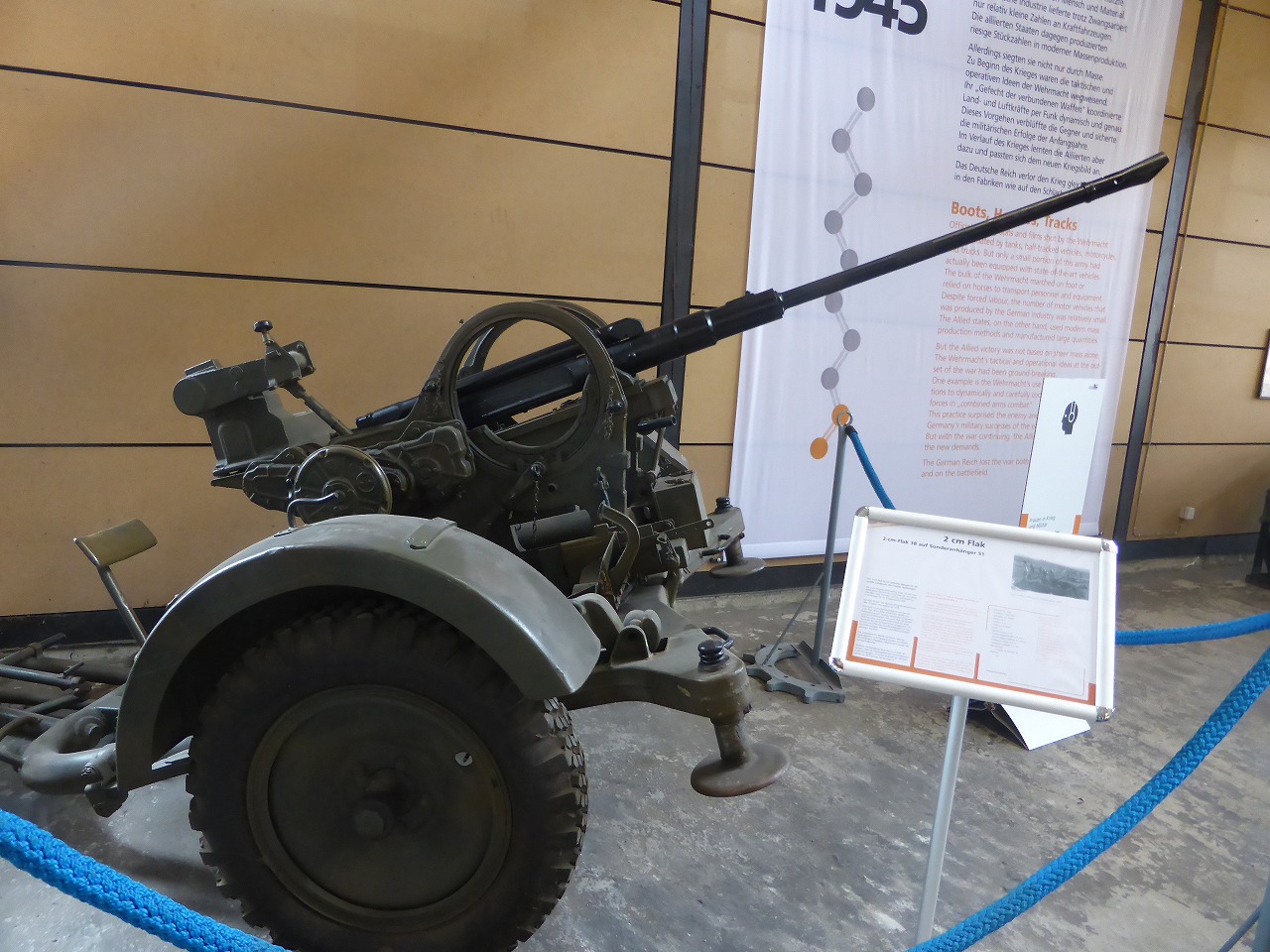 �u20mm��@�֖CFlak30�v �u20mm��@�֖CFlak30�v
Flak30�͑�2������ʂ��ăh�C�c�R�Ɏg�p���ꂽ20mm��@�֖C�ł��B�h�C�c�R�̎�v�Ȍy�@�֖C�����������łȂ��A��풆���ɔ�ł��������Y���ꂽ�C�ł�����܂��B
"20mm Flak30"
The Flak 30 (Flugabwehrkanone 30) was 20 mm anti-aircraft guns used by various German forces throughout World War II. It was not only the primary German light anti-aircraft gun, but by far the most numerously produced German artillery piece throughout the war. |
| �@�h�C�c���s Trip to Germany�@Masaki�@ 2015�N5��7��(��) 3:49 |
�C�� |
 �u�W�����G�^�v �u�W�����G�^�v
�L���W����Ԃƒm���Ă��邱�̐�Ԃ�1930�N��㔼�ɊJ�����ꂽ���^��Ԃő�2����풆�L���g���܂����B�֒e�C���ڎx����ԂƂ��ĊJ�����ꂽ�Α��b�ԗ��p�ł͂���܂���ł����B���̖�ڂ͇V����Ԃł����B�������V����Ԃ̔�͂����炩�ɂȂ�A����T-34��ԂƂ̑����ɂ��W����Ԃ͑��傷���͂Ȓ��Ԃ̖����������Ɉ����p���܂����B��풆�A�ł��������Y�A�z�u���ꂽ�h�C�c�R��Ԃő��̐擪�ԗ��̓y��Ƃ��Ďg���܂����B���̌��ł��Ƒ��ː��ŇW����Ԃ̓h�C�c���܂ނ��ׂĂ̐��Ɍ���A1936�N����45�N�܂�8800���ȏオ����ꂽ�푈���r��邱�ƂȂ����Y���ꂽ�B��̃h�C�c��Ԃł��BA�^����F1�^�܂ł�24���a75mm�C�����ڂ���܂����BF2�^���珉��G�^�܂ł�43���a75mm�C�ɃA�b�v�O���[�h����A���G�^����J�^�ɂ�48���a75mm�C�����ڂ���܂����B
"Panzer IV Ausf G"
The Panzerkampfwagen IV (Pz.Kpfw. IV), commonly known as the Panzer IV, was a German medium tank developed in the late 1930s and used extensively during the Second World War. Designed as an HE support tank, the Panzer IV was not intended to engage enemy armor-that role being allocated to the Panzer III. However, with the inadequacy of the Panzer III becoming apparent and in the face of Soviet T-34 tanks, the Panzer IV soon assumed the original role of its increasingly vulnerable cousin. The most widely manufactured and deployed German tank of the Second World War, the Panzer IV was used as the base for many other fighting vehicles. Robust and reliable, the Panzer IV saw service in all combat theaters involving Germany and was the only German tank to remain in continuous production throughout the war, with over 8800 produced between 1936 and 1945. The Ausf. A to early Ausf. F1 were equipped with a 75mm KwK 37 L/24. Ausf. F2 to early Ausf. G were upgraded with the 75mm KwK 40 L/43 and later Ausf. G to J with the longer 75mm KwK 40 L/48 gun |
| �@�h�C�c���s Trip to Germany�@Masaki�@ 2015�N5��7��(��) 3:50 |
�C�� |
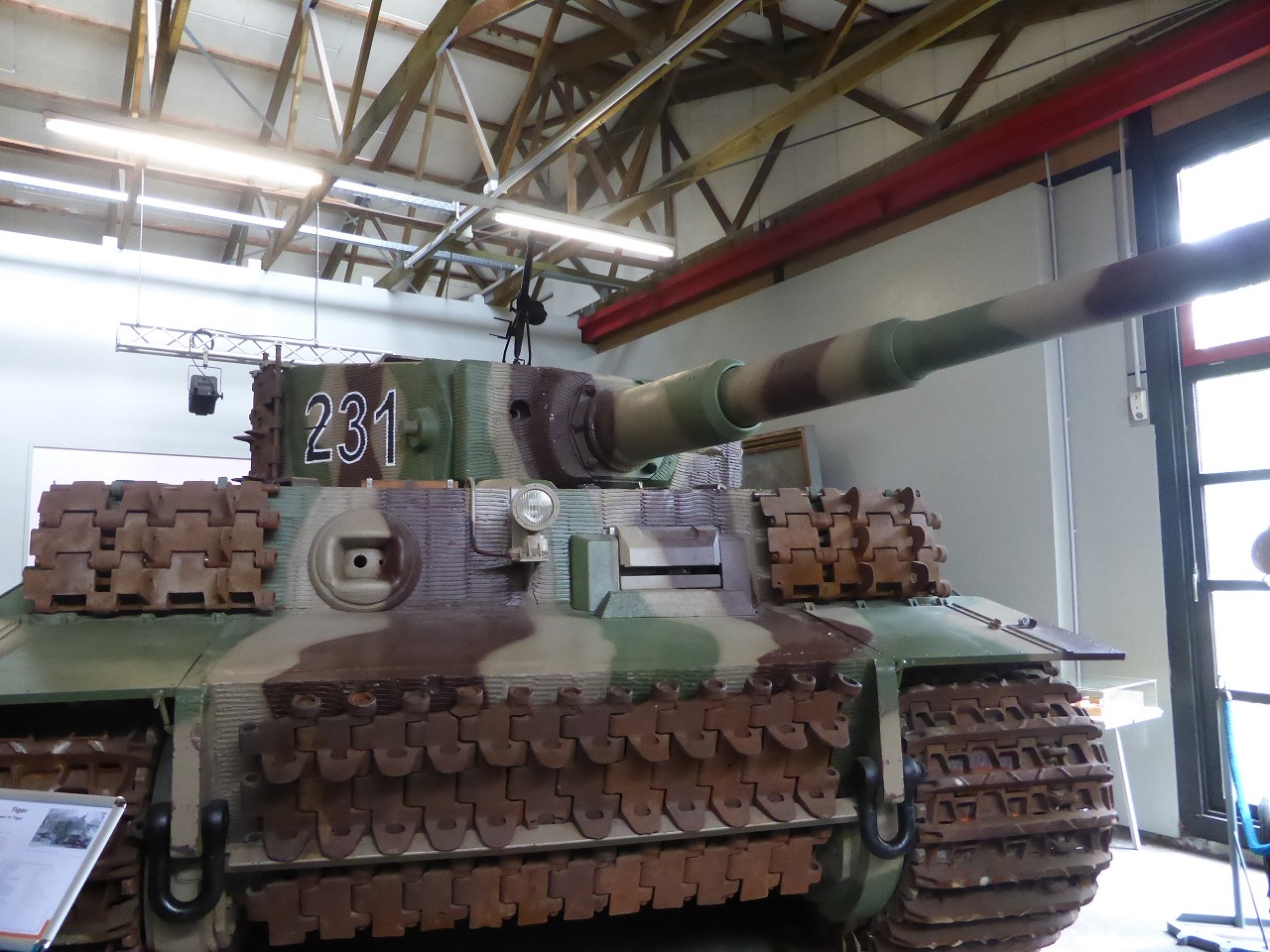 �u�Y����ԃe�B�[�K�[�T�v �u�Y����ԃe�B�[�K�[�T�v
�e�B�[�K�[�T��1942�N�ɊJ�������2�����Ŏg�p���ꂽ�h�C�c�d��Ԃ̒ʏ̂ł��B�Α��b�ԗ��p��88mm�CKwK 36�𓋍ڂ������h�R�ŏ��̐�Ԃł��B�ʏ�傫�Ȍ��ʂ��������Ɨ��d��ԑ���ɔz�u����܂����B�e�B�[�K�[�͑�z�����f�U�C���������A�����ȍޗ��Ƒ���ȘJ���͂�K�v�Ƃ���I�[�o�[�X�y�b�N�Ȑ�ԂƌĂ�Ă��܂��B1942�N8������44�N8���܂ł�1347���݂̂����Y����܂����B�O�������̌��ׂƌ̏Ⴊ�����A�R���g�p�ʂ̑�������ړ��ɂ͐���������܂����B1944�N�ɐ��Y�̓e�B�[�K�[�U�Ɉڍs���܂����B�e�B�[�K�[�̖��O�̓|���V�F���m�ɂ���ė^�����A���[�}�����u�T�v�̓e�B�[�K�[�U�����Y���ꂽ���߁A�ォ������܂����B�ԗ��O�ʑ��b��100mm�A�C���O�ʑ��b��100mm�ŖC������120mm�̑��b�ł����B���ʂ�60mm�ł��̏㕔�\����80mm�̑��b�ł����B56���a88mm�CKwK 36�𓋍ڂ��Ă��܂����B
"Tiger I"
Tiger I is the common name of a German heavy tank developed in 1942 and used in World War II. The Tiger I gave the Wehrmacht its first tank which mounted the 88 mm gun in its first armoured fighting vehicle-dedicated version: the KwK 36. It was usually deployed in independent heavy tank battalions, which proved highly effective. While the Tiger I has been called an outstanding design, it was over-engineered, using expensive materials and labour-intensive production methods. Only 1,347 were built between August 1942 and August 1944. The Tiger was prone to certain types of track failures and breakdowns, and limited in range by its high fuel consumption. In 1944, production was phased out in favour of the Tiger II. The tank was given its nickname "Tiger" by Ferdinand Porsche, and the Roman numeral was added after the later Tiger II entered production. The Tiger I had frontal hull armour 100mm thick, frontal turret armour of 100mm and a 120mm thick gun mantlet. The Tiger had 60mm thick hull side plates and 80mm armour on the side superstructure/sponsons, while turret sides and rear were 80 mm. The 56-calibre long 88mm KwK 36 was chosen for the Tiger. |
| �@�h�C�c���s Trip to Germany�@Masaki�@ 2015�N5��7��(��) 3:51 |
�C�� |
 �u�X����ԃp���^�[A�^�v �u�X����ԃp���^�[A�^�v
�p���^�[��1943�N�������2����킪�I�����1945�N�܂ʼn��B����Ŏg��ꂽ�h�C�c�R����Ԃł��B�\�A�R��T-34��Ԃ̑R�Ƃ��č���A����܂ł̇V���A�W����Ԃƒu��������ꂽ�ƍl�����Ă��܂����A���ۂ͌�҂͏d��ԃe�B�[�K�[�T�Ƌ��ɏI��܂Ŏg�p���ꑱ���܂����B�p���^�[�͂��̉Η͂Ɩh��͂ő�2�����ɂ�����x�X�g��Ԃƍl�����Ă������A�@�����A�M�����A�R�X�g�͂����܂ł������͂���܂���ł����B��C�̓��C�����^����70���a75mm�CKwK 42�𓋍ڂ��Ă��܂��B���b�͑O�ʂ�140mm�����A���ʂ�40-58mm�����A�㕔��46mm�����ƂȂ��Ă��܂��B�p���^�[�͇V���ˌ��C��9408����W����Ԃ�8298���ɑ����O�Ԗڂɑ������Y���ꂽ�h�C�c�R���b�퓬�ԗ���5987�������Y����܂����B
The Panther was a German medium tank deployed during World War II from mid-1943 to the end of the European war in 1945. It was intended as a counter to the Soviet T-34, and as a replacement for the Panzer III and Panzer IV. While never replacing the latter, it served alongside it and the heavier Tiger I until the end of the war. While the Panther is considered one of the best tanks of World War II due to its excellent firepower and protection, it was less impressive in terms of mobility, reliability, and cost. The main gun was a Rheinmetall-Borsig 7.5 cm KwK 42 (L/70). Armour are Front 140 mm effective, Sides 40-58 mm effective and Rear 46 mm effective. The Panther was the third most produced German armoured fighting vehicle, 5987Unit, after the Sturmgeschütz III assault gun/tank destroyer at 9,408 units, and the Panzer IV tank at 8,298 units. |
| �@�h�C�c���s Trip to Germany�@Masaki�@ 2015�N5��7��(��) 3:53 |
�C�� |
 �u�S���A�e�v �u�S���A�e�v
�S���A�e�̓h�C�c�̃����R�����j��ԗ��ŘA�����ł͍b����ԂƂ��Ēm���Ă��܂����B��2����풆�Ƀh�C�c���h�R�ɔz������܂����B�@��ɂ����60����100kg�̍����\�Ζ��ς݁A��ԁA�����̖��W����A�r���⋴�̔j�̑��ʂȖړI�Ɏg���邱�ƂɂȂ��Ă��܂����B
"Goliath tracked mine"
Goliath tracked mine was a remote controlled German-engineered demolition vehicle, also known as the beetle tank to the Allies. Employed by the Wehrmacht during World War II. It carried 60 or 100 kilograms of high explosives, depending on the model, and was intended to be used for multiple purposes, such as destroying tanks, disrupting dense infantry formations, and demolition of buildings and bridges.
|
| �@�h�C�c���s Trip to Germany�@Masaki�@ 2015�N5��7��(��) 3:54 |
�C�� |
 �u�P�b�e���N���[�g�v �u�P�b�e���N���[�g�v
�P�b�e���N���[�g�͋���p�Ƃ��Đ��܂�܂����B���̎ԗ���Ju52�A���@�ʼn^��邱�Ƃ��O��Ńp���V���[�g���p�͍l�����Ă��܂���ł����B���̎ԗ���Ju52�A���@�ʼn^�ׂ�\���ȏ������Ƃ������_�������A�����I�ɗ��p�ł���ł��y���ʎY�ԗ��ł����B
"SdKfz 2 Kettenkrad"
Kettenkrad started its life as a light tractor for airborne troops. The vehicle was designed to be delivered by Junkers Ju 52 aircraft, though not by parachute. The vehicle had the advantage of being the only gun tractor small enough to fit inside the hold of the Ju 52, and was the lightest mass-produced German military vehicle to use the complex. |
| �@�h�C�c���s Trip to Germany�@Masaki�@ 2015�N5��7��(��) 3:55 |
�C�� |
 �u���V�A��ԁ@T-34�^76�E1943�N���Y�^�v �u���V�A��ԁ@T-34�^76�E1943�N���Y�^�v
T-34�͐�Ԃ̃f�U�C���ɏd�傩�㐢�Ɏc��e����^�����\�A�R���^��Ԃł��B���̑��b�ƉΗ͂͑�����ɂ͌���肵�܂������A�����Α�2�����ɂ�����ł��L���ō������ʼne���̂����ԂƂ��ĔF������Ă��܂��B�ŏ�����T-34�͉ΉA���s���A���b�A��䂳�̑O��̂Ȃ��g�ݍ��킹�������Ă��܂����B����76.2mm���˖C�͓�����̐�Ԃ����邩�Ȃ�̔j��͂������A���̏d���X�Α��b�͓�����̑ΐ�ԕ���ɂ��j�������Ȃ��̂Ƃ��܂����B�����20-70mm�̑��b��F-34��ԖC��ς�43�N���Y�^�ł��B
"T-34 Model 1943"
The T-34 was a Soviet medium tank which had a profound and lasting effect on the field of tank design. Although its armour and armament were surpassed later in the war, it has been often credited as the most effective, efficient, and influential tank design of World War II. At its introduction, the T-34 possessed an unprecedented combination of firepower, mobility, protection, and ruggedness. Its 76.2 mm high-velocity tank gun provided a substantial increase in firepower over any of the T-34's contemporaries, its heavy sloped armour was difficult to penetrate by most contemporary anti-tank weapons. It's a Model 1943 with 20–70 mm armour and the superior F-34 76.2 mm gun. |
| �@�h�C�c���s Trip to Germany�@Masaki�@ 2015�N5��7��(��) 3:56 |
�C�� |
 �u�V���r�����[�Q���v �u�V���r�����[�Q���v
��2�����ōL�͈͂ɂ킽���ăh�C�c���R�ɂ���Ďg�p���ꂽ4�쓮�̐������p�Ԃł��B
"Volkswagen Schwimmwagen"
It was amphibious four-wheel drive off-roaders, used extensively by German ground forces during the Second World War. |
| �@�h�C�c���s Trip to Germany�@Masaki�@ 2015�N5��7��(��) 3:57 |
�C�� |
 �u�L���[�x�����[�Q���v �u�L���[�x�����[�Q���v
�L���[�x�����[�Q���i����̓o�P�c�ԁj�̓|���V�F���m�ɂ���Đv����t�H���N�X���[�Q���ЂŐ��Y���ꂽ�R�p�y�ԗ��ŁA��2����풆�h�C�c�R�i���h�R�ƕ���SS�̑o���j�ɂ���Ďg�p����܂����B�L���[�x�����[�Q���̓h�C�c�R�ɂƂ��ĘA���R�̃W�[�v��GAZ-67�Ɠ����悤�ȑ��݂ł����B
"Volkswagen Kubelwagen"
The Volkswagen Kubelwagen (literally, "bucket car") was a light military vehicle designed by Ferdinand Porsche and built by Volkswagen during World War II for use by the German military (both Wehrmacht and Waffen-SS). The Kubelwagen was for the Germans what the Jeep and GAZ-67 were for the Allies. |
| �@�h�C�c���s Trip to Germany�@Masaki�@ 2015�N5��7��(��) 3:59 |
�C�� |
 �uSd.Kfz. 251/9�^ 7,5cm�����C "Stummel"�����^�v �uSd.Kfz. 251/9�^ 7,5cm�����C "Stummel"�����^�v
���̃n�[�t�g���b�N�͑�2����펞�Ƀn�m�}�[�O�Ђɂ���ăf�U�C���A���Y���ꂽ���b�Ԃł��B���̎ԗ��͏��Ȃ��Ƃ�15252���ƍł��������Y���ꂽ�h�C�c�̃n�[�t�g���b�N�ő����̃o�[�W�����������̐��Y�H��ō���܂����B�܂��h�C�c�R�A�A�����̑o������P���Ɂu�n�m�}�[�O�v�ƌĂ�Ă��܂����B���̕���24���a75mm�֒e�C�����A�V���ˌ��C�Ɠ����C����g�p���܂����B�j�b�N�l�[���́u�X�`���[�����i�芔�j�v�ł����B
"Sd.Kfz. 251/9 Early Version"
The Sd.Kfz. 251 half-track was an armored fighting vehicle designed and first built by the Hanomag company during World War II. Sd.Kfz. 251s were the most widely produced German half-tracks of the war, with at least 15,252 vehicles and variants produced by various manufacturers, and were commonly referred to simply as "Hanomags" by both German and Allied soldiers. This type was equipped with a 75 mm L/24 low velocity gun, using the same pedestal gun mount employed on the StuG III. Nicknamed "Stummel" ("stump"). |
| �@�h�C�c���s Trip to Germany�@Masaki�@ 2015�N5��7��(��) 4:00 |
�C�� |
 �uSd.Kfz. 251/7�^ ���b�H���� "Pionierpanzerwagen"�v �uSd.Kfz. 251/7�^ ���b�H���� "Pionierpanzerwagen"�v
���b�H���p�ԗ��ł��B���ʂɓˌ��p�X�����^�ԑ����������Ă��܂����B
"Sd.Kfz. 251/7"
It's an assault engineer vehicle. This had fittings to carry assault bridge ramps on the sides. |
| �@�h�C�c���s Trip to Germany�@Masaki�@ 2015�N5��7��(��) 4:02 |
�C�� |
 �u8.8 cm�ΐ�ԖC PaK 43/41�v �u8.8 cm�ΐ�ԖC PaK 43/41�v
Pak43�͂��Ȃ�̌��т��ւ�h�C�c���h�R�̍ł����͂ȑΐ�ԖC�ŁA���ǂ���8.8cm KwK43�Ƃ��ăe�B�[�K�[�U�A�G���t�@���g�A���N�g�p���^�[��ΐ�Ԏ����C�i�[�X�z�������Ɏ�C�Ƃ��Ďg�p����܂����B
"8.8 cm PaK 43"
The Pak 43 was the most powerful anti-tank gun of the Wehrmacht to see service in significant numbers, also serving in modified form as the 8.8cm KwK43 main gun on the Tiger II tank, and Elefant, Jagdpanther and Nashorn tank destroyers. |
| �@�h�C�c���s Trip to Germany�@Masaki�@ 2015�N5��7��(��) 4:03 |
�C�� |
 �u�}�[�_�[�V�v �u�}�[�_�[�V�v
�}�[�_�[�V�͑�2�����ɂ�����ΐ�Ԏ����C�V���[�Y�̖��̂ł��B�\�A�R��76.2mm F-22 Model 1936��C��75mm�ΐ�ԖCPak40�̂ǂ��炩��38(t)��Ԃ̃V���V�[�ɃI�[�v���g�b�v�̐퓬���Ƌ��ɓ��ڂ������̂ł��B�斱���ی�͕n��ł�����������̐�Ԃɔ�חD�ꂽ�Η͂�����Ă��܂����B������1942�N����1944�N�ɂ����Đ��Y����A���ނ̃}�[�_�[�U�Ƌ��ɏI��܂ł��ׂĂ̐���ɔz�u����܂����B�h�C�c��́u�}�[�_�[�v�̓e���̈Ӗ��ł��B����H�^�̓h�C�c�R��7.5 cm PaK40�ΐ�ԖC�����ǂ���38(t)���H�^�̎ԑ̂ɓ��ڂ������̂ł��B
"Marder III"
Marder III was the name for a series of World War II German tank destroyers. They mounted either Soviet 76.2mm F-22 Model 1936 divisional field guns, or German 7.5 cm PaK 40, in an open-topped cupola on top of the chassis of the Panzer 38(t). They offered little protection to the crew, but added significant firepower compared to contemporary German tanks. They were in production from 1942 to 1944 and served on all fronts until the end of the war, along with the similar Marder II. The German word Marder means "marten" in English. This Ausf. H was equipped with 7.5 cm PaK40 German anti-tank gun on a slightly modified Panzer 38(t) Ausf. H chassis. |
| �@�h�C�c���s Trip to Germany�@Masaki�@ 2015�N5��7��(��) 4:04 |
�C�� |
 �u�쒀��ԃw�b�c�@�[�v �u�쒀��ԃw�b�c�@�[�v
��Ɂu�w�b�c�@�[�i���݂��ҁj�v�Ƃ��Ēm���郄�N�g�p���^�[38�̓`�F�R��38(t)��Ԃ̃V���V�[�𗘗p������2�����ɂ�����h�C�c�R�̌y�쒀��Ԃł��B����48���a75mm�ΐ�ԖCPak39�͇V���A�W���ˌ��C�Ɏg��ꂽ48���a75mm�ˌ��CStuK40�̉��ǔłł��B���̖C�͂Ńw�b�c�@�[�͒���������قƂ�ǂ̘A���R�A�\�A�R�̐�Ԃ�j��\�Łi�d��Ԃ������j�A���̖����b�͑��̃I�[�v���g�b�v�ł���}�[�_�[�U�A�V�ɔ�斱���ɂƂ��Ĉ��S�ł�����܂����B
"Hetzer"
The Jagdpanzer 38, later known as Hetzer ("baiter"), was a German light tank destroyer of the Second World War based on a modified Czechoslovakian Panzer 38(t) chassis. The 75 mm Pak 39 L/48 gun of it was a modified version of the 75 mm StuK40 L/48 used in the StuG III and StuG IV assault guns. With this gun the Jagdpanzer 38 was able to destroy nearly all Allied or Soviet tank types in service at long ranges (except heavy tanks) and its fully enclosed armor protection made it a safer vehicle to crew than the open-topped Marder II or Marder III series. |
| �@�h�C�c���s Trip to Germany�@Masaki�@ 2015�N5��7��(��) 4:07 |
�C�� |
 �u���V�A�R76mm��C��75mm�ΐ�ԖCPak40�v �u���V�A�R76mm��C��75mm�ΐ�ԖCPak40�v
76mm��CM1936�̓\�A�R�̏��ėp�C��1936�N�Ƀ\�A�ԌR�ɔz������܂����B���̖C�͋ɓ��ɂ�������\�R�̐퓬�A�~�푈�A��2�����Ŏg�p����܂����B��ʂ̖C���h�C�c���h�R���b�l����A���ǂ��ꂽ��\�A�R�ɑ��Ďg�p����܂����B75mm Pak40��1939�N����41�N�ɂ����ă��C�����^���ЂŊJ�����ꂽ�h�C�c�R�̑ΐ�ԖC�ő�2�����Ŏg�p����܂����BPak40�͑��㔼�̃h�C�c�ΐ�ԖC�̉��䍜�ƂȂ�܂����B
"76mm divisional gun M1936" and "75mm Pak40"
The 76mm divisional gun M1936 was a Soviet divisional semi-universal gun, adopted for Red Army service in 1936. This gun was used in conflicts between the USSR and Japan on the Far East, in the Winter War and in World War II. Many of them were captured by Wehrmacht, modernized by the Germans and used against Soviet forces. The 75mm Pak40 was a German anti-tank gun developed in 1939-1941 by Rheinmetall and used during the Second World War. The Pak40 formed the backbone of German anti-tank guns for the latter part of World War II. |
| �@�h�C�c���s Trip to Germany�@Masaki�@ 2015�N5��7��(��) 4:09 |
�C�� |
 �u�W���쒀��ԁv �u�W���쒀��ԁv
�W���쒀��Ԃ͇W����Ԃ̃V���V�[�𗘗p�����쒀��Ԃł��B���̌^��48���a75mm�ΐ��Pak39�����A1944�N1������11���ɂ�����769����784�������Y����܂����B
"Jagdpanzer IV"
The Jagdpanzer IV, Sd.Kfz. 162, was a tank destroyer based on the Panzer IV chassis. This type was equipped with 7.5 cm Pak39 L/48. 769-784 units were produced in January 1944 - November 1944. |
| �@�h�C�c���s Trip to Germany�@Masaki�@ 2015�N5��7��(��) 4:10 |
�C�� |
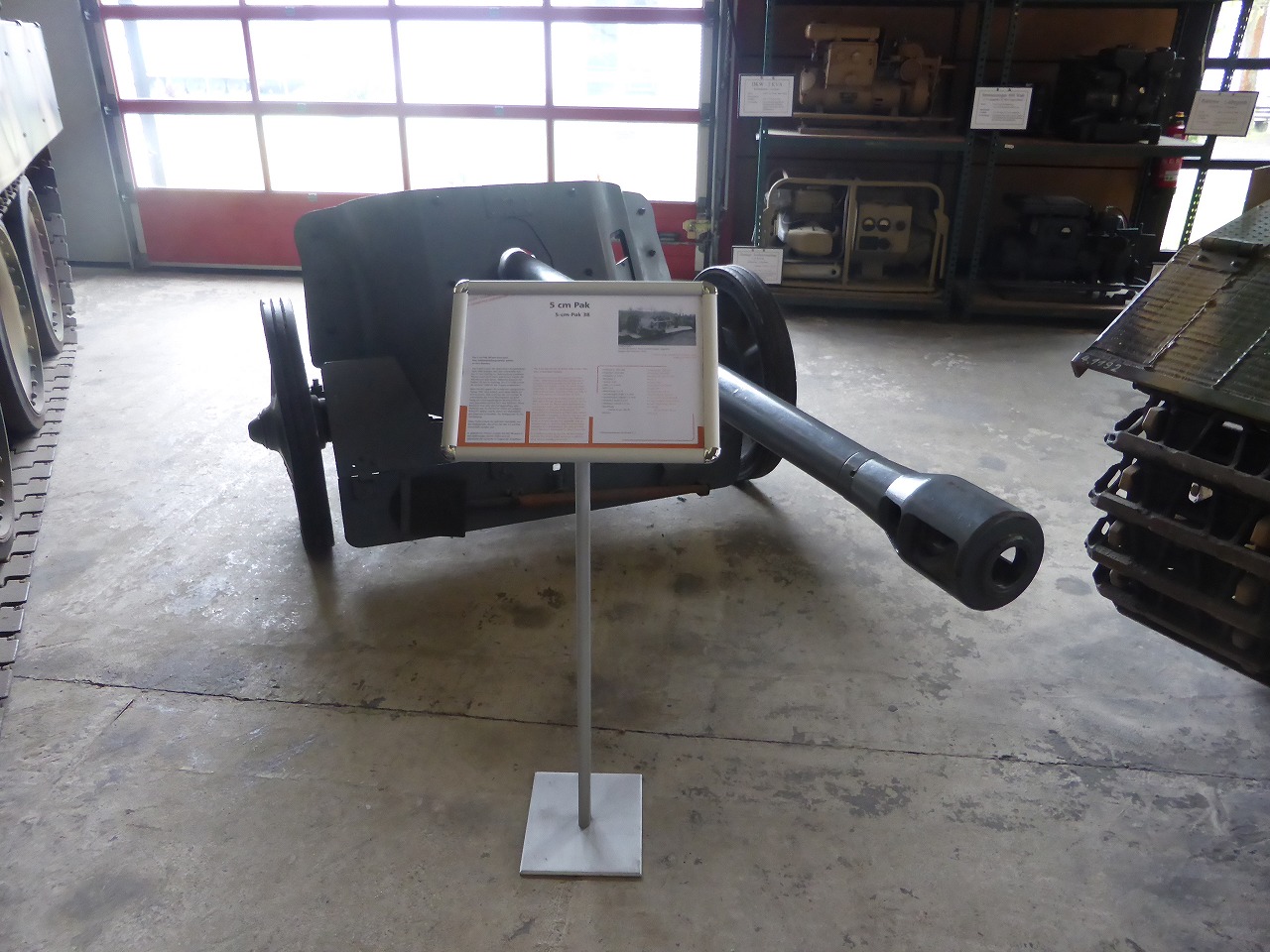 �u50mm�ΐ�ԖCpak38�v �u50mm�ΐ�ԖCpak38�v
50mmPak38�̓h�C�c�̑ΐ�ԖC�ł��B1938�N�Ƀ��C�����^���Ђɂ����37mm�ΐ�ԖC�̌�p�Ƃ��ĊJ������75mm�ΐ�ԂɈ����p����܂����BPak38��1941�N4���ɏ��߂ăh�C�c�R�Ɏg�p����܂����B1941�N�̃o���o���b�T���Ń\�A�R�ƑΛ������ہAPak38��T-34��Ԃ�45mm�̑��b��ł������鐔���Ȃ������̕���̂ЂƂł����B��苭�͂ȖC�ɒu��������ꂽ������̔\�͂ƗL�����̂��镐��Ƃ��ďI�펞�܂Ńh�C�c���h�R�ɗ��p����܂����B
"50mm Pak 38"
The 50mm Pak38 (L/60) was a German anti-tank gun. It was developed in 1938 by Rheinmetall as a successor to the 37 mm Pak 36, and was in turn followed by the 75 mm Pak 40. The Pak 38 was first used by the German forces in April 1941. When the Germans faced Soviet tanks in 1941 during Operation Barbarossa, the Pak 38 was one of the few early guns capable of penetrating the 45mm armor of the T-34. Although it was replaced by more powerful weapons, it remained a potent and useful weapon and remained in service with the Wehrmacht until the end of the war. |
| �@�h�C�c���s Trip to Germany�@Masaki�@ 2015�N5��7��(��) 4:11 |
�C�� |
 �u�X���쒀��ԁ@���N�g�p���^�[�v �u�X���쒀��ԁ@���N�g�p���^�[�v
���N�g�p���^�[�̓i�`�X�h�C�c�ɂ���ĊJ�����ꂽ�p���^�[��Ԃ̃V���V�[�𗘗p�����쒀��Ԃł��B1944�N�Ƃ������㔼�ɐ��ɓ�������A�����A��������ɔz������܂����B���N�g�p���^�[�͔��ɋ��͂ȃe�B�[�K�[�U�^�Ɠ���88mmPak43�J�m���C�ƃp���^�[��Ԃ̌��I�ő�z�������b�Ƒ��������������܂������A���㔼�̃h�C�c�ɂ�����R���i���Y�́A�����e�i���X�́A����̌P���̕s���̉e��������A���ʐ��Y�A��C���i�s���A����̏����s���Ƃ������ʂ������܂����B���N�g�p���^�[�͏d�쒀��ԑ���ɔz������A��ɓ�������Ő킢�܂����B
"Jagdpanther"
The Jagdpanther was a tank destroyer built by Nazi Germany based on the chassis of the Panther tank. It entered service late in the war (1944) and saw service on the Eastern and Western Fronts. The Jagdpanther combined the very powerful 8.8 cm PaK43 cannon of the Tiger II and the characteristically excellent armor and suspension of the Panther chassis, although it suffered from the general poor state of German ordnance production, maintenance and training in the later part of the war, which resulted in small production numbers, shortage in spare parts and poor crew readiness. Jadgpanthers equipped heavy antitank battalions and served mainly on the Eastern Front. |
| �@�h�C�c���s Trip to Germany�@Masaki�@ 2015�N5��7��(��) 4:13 |
�C�� |
 �u7.5cmPaK40/4���ړ����p���O�������ԁi�������j�v �u7.5cmPaK40/4���ړ����p���O�������ԁi�������j�v
���̎ԗ���7.5cm�ΐ�ԖCPak40/1��RSO�̃V���V�[�̓��ڂ������́BRaupenschlepper Ost�i�����L���^�s���[�g���N�^�[���Ӗ��j�͈�ʓI��RSO�Ɨ�����܂��B�S�O�����ԗ��̓\�r�G�g����̍ŏ��̏H�~�ɂ�����D���̒��ł̎ԗ֎��g���b�N��n�[�t�g���b�N�̖R�������s���̉ƍl�����܂����B
"RSO/PaK 40"
This vehicle was equipped with 7.5cm PaK40/1 anti-tank gun on top of an RSO chassis. Raupenschlepper Ost, literally "Caterpillar Tractor East", is more commonly abbreviated to RSO. This fully tracked, lightweight vehicle was conceived in response to the poor performance of wheeled and half-tracked vehicles in the mud and snow during the Wehrmacht's first autumn and winter on the Soviet Front. |
| �@�h�C�c���s Trip to Germany�@Masaki�@ 2015�N5��7��(��) 4:15 |
�C�� |
 �u�V���ˌ��CG�^�E������Y�^�v �u�V���ˌ��CG�^�E������Y�^�v
�V���ˌ��C�͑�2�����ōł��������Y���ꂽ�h�C�c�R�̐퓬�ԗ��ł��B�V����Ԃ̃V���V�[�𗘗p���A�C�����������Œ�퓬���Ƃ�苭�͂ȖC�𓋍ڂ��܂����B�V���ˌ��C�͕����̋ߐڎx�����ړI�����������^�͔b�ԗ���w�n�j��̂���24���a�֒e�C�𓋍ڂ��܂����B�\�A�R��KV-1��T-34��ԂƑ���������A�V���ˌ��C��43���a75mm���˖C�����߂ē��ڂ��i1942�N�t�j�A1942�N�H�ɂ͏�������48���a75mm�C�𓋍ڂ��܂����B����G�^��48���a75mm�C���ڂł��B
"Sturmgeschutz III Ausf. G late version"
The Sturmgeschutz III (StuG III) assault gun was Germany's most produced armoured fighting vehicle during World War II. It was built on the chassis of the proven Panzer III tank, replacing the turret with a fixed casemate and mounting a more powerful gun. As the StuG III was designed to fill an infantry close support combat role, early models were fitted with a low-velocity 75 mm StuK 37 L/24 gun to destroy soft-skin targets and fortifications. After the Germans encountered the Soviet KV-1 and T-34 tanks, the StuG III was first equipped with a high-velocity 75 mm StuK 40 L/43 main gun (Spring 1942) and in Autumn 1942 with the slightly longer 75 mm StuK 40 L/48 gun. This Ausf. G is equipped with 75 mm StuK 40 L/48 gun. |
| �@�h�C�c���s Trip to Germany�@Masaki�@ 2015�N5��7��(��) 4:17 |
�C�� |
 �u�u�����x�A�E������Y�^�v �u�u�����x�A�E������Y�^�v
���̎ԗ��͑�2�����Ŏg��ꂽ�W����Ԃ̃V���V�[�𗘗p���������x����Ԃł��B�N���X�N�A�A���e�B�I�A�m���}���f�B�[�̐킢����V�����I�N�����Ɏg�p����܂����B�A���R�ɂ���Ă����h�C�c�R�͎g�p���Ȃ������u�����x�A�i�h�C�c��̕s���Ɓj�̃j�b�N�l�[���Œm���Ă��܂��B300��������A4�̓Ɨ�����ɔz������܂����B�ŏ���60���̐��Y��1943�N�t�Ɏn�܂��Ă��܂��B�呕����12���a15cm43�^�ˌ��֒e�C�ł����
"Brummbar Late version"
The Sturmpanzer was a German armoured infantry support gun based on the Panzer IV chassis used in the Second World War. It was used at the Battles of Kursk, Anzio, Normandy, and helped to put down the Warsaw Uprising. It was known by the nickname Brummbar (German: "Grouch") by Allied intelligence, a name which was not used by the Germans. Just over 300 vehicles were built and they were assigned to four independent battalions. Production of the first series of 60 vehicles began in April 1943. The main armanent was 15 cm StuH 43 L/12. |
| �@�h�C�c���s Trip to Germany�@Masaki�@ 2015�N5��7��(��) 4:18 |
�C�� |
 �u���F�X�y�v �u���F�X�y�v
���F�X�y�i�h�C�c��̃X�Y���o�`�j�͑�2�����ŊJ���A�g�p���ꂽ�h�C�c�R�����C�ł��B1940�N�̃t�����X��Ńh�C�c�R�̎�͐�ԂƂ��ćU����Ԃ͕s�K�Ȃ��Ƃ����炩�ɂȂ�܂����B�@�B�I�ɂ͌����Ȃ��̂ł������A���������b����͂ł����B�������V���V�[��105mm �y�֒e�C(18/2 L/28)�ɋ@������^������Ɣ��f����܂����B�\�A�R�������ɋ߂Â�����1943�N2������44�N6����676�������Y����܂����B
"Wespe"
The Sd. Kfz. 124 Wespe (German for "wasp") was a German self-propelled artillery vehicle developed and used during the Second World War. In 1940, during the Battle of France, it was apparent that the intermediate tank of the German forces, the Panzer II, was unsuitable as a main battle tank. Though mechanically sound, it was both under-gunned and under-armoured. The chassis, however, proved servicable for providing mobility to the 10.5 cm field howitzer. The Wespe was in production from February 1943 until June 1944 when Soviet forces approached the frontier. By that time, 676 had been produced. |
| �@�h�C�c���s Trip to Germany�@Masaki�@ 2015�N5��7��(��) 4:19 |
�C�� |
 �u�t�������v �u�t�������v
�t�������i�h�C�c��̃}���n�i�o�`�j�͇V/�W����Ԃ̎ԑ̂𗘗p��15cm�֒e�C�𓋍ڂ��������C�ł��B��2����풆��1943�N��������I��܂Ńh�C�c���h�R�Ɏg�p����܂����B�t�������͎ԗ�����ɏ���ƞ֒e�C�������ރI�[�v���g�v�^�̌y���b�̐퓬�������ڂ���܂����B�G���W���͂��̐퓬������邽�ߌ���Ɉڂ���܂����B�I��܂ł�714�������Y����܂����B
"Hummel"
Hummel (German: "bumblebee") was a self-propelled artillery gun based on the Geschutzwagen III/IV chassis, armed with a 15 cm howitzer. It was used by the German Wehrmacht during the Second World War from early 1943 until the end of the war. The Hummel had an open-topped lightly armoured fighting compartment at the back of the vehicle which housed both the howitzer and the crew. The engine was moved to the centre of the vehicle to make room for this compartment. By the end of the war 714 Hummel had been built. |
| �@�h�C�c���s Trip to Germany�@Masaki�@ 2015�N5��7��(��) 4:21 |
�C�� |
 �u8�֑��b��Sd Kfz 234/4�v �u8�֑��b��Sd Kfz 234/4�v
���̎ԗ��͑�2����풆�A�h�C�c�ŊJ���A���Y���ꂽ���b�ԃV���[�Y�ł��B���̃V���[�Y�͌y���b�Ԃ�20,50�܂���75mm�𓋍ڂ��A�^�g��12�C���f�B�[�[���G���W����ς�ł��܂����B����4�^�͍ŏI�^��46���a75mm�ΐ�ԖCPak40�𓋍ڂ��܂����B���̑g�ݍ��킹�͓��ΐ�ԖC�ɍX�Ȃ�@������^���܂������A�V���V�[�͌��E�܂ʼn�������X�y�[�X�̕s������e��͌���ꂽ���ʁi12���j�����A���ڂł��܂���ł����B���̌^��1944�N��������45�N�̐푈�I���܂Ő��Y����܂����B
"SdKfz 234/4"
The Sd.Kfz. 234 was a family of armoured cars designed and built in Germany during World War II. The vehicles were lightly armoured, armed with a 20, 50 or 75 mm main gun, and powered by a Tatra V12 diesel engine. The Sd.Kfz. 234/4 was produced for the final variant, and it was armced with the 7.5cm L/46 PaK 40. This was yet another attempt to increase the mobility of this anti-tank gun, however the 234 chassis was stretched to its limits, and it carried limited ammunition (twelve rounds) due to lack of storage space. This variant was manufactured from the end of 1944 to the end of hostilities in 1945. |
| �@�h�C�c���s Trip to Germany�@Masaki�@ 2015�N5��7��(��) 4:21 |
�C�� |
 �u3t�n�[�t�g���b�N Sd.Kfz.11/2�v �u3t�n�[�t�g���b�N Sd.Kfz.11/2�v
���̎ԗ��͑�2�����ōL���g��ꂽ�h�C�c�R�n�[�t�g���b�N�ł��B��Ȗ�����3.7cm��C����10.5cm�֒e�C�܂ł̒��^�C�̌����ł����B�C��g���C���[�̌����Ƌ���8�l�̐l�����^�ׂ܂����B�V���V�[�͊�{�I�Ƀn�m�}�[�O�n�[�t�g���b�N�̂��̂𗘗p���Ă��܂��B1938�N����45�N�ɂ��悻9000�������Y�����풆�ɑ�ʐ��Y���ꂽ�R�p�ԗ��̂ЂƂł��B�|�[�����h�N�U�Ɏn�܂�A�����A�����A�A�t���J�A�C�^���A�����Ă̐���ɔz������܂����B�����70kg�̎U�z����������w��p���ԗ��ŁA8�ʂ̐�����^�ׂ�X�y�[�X�������2�^�ł��B����ł͎g�p����Ă��܂���B
"Sd.Kfz.11/2"
The Sd.Kfz. 11 was a German half-track that saw very widespread use in World War II. Its main role was as a prime mover for medium towed guns ranging from the 3.7 cm FlaK 43 anti-aircraft gun up to the 10.5 cm leFH 18 field howitzer. It could carry eight troops in addition to towing a gun or trailer. The chassis formed the basis for the Sd.Kfz. 251 medium armored personnel carrier. Approximately 9,000 were produced between 1938 and 1945, making it one of the more numerous German tactical vehicles of the war. It participated in the Invasion of Poland, the Battle of France, the Balkans Campaign and fought on both the Western Front and the Eastern Front, in North Africa and in Italy. This is the Sd.Kfz. 11/2 and it was a chemical decontamination vehicle fitted with a 70 kg capacity spreader and space for eight barrels of decontamination chemicals. This left room for only three crewmen. This type wasn't in action. |
| �@�h�C�c���s Trip to Germany�@Masaki�@ 2015�N5��7��(��) 4:40 |
�C�� |
 �u�V���g�����e�B�[�K�[�v �u�V���g�����e�B�[�K�[�v
���̎ԗ��͑�2�����ɂ�����h�C�c�R���e�B�[�K�[�T�^�̎ԑ̂𗘗p���Đ��Y�����ˌ��C�ő���a���P�b�g�����`���[�����Ă��܂����B���̎�ȖړI�͎s�X��ɂ�����d�Ί�ɂ������x���ł����B19�������Y����A�����V�����I�N�A�o���W�̐킢�A���C����̐킢�Ŏg�p����܂����B���̎ԗ��͗l�X�Ȕ�������̂ŌĂ�܂������A���̒��Łu�V���g�����e�B�[�K�[�v���ł��L���ƂȂ�܂����B�啐���͖C�����U����380mm61�����P�b�g�P�C�ŁA�Z�������炨�悻1.5m�̃��P�b�g���i���C�e�˂��܂����B
"Sturmtiger"
Sturmtiger was a World War II German assault gun built on the Tiger I chassis and armed with a large rocket launcher. Its primary task was to provide heavy fire support for infantry units fighting in urban areas. The 19 vehicles produced fought in the Warsaw Uprising, the Battle of the Bulge and the Battle of the Reichswald. The fighting vehicle is also known under a large number of informal names, among which the Sturmtiger became the most popular. The main armament was the 380 mm Raketen-Werfer 61 L/5.4, a breech-loading rocket launcher, which fired short-range, rocket-propelled projectiles roughly 1.5 m long. |
| �@�h�C�c���s Trip to Germany�@Masaki�@ 2015�N5��7��(��) 4:41 |
�C�� |
 �u�Y����ԃe�B�[�K�[�U�^�v �u�Y����ԃe�B�[�K�[�U�^�v
�e�B�[�K�[�U�͑�2�����̃h�C�c�d��Ԃ̒ʏ̂ł��B�������Konigstiger(�h�C�c��Ńx���K���Ձj�ƌĂ�Ă��܂������A�������m�ɃL���O�^�C�K�[��C�����^�C�K�[�Ƃ����Ό�ǂ���܂����B�^�C�K�[�U�͇T�̌�p�҂ŇT�^�̌������b�ƃp���^�[�Ŏg��ꂽ�X�Α��b�̍��̂ł����B�ԗ��d�ʂ�80t�ɒB���A�O�ʑ��b��100-180mm����A���C�g71���a88mm��ԖC�����Ă��܂����B�e�B�[�K�[�U�͗��R�ƕ���SS�œƗ��d��ԑ����Ґ����܂����B�e�B�[�K�[�U�̐��Y�͘A�����̔����ł��܂��i�܂��A1943�N����45�N�ł��悻1000���݂̂����Y����܂������A���̌������b�Ƌ��͂ȑ����͐��ʂ���킢����Ă鐼���A������\�A�R�̐�Ԃɑ����|�I�ȗD�ʐ��������Ă��܂����B
"Tiger II"
Tiger II is the common name of a German heavy tank of the Second World War. It is also known under the informal name Konigstiger (the German name for "Bengal tiger"), often mistranslated literally as King Tiger or Royal Tiger by Allied soldiers. The Tiger II was the successor to the Tiger I, combining the latter's thick armor with the armor sloping used on the Panther medium tank. The tank weighed almost seventy metric tons, and was protected by 100 to 180 mm of armor to the front. It was armed with the long barreled 8.8 cm KwK 43 L/71 gun. The Tiger II was issued to heavy tank battalions of the Army and the Waffen-SS. Tiger II production was severely disrupted by Allied bombing. Around only 1000 units were produced between 1943 and 1945. The heavy armor and powerful long-range gun gave the Tiger II an advantage against all opposing Western Allied and Soviet tanks attempting to engage it from head on. |
| �@�h�C�c���s Trip to Germany�@Masaki�@ 2015�N5��7��(��) 4:42 |
�C�� |
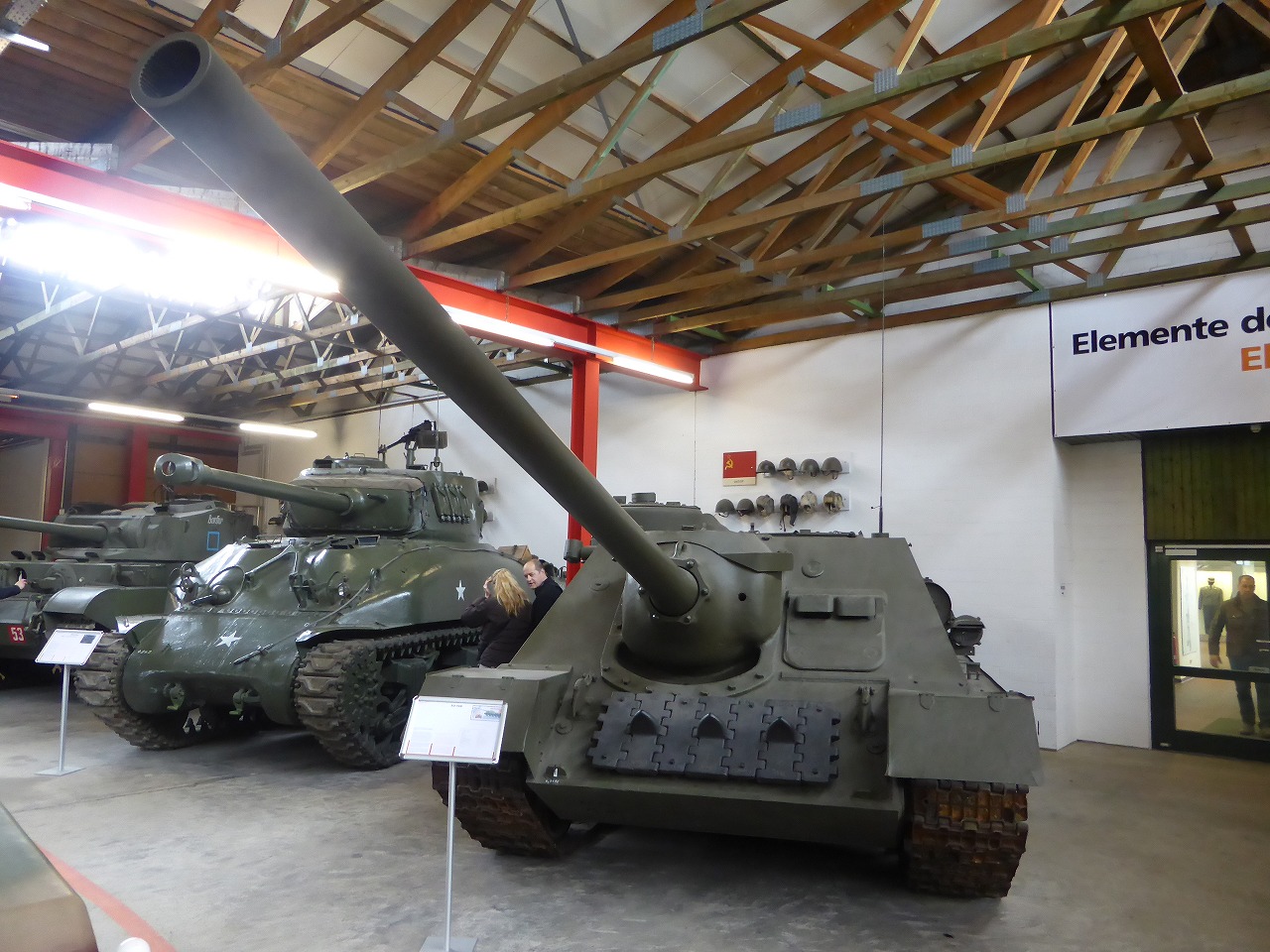 �u���V�A�@SU-100�P���C�v �u���V�A�@SU-100�P���C�v
SU-100�̓\�A�R�̋��͂�100mm�ΐ�ԖC�������Œ�C���^�̋쒀��Ԃł��B��2�����̍ŏI�N�ɍL�͈͂Ŏg���A�����\�A�����R�̒��ʼn��N�����ɏo�����܂����B�\�A�R���o���g���Ńh�C�c�R�̏t�̂߂��ߍ���ł���������1945�N3�������ʂɎg���n�߂܂����B1945�N7���܂ł�2335�������Y����܂����B
"SU-100"
The SU-100 was a Soviet casemate-style tank destroyer armed with a powerful 100mm anti-tank gun. It was used extensively during the last year of World War II and saw service for many years afterwards with the armies of Soviet allies around the world. It was used en masse in Hungary in March 1945, when Soviet forces defeated the German Operation Fruhlingserwachen offensive at Lake Balaton. By July 1945, 2,335 SU-100s had been built. |
| �@�h�C�c���s Trip to Germany�@Masaki�@ 2015�N5��7��(��) 4:43 |
�C�� |
 �u�A�����J�@M-4/A-1 76mm�C���ڃV���[�}����ԁv �u�A�����J�@M-4/A-1 76mm�C���ڃV���[�}����ԁv
M4�A�����ɂ͒����M4�͑�2�����ŃA�����J�R�y�ё��̐����A�����ɍł������g��ꂽ��Ԃł��B�M�����Ƌ@�����͊m���ł����B�푈����̃h�C�c�R���A�d��Ԃɑ��Ă͔�͂ł������A���Y�R�X�g��������ʐ��Y���\�ł����B���痼���̎ԗ��������h�E���[�X�@�ɂ��p�A�M������\�A�R�ɋ�������܂����B��ɉp�R�ɂ���k�푈�̃V���[�}�����R�̖��O���t�����܂����BM4�͕č����̑����̍H��Ő��Y���ꂽ���߁A�����̎�ނ̌^������50000���ȏオ���Y����܂����B�����76mm�CM1�𓋍ڂ���A1�^�ł��B44�N����45�N�ɂ̓h�C�c�d��Ԃɑ��Ă͔�͂ł������A��ʂ̐퓬�����@�Ƒΐ�ԖC�̎x�����킢�����邱�Ƃ��ł��܂����B
M4A1(76)W Sherman
The M4 Sherman, officially Medium Tank, M4, was the most numerous battle tank used by the United States and some other Western Allies in World War II. It proved to be reliable and mobile. In spite of being outclassed by German medium and heavy tanks late in the war, the M4 Sherman was cheaper to produce and available in greater numbers. Thousands were distributed through the Lend-Lease program to the British Commonwealth and Soviet Union. The tank was named after the American Civil War General William Tecumseh Sherman by the British. M4 has a lot of kind of types because they were built in manu plants in the Uneted States. Over 50,000 units were built. This tank is M4A1 ane equipped with 76mm gun M1. By 1944 and 1945, the M4 was inferior to German heavy tanks but was able to fight on with support from growing numbers of fighter-bombers and artillery pieces. |
| �@�h�C�c���s Trip to Germany�@Masaki�@ 2015�N5��7��(��) 4:43 |
�C�� |
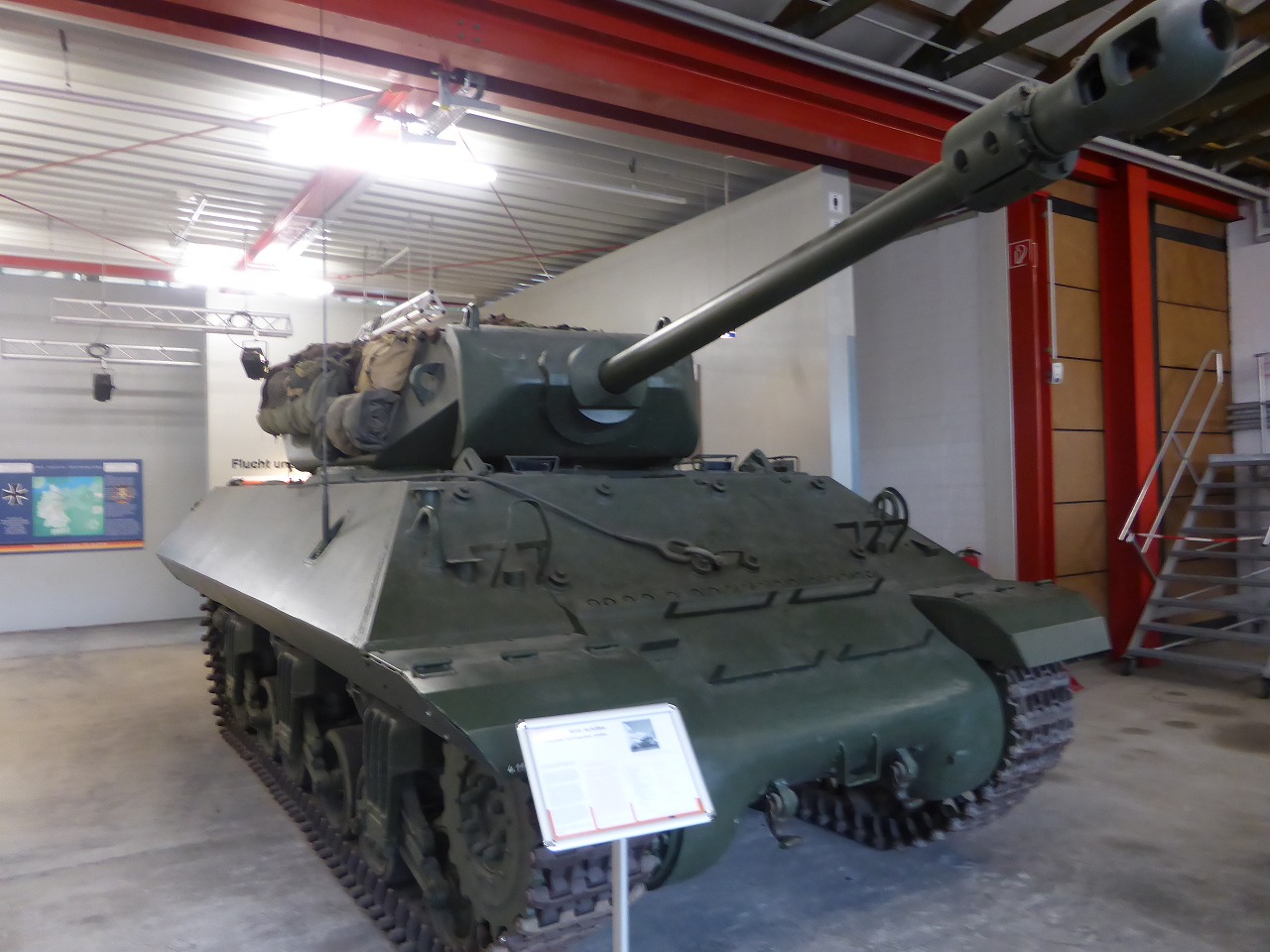 �u�A�����J�@M-10�쒀��ԁv �u�A�����J�@M-10�쒀��ԁv
M-10��M4�V���[�}���̃V���V�[��3�C���`(76.2mm�jM7�C�𓋍ڂ����A�����J�R�̋쒀��Ԃł��B�����ɂ�3�C���`�����CM10�Ő��̏�ł͕ČR�̎�͋쒀��Ԃł���A�K�x�ɔ\�͂̂���ΐ�ԕ���Ɖ�]�C���̌����ł����B�����Ƌ��͂ȑ��Ԃ̏o���ȍ~���I��܂Ő��Ŏg���܂����B���ہA���Ԃ̈ꕔ��M10�̉����������̓��r���g�ł����B�p�R�ɂ���āu�E���u�����i�N�Y���j�v�Ɩ��t�����܂������AM4�V���[�}���̂悤�ȑ��ԗ��ƈقȂ�A�ČR���m�ɍ̗p����邱�ƂȂ��A�������̈ȏ�ɒP��TD�i��ʓI�ȋ쒀��Ԃ̈��́j�ƌĂ�܂����B1942�N����43�N��6706�������Y����܂����B
"M10 tank destroyer"
The M10 tank destroyer was a United States tank destroyer of World War II based on the chassis of the M4 Sherman tank fitted with the 3-inch (76.2 mm) Gun M7. Formally 3-inch Gun Motor Carriage, M10, it was numerically the most important U.S. tank destroyer of World War II and combined a reasonably potent anti-tank weapon with a turreted platform. Despite the introduction of more-powerful types as replacements, it remained in service until the end of the war. Some of those replacements were in fact modified and/or rebuilt from the M10 itself. It was christened the Wolverine by the British, although unlike other vehicle names such as the M4 Sherman, the name was not adopted by American soldiers, who called it TD (a nickname for any tank destroyer in general) beyond its formal designation. 6,706 units were built during 1942-1943. |
| �@�h�C�c���s Trip to Germany�@Masaki�@ 2015�N5��7��(��) 4:45 |
�C�� |
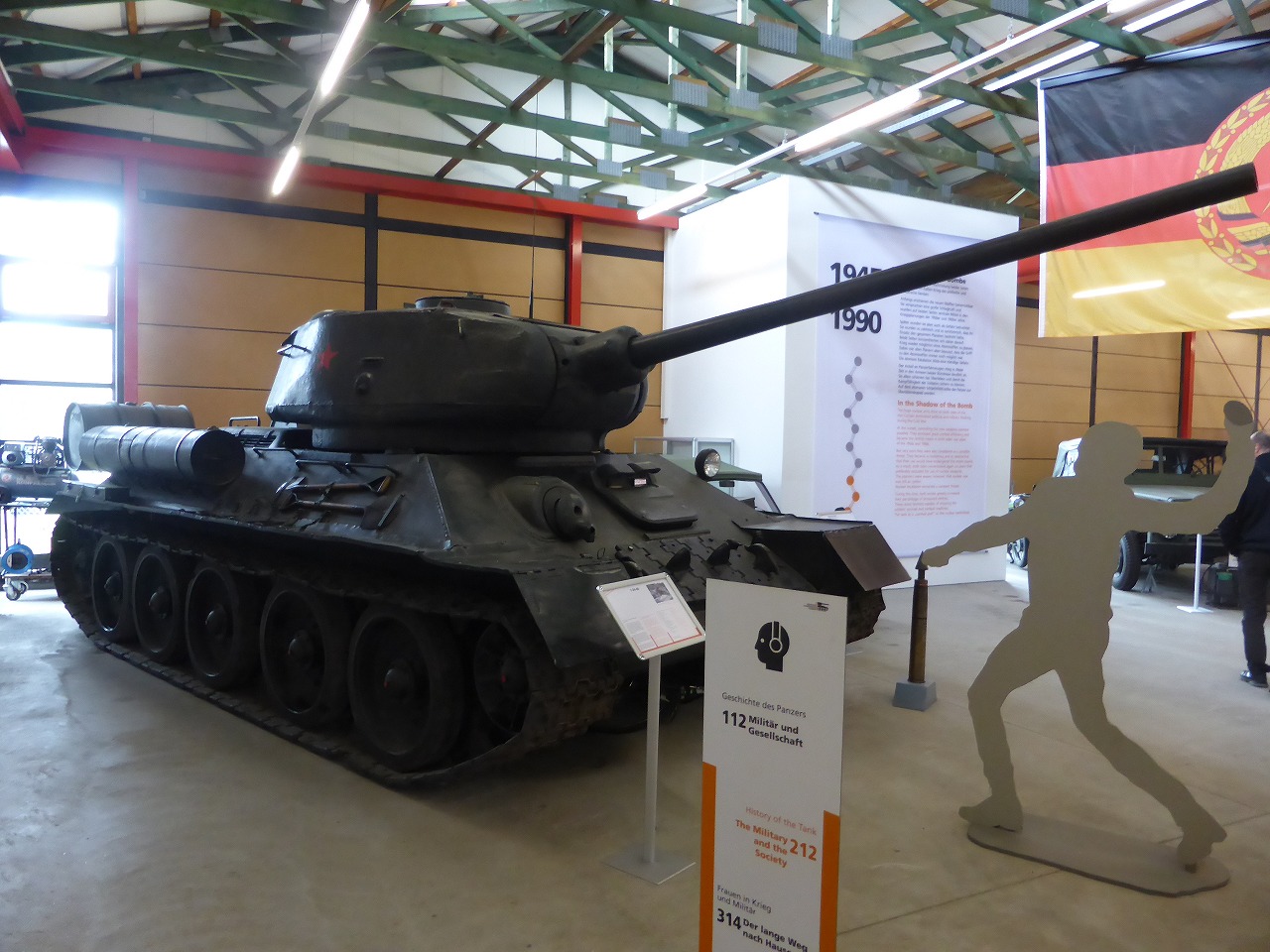 �u���V�A�@T-34/85�v �u���V�A�@T-34/85�v
T-34�̃V���V�[��85mm�CS-35��ς�T-34/85�͒��C�g75mm�C�𓋍ڂ����W����Ԃւ̑R��ł����B���̐�Ԃ͐ԌR�ɇW����Ԃ�V���ˌ��C�ɑ�����@�����Ƒ��b��^���܂������A�p���^�[��e�B�[�K�[�ɂ͑R�ł��܂���ł����B����ł��ȑO�̌^�ɔ�ׂ�p���^�[��e�B�[�K�[�ɂ����ʓI�ȉΗ͂������Ă��܂����B�ŏI�I�ȖC��800m����e�B�[�K�[�T�̎ԑ̑��ʑ��b���A600m����C�����ʑ��b��ł������܂������A�키�ɂ͕s�\���ł����B�e�B�[�K�[�T��1500-2000m����T-34��j�邱�Ƃ��\�ł����B�푈�S���Ԃɂ�����T-34/85�݂̂̐��Y����22559���ɒB���܂����B
"T-34/85"
T-34/85, equipped with a 85mm S-53 gun on the chassis of T-34 tank, was a countermeasure to German Panzer IVs with the high-velocity 75 mm (2.95 in) gun. The T-34/85 gave the Red Army a tank with better armour and mobility than the German Panzer IV tank and StuG III assault gun, though it could not match the armour or weapons of the Panther or Tiger tanks. However, its improved firepower made it much more effective against Panthers and Tigers than earlier models. The resulting tank gun could penetrate the side armour of the Tiger I from a distance of 800 meters and the turret side from a distance of 600 meters. It was still not enough to match the Tiger, as a Tiger could destroy the T-34 from a distance of 1,500 to 2,000 meters, In the entire war, production figures for the T-34/85 alone reached 22,559. |
| �@�h�C�c���s Trip to Germany�@Masaki�@ 2015�N5��7��(��) 4:46 |
�C�� |
 �}�q�[�ƃ��[���[����ԂƎʐ^���B��Ă�������B �}�q�[�ƃ��[���[����ԂƎʐ^���B��Ă�������B
Also Muffy and Molly were in high spirits because they could take a picture with tanks. |
| �@�h�C�c���s Trip to Germany�@Masaki�@ 2015�N5��7��(��) 4:47 |
�C�� |
 ����h�C�c��Ԃ̓W���R�[�i�[������܂��B ����h�C�c��Ԃ̓W���R�[�i�[������܂��B
There is also a display corner of the present German tanks. |
| �@�h�C�c���s Trip to Germany�@Masaki�@ 2015�N5��7��(��) 4:47 |
�C�� |
 ���ꗿ��7���[���B ���ꗿ��7���[���B
The entrance fee is 7 euro. |
| �@�h�C�c���s Trip to Germany�@Masaki�@ 2015�N5��7��(��) 4:49 |
�C�� |
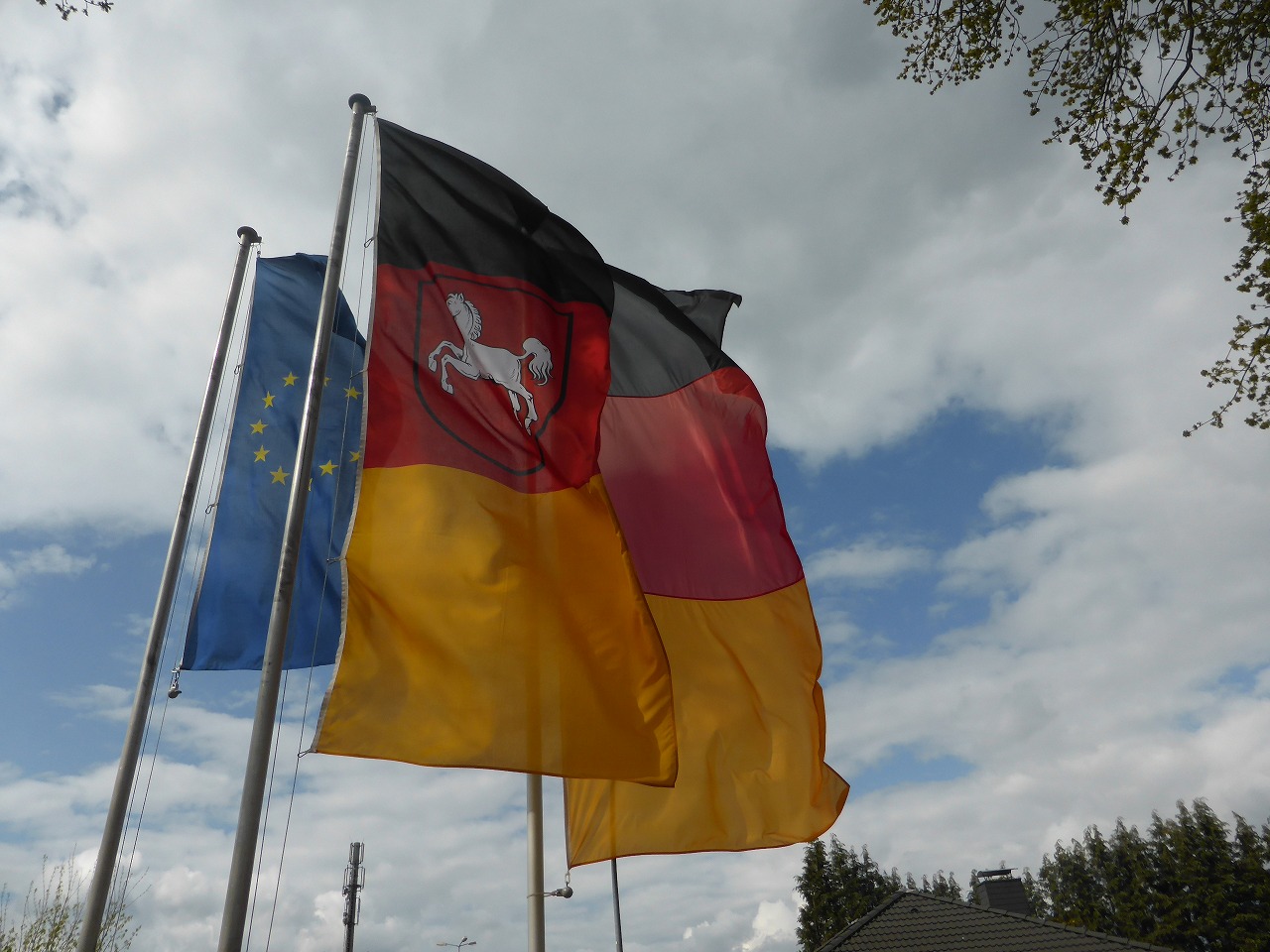 �喞���̔����قł����B �喞���̔����قł����B
I was satisfied with this museum very much. |
| �@�h�C�c���s�E�n���u���O Trip to Germany/Hamburg�@Junko�@ 2015�N5��12��(��) 18:37 |
�C�� |
 �R�I�^�����������Ƃ���Ńh�C�c�ő�̍`�p�s�s�u�n���u���O�v�Ɉړ��B�z�e���Ƀ`�F�b�N�C�����ĊX�����ɏo���B �R�I�^�����������Ƃ���Ńh�C�c�ő�̍`�p�s�s�u�n���u���O�v�Ɉړ��B�z�e���Ƀ`�F�b�N�C�����ĊX�����ɏo���B
After a military geek was satisfied, we moved to "Hamburg", the biggest port city in Germany. We checked in the hotel and started on a town walk. |
| �@�h�C�c���s�E�n���u���O Trip to Germany/Hamburg�@Junko�@ 2015�N5��12��(��) 18:39 |
�C�� |
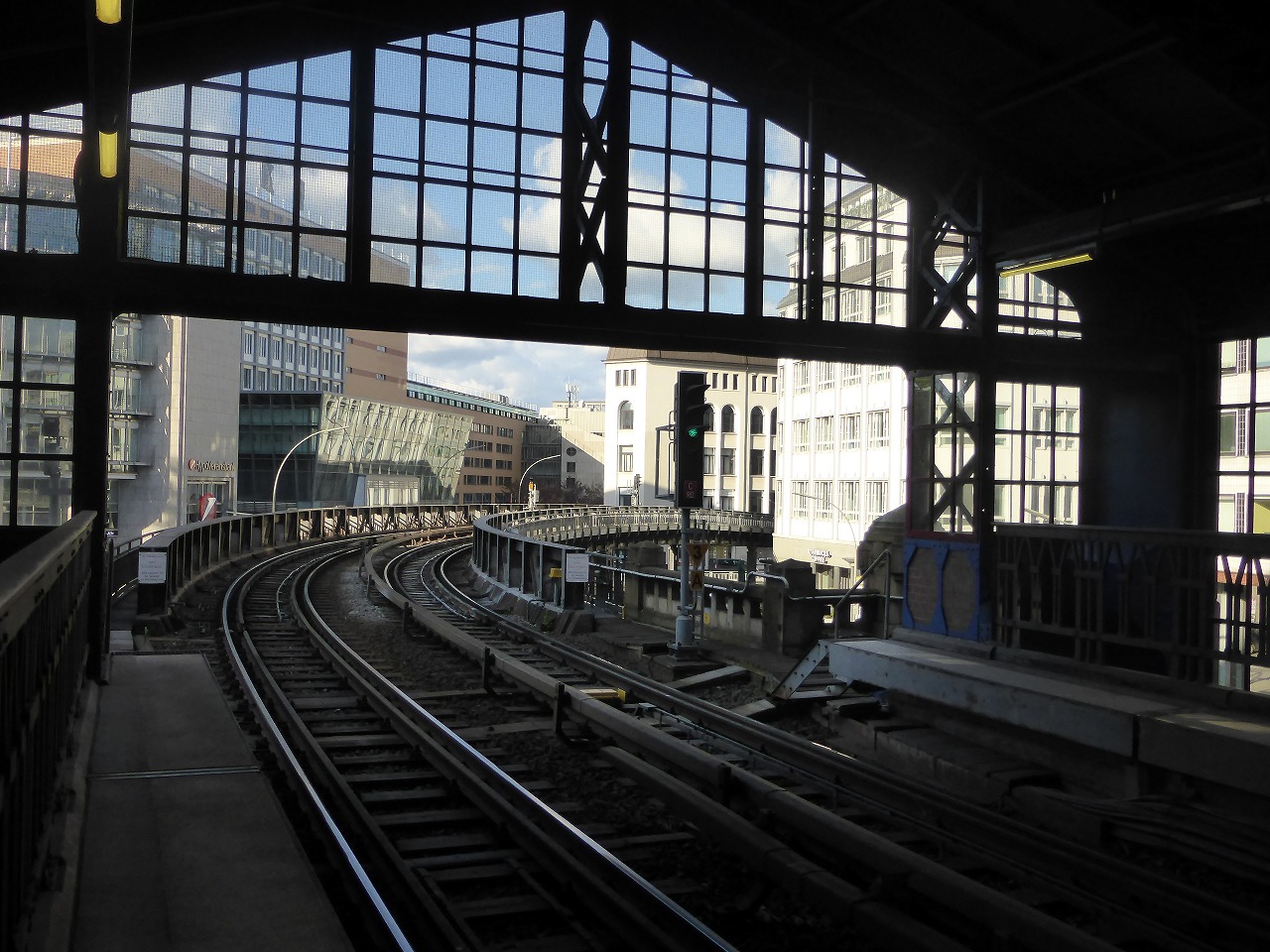 �uS�o�[���v�ɏ���Ē��S�X�܂ŏo�܂��B �uS�o�[���v�ɏ���Ē��S�X�܂ŏo�܂��B
We went to the center of the city by the S-barn. |
| �@�h�C�c���s�E�n���u���O Trip to Germany/Hamburg�@Junko�@ 2015�N5��12��(��) 18:58 |
�C�� |
 �u���~�q���G������v�������r���ɏo�����������B�ޏ���Zitronenjette�ƌĂ�Ă���Henriette Johanne Marie Muller�i1841�N7��18�����܂�A1916�N7��8���v�j�ł��BDessau�Ő��܂��19���I�̍Ō��20�N���������i�h�C�c���Zitronen�j�����Ӄp�u�Ŕ����Đ����Ă��܂����B�ޏ����������鎞�̗L���Ȍ��������uZitroon! Zitroon!�v�ł��B�[���Ɛ��_�a�̂��߁A1894�N8���ɔޏ���Friedrichsberg�ی�{�݂ɑ����܂����B�݂�Ȃ��w���������Ă����̂łȂ������킩��Ȃ��������Ǔ����悤�ɐG���Ă݂܂����B �u���~�q���G������v�������r���ɏo�����������B�ޏ���Zitronenjette�ƌĂ�Ă���Henriette Johanne Marie Muller�i1841�N7��18�����܂�A1916�N7��8���v�j�ł��BDessau�Ő��܂��19���I�̍Ō��20�N���������i�h�C�c���Zitronen�j�����Ӄp�u�Ŕ����Đ����Ă��܂����B�ޏ����������鎞�̗L���Ȍ��������uZitroon! Zitroon!�v�ł��B�[���Ɛ��_�a�̂��߁A1894�N8���ɔޏ���Friedrichsberg�ی�{�݂ɑ����܂����B�݂�Ȃ��w���������Ă����̂łȂ������킩��Ȃ��������Ǔ����悤�ɐG���Ă݂܂����B
We met an old lady on the way to "St. Michael's Church". She was Henriette Johanne Marie Muller, called the Zitronenjette, (18 July 1841 - 8 July 1916). Born in Dessau, Muller made a living in the last two decades of the nineteenth century by selling lemons (in German Zitronen) during the day and at nights in the pubs. Her famous call while she sold the lemons was Zitroon! Zitroon!. Due to drunkenness and mental illness, in August 1894 she was sent to the Friedrichsberg asylum. Although we didn't know why everyone touched the top of her finger, we did same thing like others. |
| �@�h�C�c���s�E�n���u���O Trip to Germany/Hamburg�@Junko�@ 2015�N5��12��(��) 19:00 |
�C�� |
 �u���~�q���G������v �u���~�q���G������v
���̋���́A�J�\���b�N����Ƃ��Č��Ă���ɏ@�����v�̍ۂɃv���e�X�^���g����ɕύX���ꂽ���̑����̃n���u���O�̋���ƈႢ�A�ŏ�����v���e�X�^���g����Ƃ��Č��z����܂����B��V�g�~�J�G���ɕ�[����Ă��܂��B
"St. Michael's Church"
The church was purposely built Protestant unlike many other Hamburg churches which were originally built by Roman Catholics and were converted to Protestantism during the Reformation. It is dedicated to the Archangel Michael. |
| �@�h�C�c���s�E�n���u���O Trip to Germany/Hamburg�@Junko�@ 2015�N5��12��(��) 19:03 |
�C�� |
 �u���~�q���G������v���w�B �u���~�q���G������v���w�B
�n���߂Ȋ����ł��B���݂̋���͂��̏ꏊ�Ɍ��Ă�ꂽ���̂Ƃ��Ă�3�Ԗڂł��B�ŏ��̂��̂�1647�N����1669�N�Ɍ��Ă��A1750�N3��10���̗����Ŕj��܂����B�I���W�i���̋���͕������ꐢ�E����9�̊X�Ɍ��Ă��܂����B1786�N�A�V��������������A���ꂪ������������̂ł��B���̋����20���I��2��Č�����܂����B���ݒ���1906�N�ɂ�����Ύ��̌��1944�N��45�N�̋�P�̌�ł��B
The chancel of "St. Michael's Church"
I felt it simply. The present church building is the third one at this site. The first one was built from 1647 to 1669. That church was destroyed on March 10, 1750, by a lightning strike. The original church has been replicated and built in 9 different cities around the world. In 1786, a new construction was completed. This is the church as we know it today. It was reconstructed twice in the 20th century: after catching fire in 1906 during construction work and after the bombings of 1944 and 1945.
|
| �@�h�C�c���s�E�n���u���O Trip to Germany/Hamburg�@Junko�@ 2015�N5��12��(��) 19:06 |
�C�� |
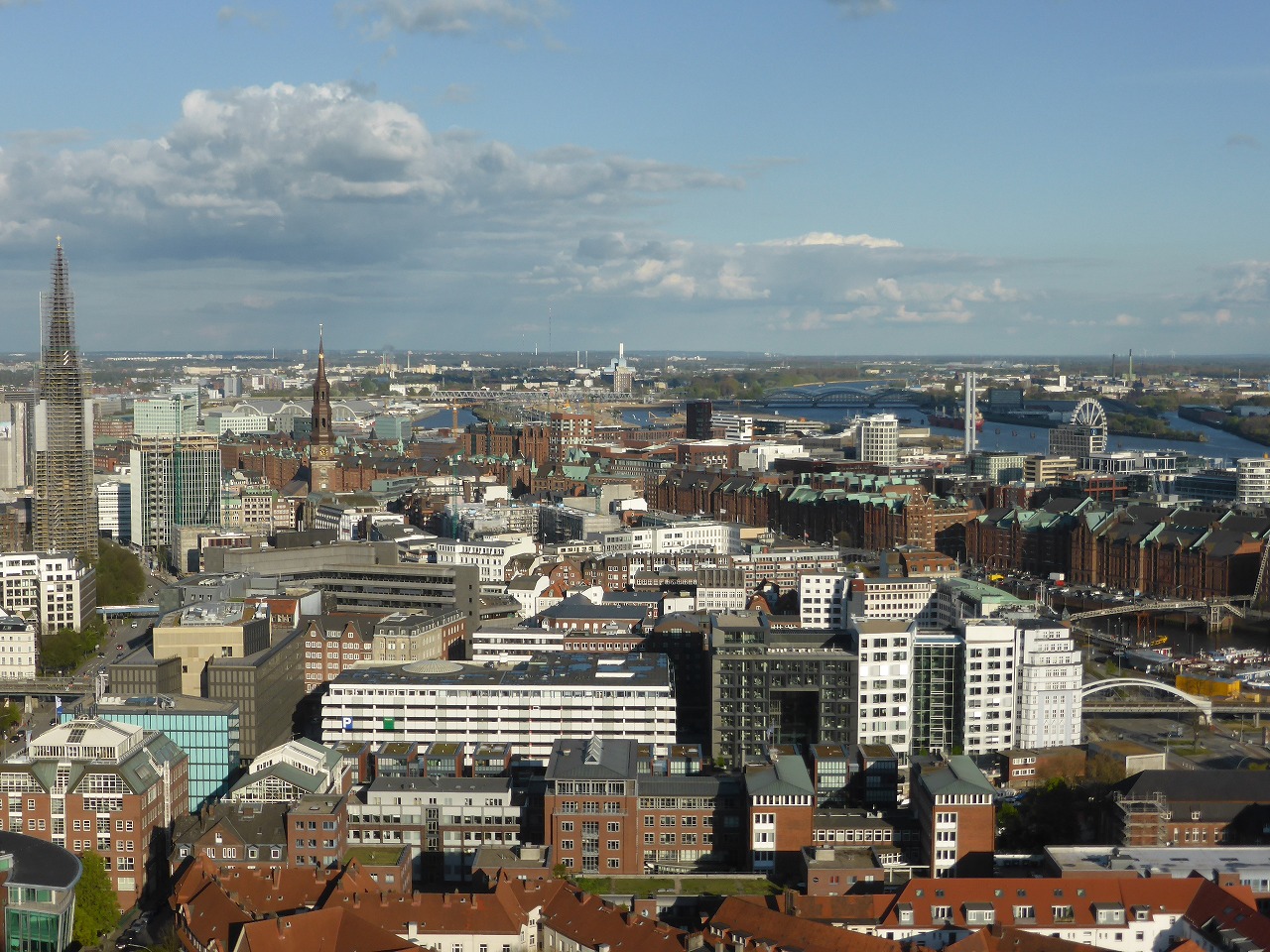 �u���~�q���G������v�̓��ɏ��܂����B�q�ɌQ���ʁB �u���~�q���G������v�̓��ɏ��܂����B�q�ɌQ���ʁB
We climbed the tower of "St. Michael's Church". It was a direction to The Speicherstadt (lit. city of warehouses, meaning warehouse district). |
| �@�h�C�c���s�E�n���u���O Trip to Germany/Hamburg�@Junko�@ 2015�N5��12��(��) 19:07 |
�C�� |
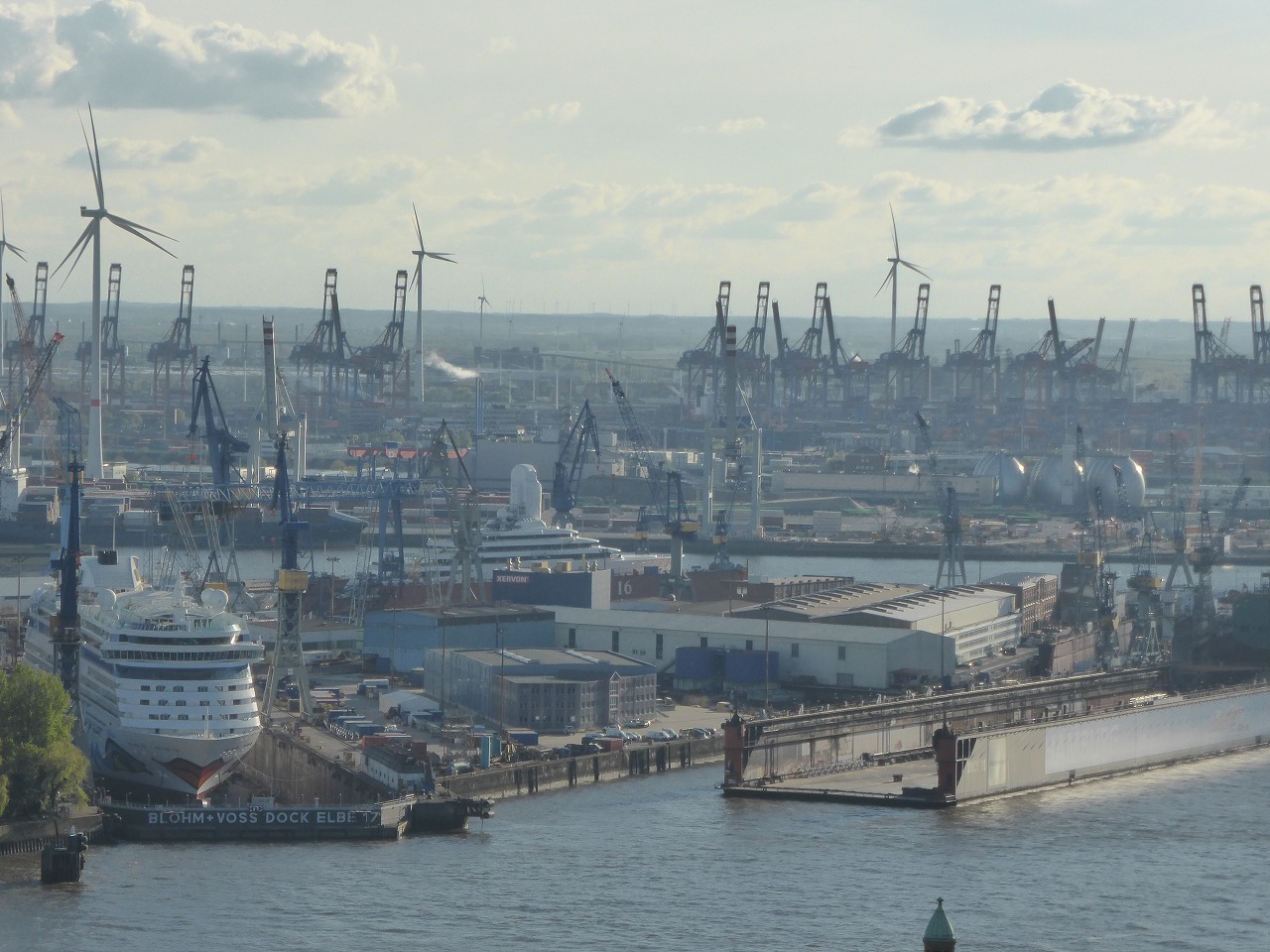 �u���~�q���G������v�̓��̏ォ��B�`�p�s�s�炵�����i�ł��B �u���~�q���G������v�̓��̏ォ��B�`�p�s�s�炵�����i�ł��B
from the tower of "St. Michael's Church". It was a scenery appropriate for the harbor city |
| �@�h�C�c���s�E�n���u���O Trip to Germany/Hamburg�@Junko�@ 2015�N5��12��(��) 19:17 |
�C�� |
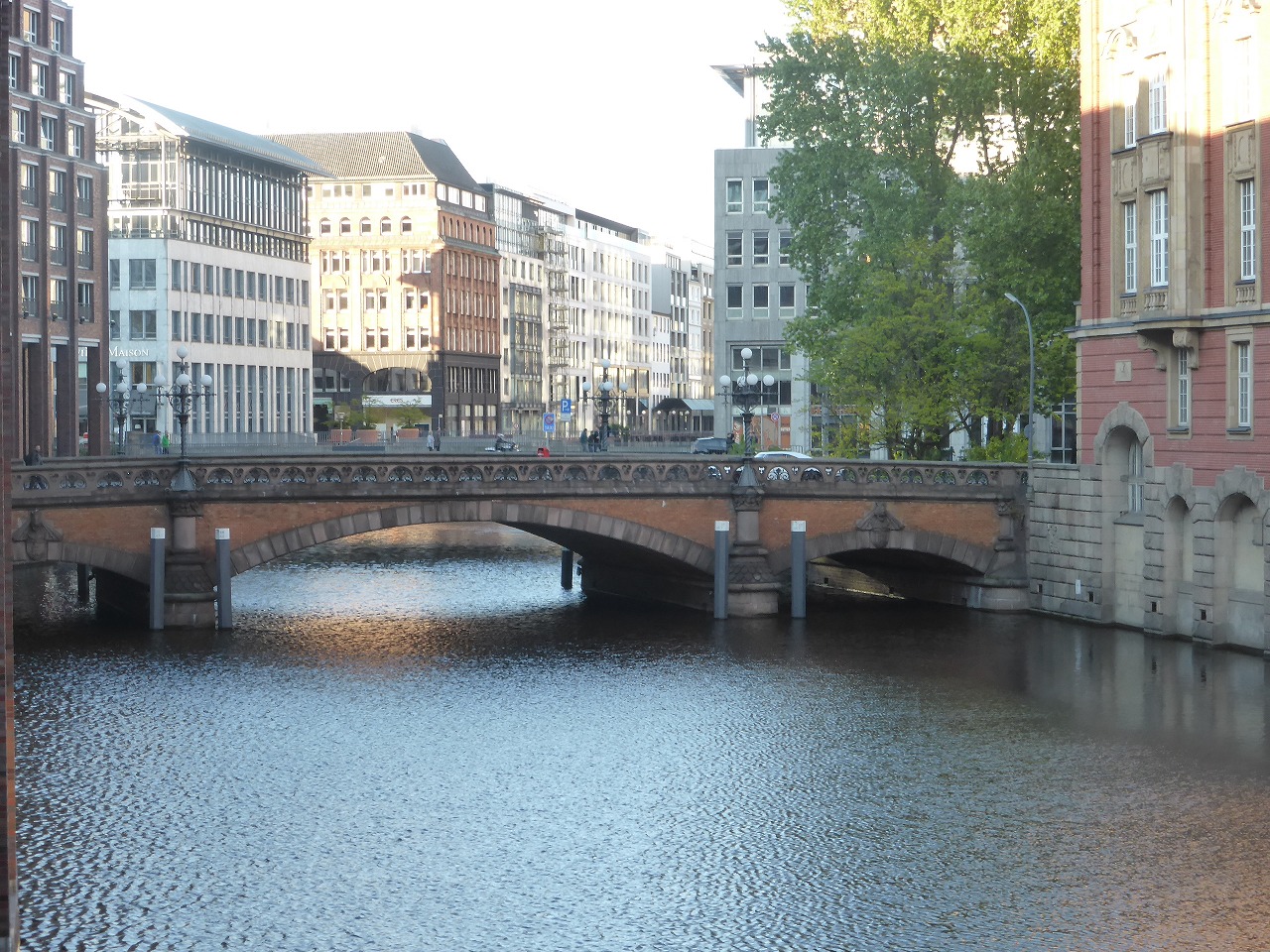 �X���̉^�́B �X���̉^�́B
���̌i�ς̓��F�̂ЂƂ��^�͂ɂ����鋴�ł��B�^�͂̒��Ƃ��ėL���ȃA���X�e���_���E���F�l�`�A�����킹�����������̋������邻���ł��B
Canal in the city.
One of the characteristic of the cityscape is a bridge over a canal. I heard there are more bridges than the total number of Amsterdam and Venice which are famous for the city of canals. |
| �@�h�C�c���s�E�n���u���O Trip to Germany/Hamburg�@Junko�@ 2015�N5��12��(��) 19:19 |
�C�� |
 �u�s���Ɂv �u�s���Ɂv
�s���ɂɂ͌��X�̐��{�@�\��ŏ��̎s���̕����Ƌ��Ƀn���u���O�B�c��A��@�̋c����������܂��B�ƂĂ����ꂢ�ł����[�B���s���ɂ�1842�N�ɑ�Ŕj��Ă���Č��J�n�܂�44�N�������Ă��܂��B1886�N�Ɍ��݂��J�n����A1897�N�Ɏg�p�J�n����Ă��܂��B
"Hamburg Rathaus"
The city hall still houses its original governmental functions with the office of the First Mayor of Hamburg and the meeting rooms for Hamburg's parliament and senate (the city's executive). It was very beautiful. After the old city hall was destroyed in the great fire of 1842, it took almost 44 years to build a new one. Construction started in 1886 and the new city hall was inaugurated in 1897. |
| �@�h�C�c���s�E�n���u���O Trip to Germany/Hamburg�@Junko�@ 2015�N5��12��(��) 19:22 |
�C�� |
 �u�s���Ɂv�O�́u�A���X�^�[�v�B �u�s���Ɂv�O�́u�A���X�^�[�v�B
���̐^�Ȃ̂Ƀ��]�[�g�C�������킦�܂��B
"Aussen Alster" in front of "Hamburg Rathaus"
Even though we are the center of the city, we can savor the feelings of the resort. |
| �@�h�C�c���s�E�n���u���O Trip to Germany/Hamburg�@Junko�@ 2015�N5��12��(��) 19:28 |
�C�� |
 �u���j�R���C����p�Ёv�ŗ�������ł���l���Ԃ߂Ă���Ƃ���ł��B�I���W�i���̋���̌��݂�12���I�Ɏn�܂�܂����B1842�N�̉Ύ��̌�A1874�N�ɍČ�����܂����B1943�N7��28���̋�P�ɂ����Q���A���݂ł͓��Ƃ������̕ǂ̎c�[���푈�̋L�O���Ƃ��Ďc���Ă��܂��B�����1874�N����76�N�܂Ő��E�ōł����������Ō��݂ł��n���u���O��2�Ԗڂł��B �u���j�R���C����p�Ёv�ŗ�������ł���l���Ԃ߂Ă���Ƃ���ł��B�I���W�i���̋���̌��݂�12���I�Ɏn�܂�܂����B1842�N�̉Ύ��̌�A1874�N�ɍČ�����܂����B1943�N7��28���̋�P�ɂ����Q���A���݂ł͓��Ƃ������̕ǂ̎c�[���푈�̋L�O���Ƃ��Ďc���Ă��܂��B�����1874�N����76�N�܂Ő��E�ōł����������Ō��݂ł��n���u���O��2�Ԗڂł��B
Masaki cheered up the person who is depressed in the ruins of St. Nicholas' Church. Construction of the original church started in the 12th century. After the fire in 1842, the church was rebuilt again in 1874. On 28 July 1943 the church was heavily damaged by aerial bombs. Currently the spire and some remains of the wall were preserved as a memorial against war. The church was the tallest building in the world from 1874 to 1876 and is still the second-tallest building in Hamburg. |
| �@�h�C�c���s�E�n���u���O Trip to Germany/Hamburg�@Junko�@ 2015�N5��12��(��) 19:31 |
�C�� |
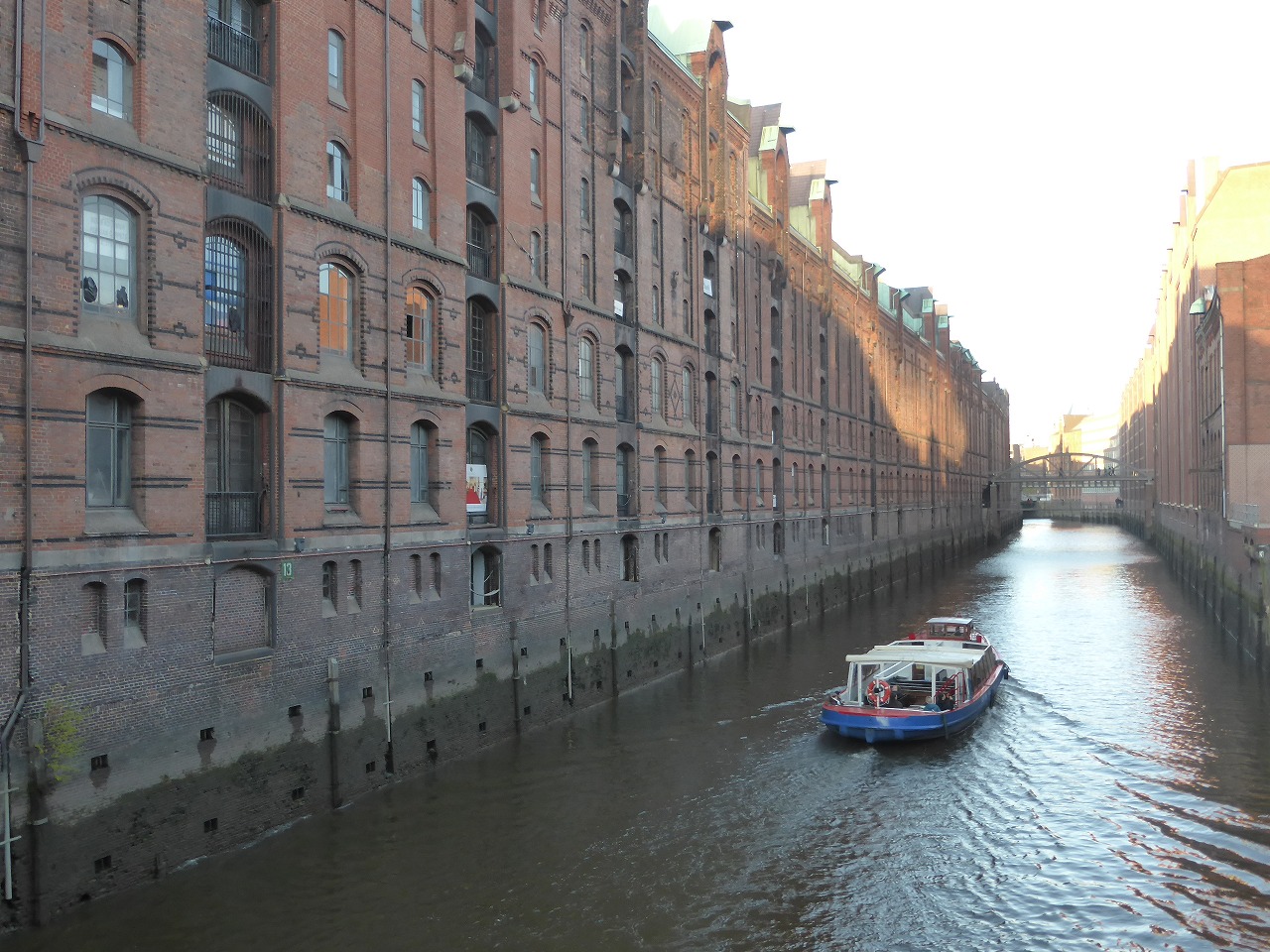 �u�q�ɊX�v �u�q�ɊX�v
1883�N����1927�N�ɂ����Č��Ă�ꂽ�Ԃ������K�q�ɂ�����ł��܂��B
"Speicherstadt"
Red-brick warehouses, built from 1883 to 1927, form a line. |
| �@�h�C�c���s�E�n���u���O Trip to Germany/Hamburg�@Junko�@ 2015�N5��12��(��) 19:33 |
�C�� |
 �u�q�ɊX�v������āc �u�q�ɊX�v������āc
We walked through "Speicherstadt". |
| �@�h�C�c���s�E�n���u���O Trip to Germany/Hamburg�@Junko�@ 2015�N5��12��(��) 19:34 |
�C�� |
 �u�n���u���O�`�v�ɓ����B���낻�남�[�т̎��Ԃł��B �u�n���u���O�`�v�ɓ����B���낻�남�[�т̎��Ԃł��B
We arrived at the "Port of Hamburg". It was a time to have a dinner soon. |
| �@�h�C�c���s�E�n���u���O Trip to Germany/Hamburg�@Junko�@ 2015�N5��12��(��) 19:35 |
�C�� |
 �����̂��[�сB �����̂��[�сB
�k�C�̃G�r�Ɨ��̗����B���̂�����̂������������ł��B
Today's dinner.
The dish of prawns of the North Sea and eggs. I heard it was a local dish of this neighborhood. |
| �@�h�C�c���s�E�n���u���O Trip to Germany/Hamburg�@Junko�@ 2015�N5��12��(��) 19:36 |
�C�� |
 �����̂��[�сB �����̂��[�сB
�X�e�[�L�B�h�C�c���ĈӊO�ɂ��������ˁI
Today's dinner.
Beef steak. The German dishes are unexpectedly nice. |
| �@2015.05.02�@�h�C�c���s�E�q���f�X�n�C�� Trip to Germany/Hildesheim�@Junko�@ 2015�N5��12��(��) 19:45 |
�C�� |
 ���E��Y�u���~�q���G���X����v ���E��Y�u���~�q���G���X����v
���݂�1010�N�Ɏn�܂�A1031�N�Ɋ������܂����B�Ύ��̌�A1186�N�ɍČ����Ȃ���܂����B
UNESCO World Heritage Site "St. Michael's Church"
Construction of it started in 1010 and completed in 1031. In 1186, the reconstruction conpleted after a fire.
|
| �@�h�C�c���s�E�q���f�X�n�C�� Trip to Germany/Hildesheim�@Junko�@ 2015�N5��12��(��) 19:47 |
�C�� |
 ���E��Y�u���~�q���G���X����v ���E��Y�u���~�q���G���X����v
�������V��G�B���~�q���G���X����͑�2����풆��45�N3��22���̋�P�Ŕj��܂�����1950�N�ɍČ����n�܂�1957�N�Ɋ������܂����B1985�N�ɂ̓q���f�X�n�C���吹���Ƌ��Ƀ��l�X�R���E������Y�ɓo�^����܂����B
UNESCO World Heritage Site "St. Michael's Church"
it's a beautiful panel paintings of the ceiling. St. Michael's Church was destroyed in an air raid during World War II on 22 March 1945, but reconstruction was begun in 1950 and completed in 1957. In 1985, the church became a UNESCO World Cultural Heritage site, along with the Cathedral of Hildesheim. |
| �@�h�C�c���s�E�q���f�X�n�C�� Trip to Germany/Hildesheim�@Junko�@ 2015�N5��12��(��) 19:48 |
�C�� |
 ���E��Y�u�吹���v ���E��Y�u�吹���v
�吹����1010�N����20�N�Ƀ��}�l�X�N�l���Ō��Ă��܂����B11�A12�A14���I�ɏC���Ƒ��z���s���܂������A1945�N3��22���̋�P�Ŋ��S�ɔj��1950�N����60�N�ɂ����čČ�����܂����B
UNESCO World Heritage Site "Hildesheim Cathedral"
The cathedral church was built between 1010 and 1020 in the Romanesque style. After renovations and extensions in the 11th, 12th and 14th centuries, the cathedral was completely destroyed during an air raid on 22 March 1945, and rebuilt from 1950 to 1960. |
| �@�h�C�c���s�E�q���f�X�n�C�� Trip to Germany/Hildesheim�@Junko�@ 2015�N5��12��(��) 19:52 |
�C�� |
 ���E��Y�u�吹���v ���E��Y�u�吹���v
�吹���͉�L�̒���̌�w�̕ǂɂ��������1000�N�̃o���̖ł��m���Ă��܂��B���m�Ȏ���͍��ł͂킩��܂��A�`���ł�815�N�̂��̂Ƃ̂��Ƃł��B�w���f�X�n�C���̏d�v�ȃV���{���ł���A�o��������Ă������A�吹�����ɉh����Ɠ`����Ă��܂��B�吹�����j�ꂽ1945�N3��22���̋�P�Ńo���̖��_���[�W���A���I�̉��ɂ͍��ł��̃o�����c�邾���ł����B�L���ȃo���̏����Ǝv��ꂽ�̂ł����A�n���ł͍������̂܂c���Ă���A45�N�̏t�ɂ͍Ă�25�{�̎}���L�тĂ����Ƃ������Ƃł��B1947�N�ɂ͍ŏ��̉Ԃ��ۂۂƍ炫�A48�N�ɂ�122�ɂȂ�܂����B���E�ŌẪo���Ƃ��čl�����Ă��܂��B
UNESCO World Heritage Site "Hildesheim Cathedral"
The cathedral building is widely known for the "Thousand-year Rose" which grows outside the building on the outer wall of the apse in the courtyard of the cloisters. The exact age of the rose is no longer precisely known, but the legend of the rosebush claims that it dates to 815. It is an important symbol of Hildesheim - according to folklore, as long as the bush flourishes, Hildesheim will prosper. The aerial bombardment of 22 March 1945 which damaged the cathedral and the apse also killed the main growth of the rosebush above the ground; under the rubble, only the charred stump of the rose remained. It was thought that the end of the famous rose had come, but the roots were largely intact, and in the spring of 1945 it put out 25 new shoots. The first sparse flowers bloomed in 1947, and by 1948 there were 122 flowers. It is believed to be the oldest living rose in the world. |
| �@�h�C�c���s�E�q���f�X�n�C�� Trip to Germany/Hildesheim�@Junko�@ 2015�N5��12��(��) 19:54 |
�C�� |
 ���E��Y�u�吹���v�O�̍L��B ���E��Y�u�吹���v�O�̍L��B
�����`��H�ׂɃ}���N�g�L��ֈړ��B
A square in front of UNESCO World Heritage Site "Hildesheim Cathedral"
We moved to the Market Square to eat a lunch. |
| �@�h�C�c���s�E�q���f�X�n�C�� Trip to Germany/Hildesheim�@Junko�@ 2015�N5��12��(��) 19:56 |
�C�� |
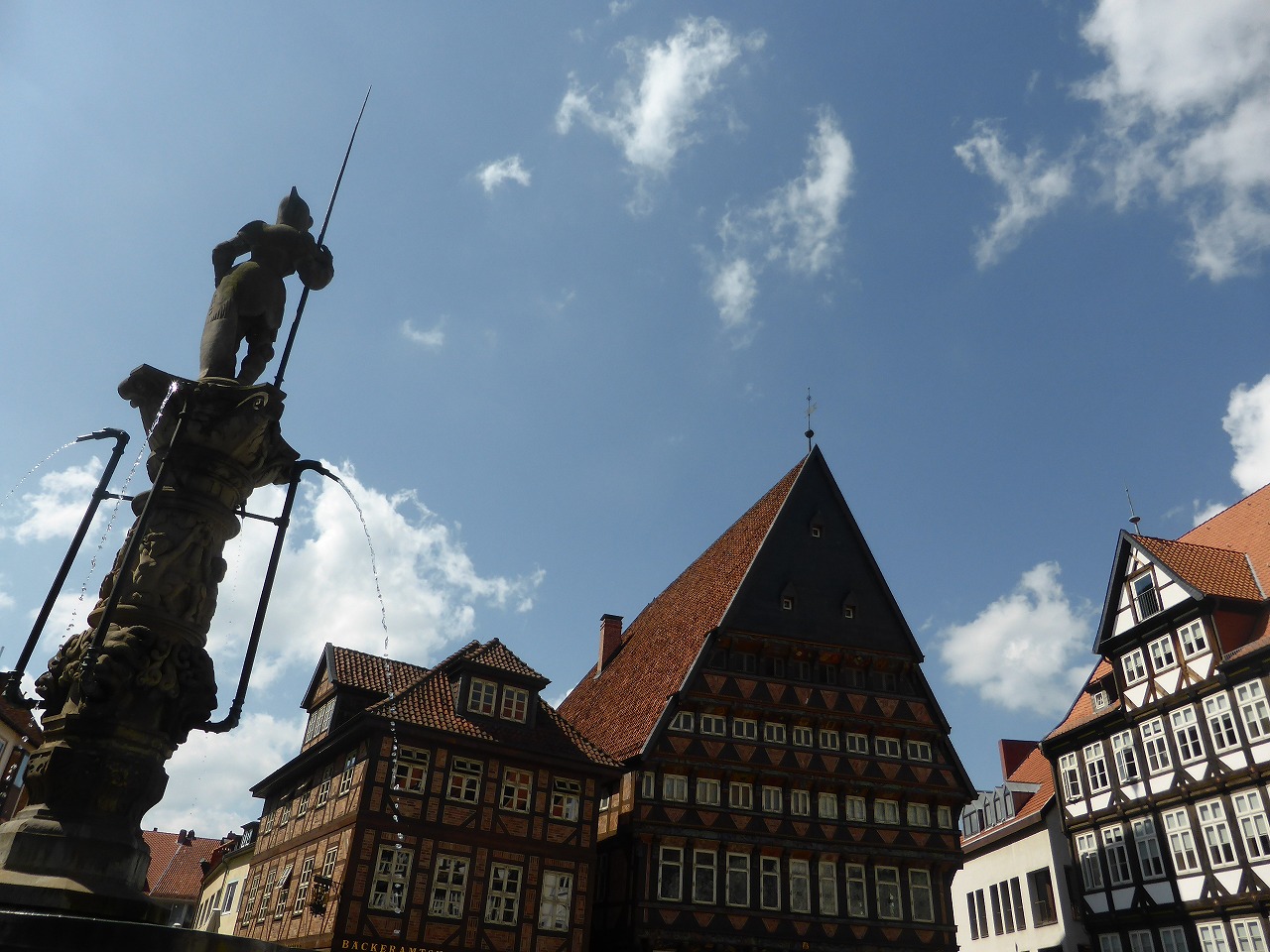 �u�}���N�g�L��v �u�}���N�g�L��v
�ؑg�݂̉ƂƎs���ɂ̍L��B���E��Y�ӂ���茩��������܂����B
"The market square"
A wooden framework houses and the town hall square. I think they are worth seeing more than two world heritage sites. |
| �@�h�C�c���s�E�q���f�X�n�C�� Trip to Germany/Hildesheim�@Junko�@ 2015�N5��12��(��) 19:59 |
�C�� |
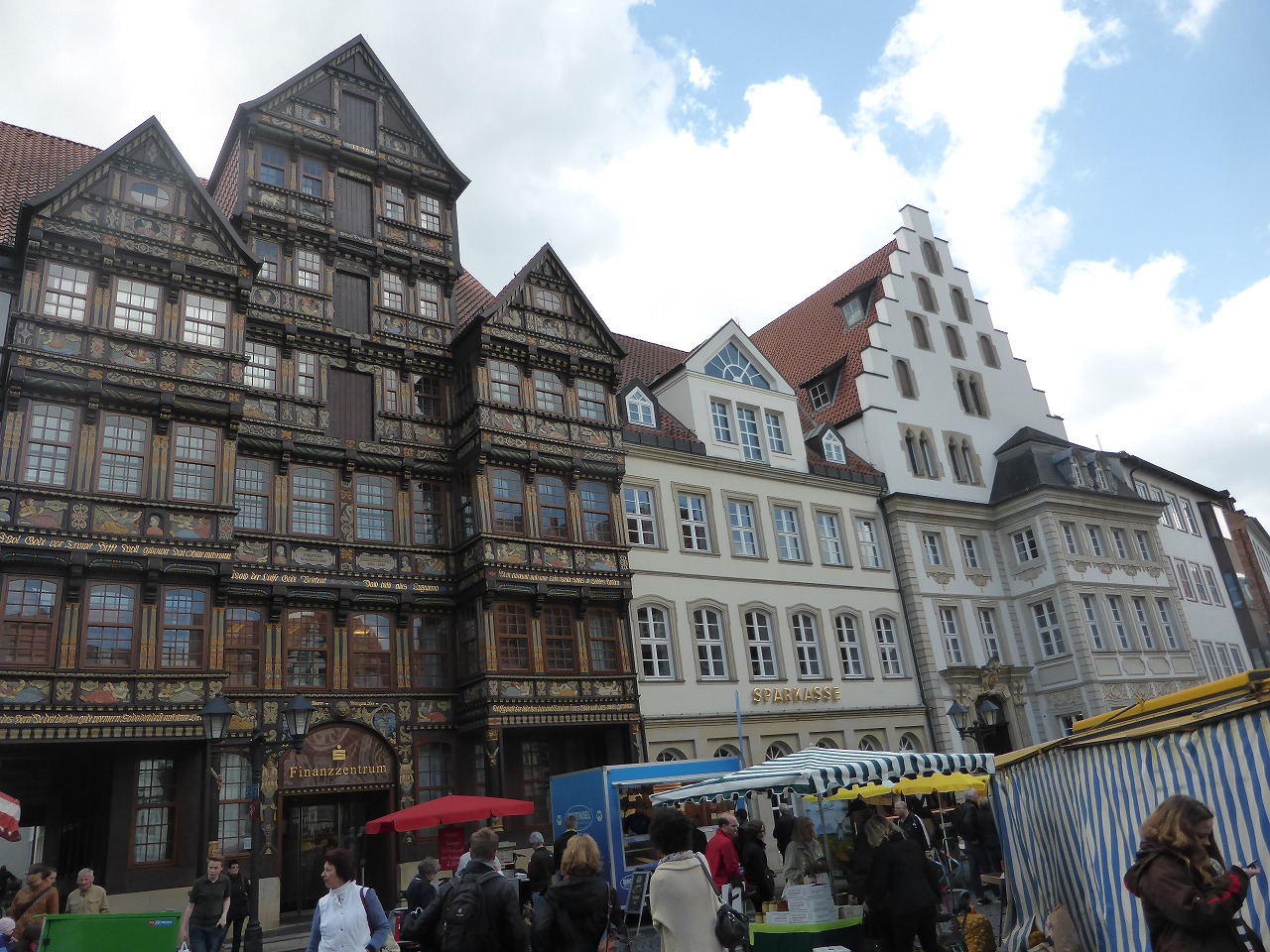 �u�}���N�g�L��v �u�}���N�g�L��v
���j�s���J����Ă��܂����B
"The market square"
Sunday market was held. |
| �@�h�C�c���s�E�q���f�X�n�C�� Trip to Germany/Hildesheim�@Junko�@ 2015�N5��12��(��) 20:00 |
�C�� |
 �u�}���N�g�L��v �u�}���N�g�L��v
�z���C�g�E�A�X�p���K�X�̋G�߂ł��B�z���C�g�A�X�p���K�X���X�B���ɂ̓A�X�p��������ނ��킪����܂����B
"The market square"
It's the season of white asparagus. A store specializing in asparagus. There is an automatic peeler of asparagus behind the shop. |
| �@�h�C�c���s�E�q���f�X�n�C�� Trip to Germany/Hildesheim�@Junko�@ 2015�N5��12��(��) 20:01 |
�C�� |
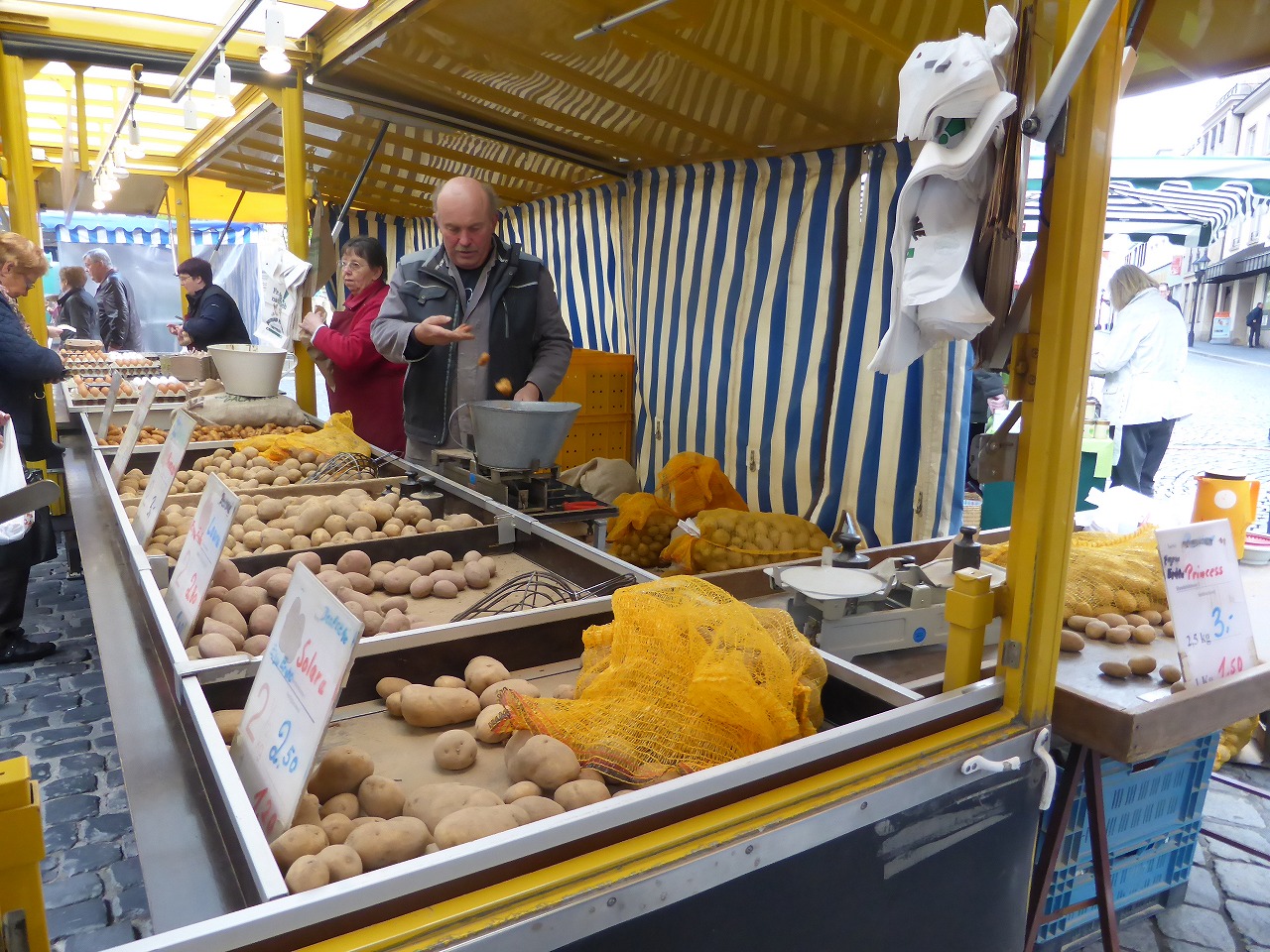 �u�}���N�g�L��v �u�}���N�g�L��v
���Ⴊ�������X�B���Ⴊ�����A����������ˁ[
"The market square"
A store specializing in potatoes. I thnik potato is very nice. |
| �@�h�C�c���s�E�q���f�X�n�C�� Trip to Germany/Hildesheim�@Junko�@ 2015�N5��12��(��) 20:05 |
�C�� |
 �u�}���N�g�L��v �u�}���N�g�L��v
�����̃����`�B�u�V���j�b�c�F���i�Ƃj�v�ł��B
"The market square"
Today's lunch. It is a schnitzel. |
| �@�h�C�c���s�E�q���f�X�n�C�� Trip to Germany/Hildesheim�@Junko�@ 2015�N5��12��(��) 20:06 |
�C�� |
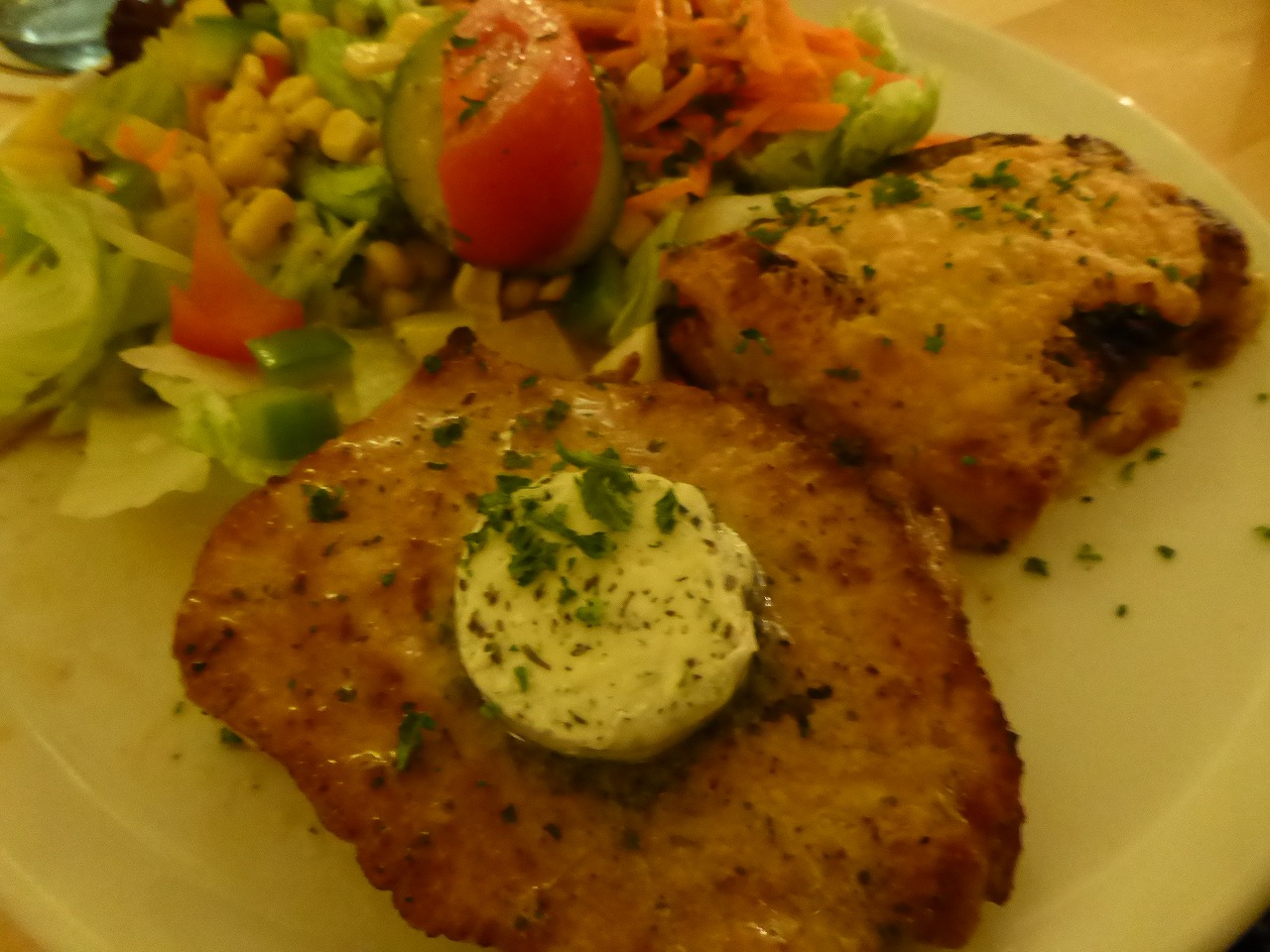 �u�}���N�g�L��v �u�}���N�g�L��v
�����̃����`�B�|�[�N�Ƌ��������Ǝv���܂��B
"The market square"
Today's lunch. I think it was a pork ans a fish. |
| �@�h�C�c���s�E�q���f�X�n�C�� Trip to Germany/Hildesheim�@Masaki�@ 2015�N5��12��(��) 20:08 |
�C�� |
 �Ԃ̉^�]�����邩����߂Ȃ���ȁ[�B �Ԃ̉^�]�����邩����߂Ȃ���ȁ[�B
I can't drink a beer because I must drive after the lunch. |
| �@�h�C�c���s Trip to Germany�@Junko�@ 2015�N5��12��(��) 20:17 |
�C�� |
 ��N�h�C�c39�Ԗڂ̐��E��Y�ɂȂ������x�l�f�B�N�g��C���@�R�����@�C�Ɍ������܂��B ��N�h�C�c39�Ԗڂ̐��E��Y�ɂȂ������x�l�f�B�N�g��C���@�R�����@�C�Ɍ������܂��B
We head for a Benedictine monastery "Imperial Abbey of Corvey" which was listed as the 39th UNESCO World Heritage Site in Germany last year. |
| �@�h�C�c���s Trip to Germany�@Junko�@ 2015�N5��12��(��) 20:18 |
�C�� |
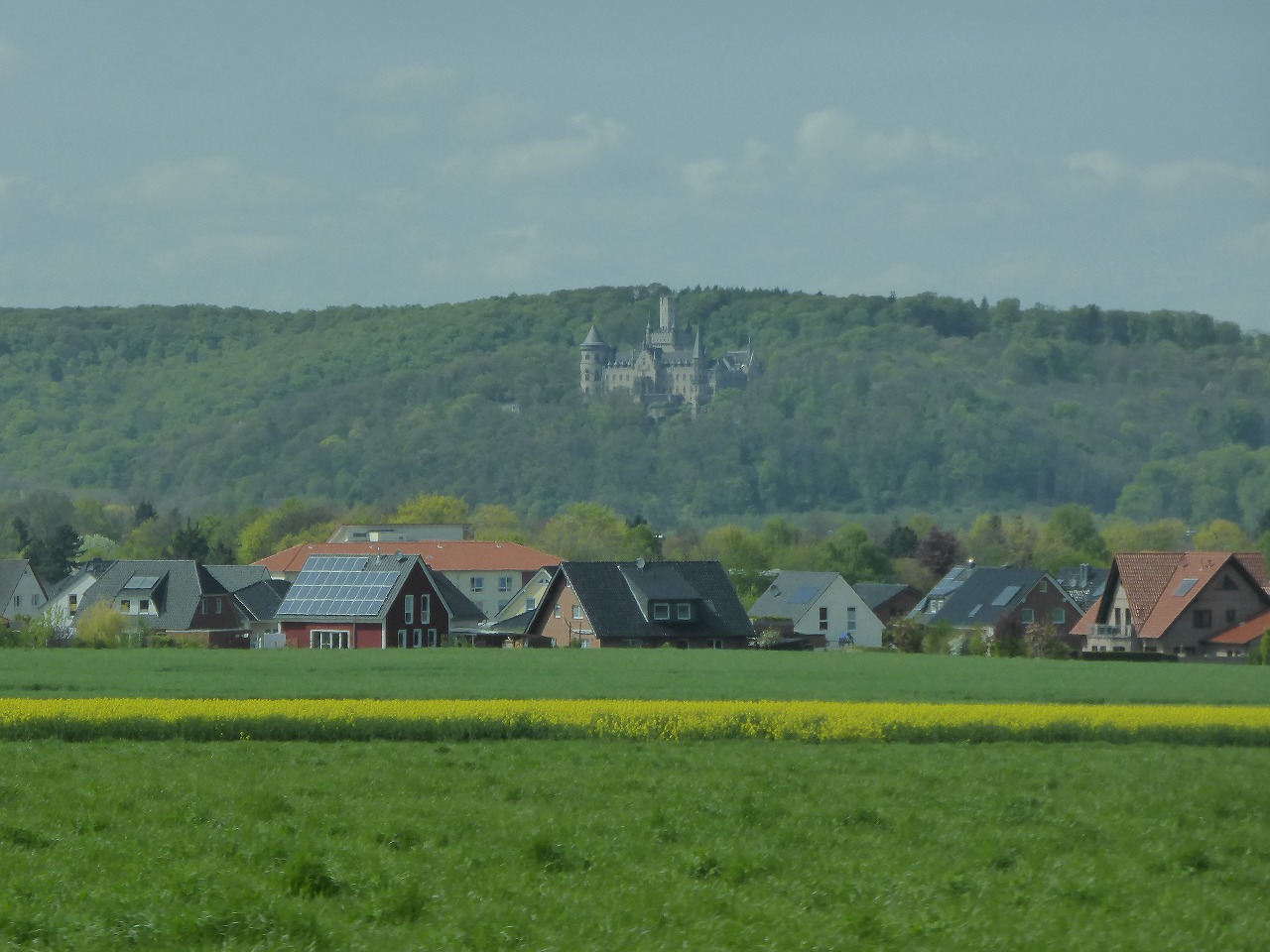 �����ɂ��邪�����܂����B �����ɂ��邪�����܂����B
We could see a castle far away. |
| �@�h�C�c���s�E���F�X�g���F���O Trip to Germany/Westphalia�@Junko�@ 2015�N5��12��(��) 20:19 |
�C�� |
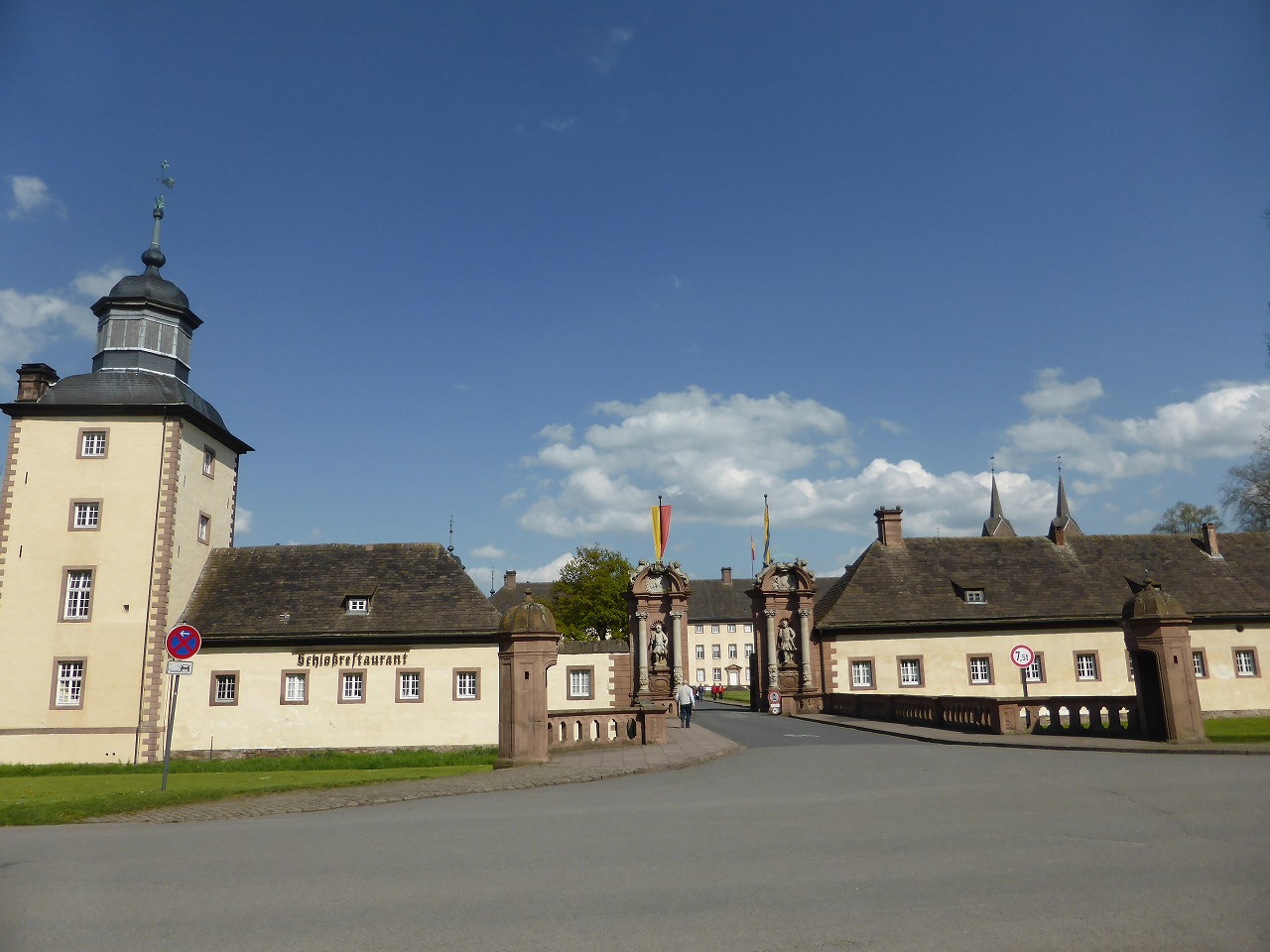 ���E��Y�u�R�����@�C�C���@�v�ɓ����B ���E��Y�u�R�����@�C�C���@�v�ɓ����B
We arrived at UNESCO World Heritage Site "Imperial Abbey of Corvey". |
| �@�h�C�c���s�E���F�X�g���F���O Trip to Germany/Westphalia�@Junko�@ 2015�N5��12��(��) 20:21 |
�C�� |
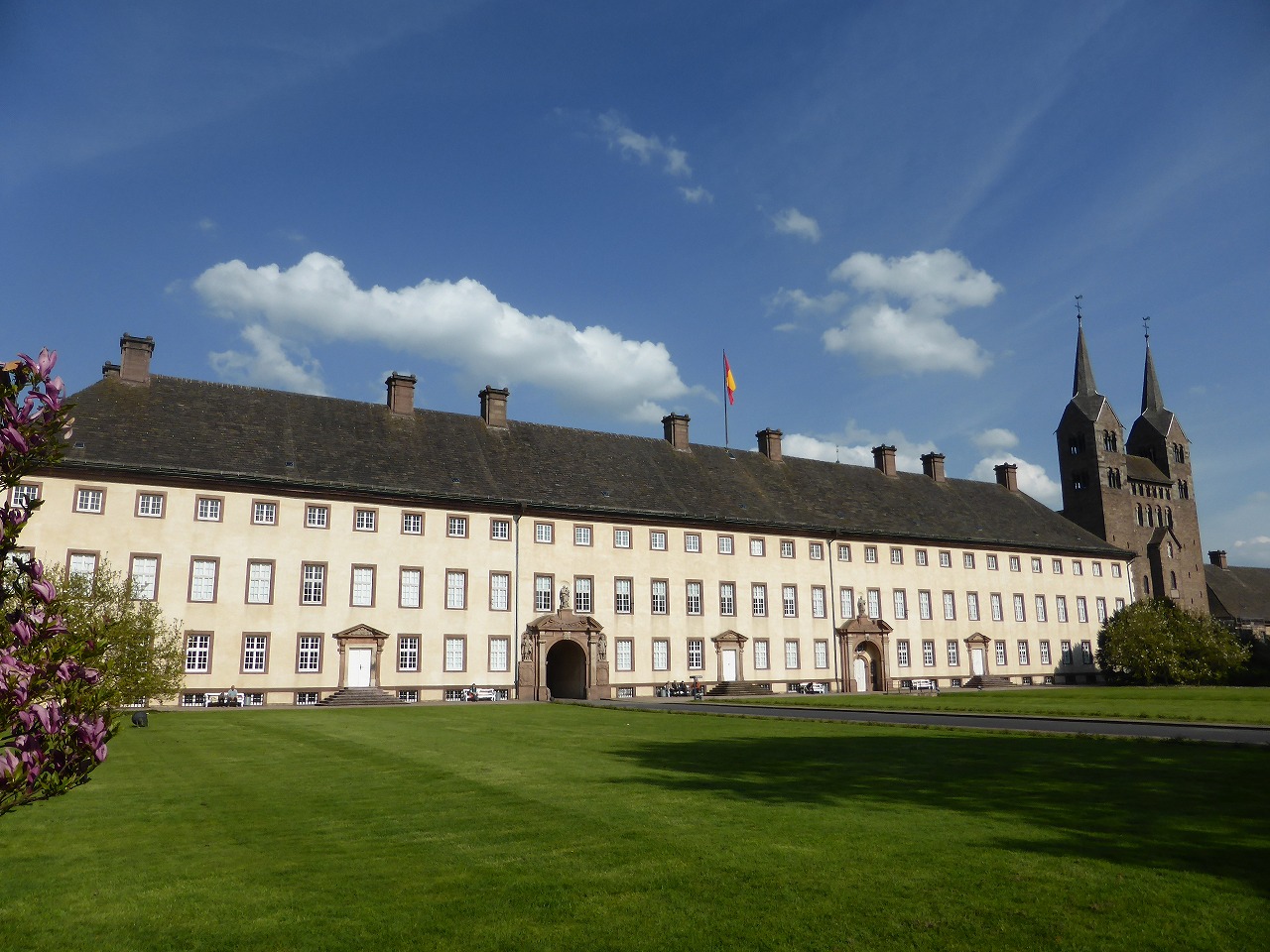 ���E��Y�u�R�����@�C�C���@�v ���E��Y�u�R�����@�C�C���@�v
�v���Ă�����肸���Ƒ傫�ȏC���@�ł��B822�N�̏��߁A�C���@�̓��B�X���݂͊̌��݂̏ꏊ�Ɍ��z����܂����B873�N����885�N�ɂ����Č��݂��c�鐼�����ʂ������܂����B
UNESCO World Heritage Site "Imperial Abbey of Corvey"
It's a bigger abbey than what we thought. Beginning in 822, the monastery was constructed on the present site near the banks of the river Weser. In 873-885, the Westwerk that is still extant today was constructed. |
| �@�h�C�c���s�E���F�X�g���F���O Trip to Germany/Westphalia�@Junko�@ 2015�N5��12��(��) 20:23 |
�C�� |
 ���E��Y�u�R�����@�C�C���@�v ���E��Y�u�R�����@�C�C���@�v
����B���ȍ��ł��B�����844�N�ɐ��ʂ���܂����B
UNESCO World Heritage Site "Imperial Abbey of Corvey"
The church. It's a luxurious interior decoration. The church was consecrated in 844. |
| �@�h�C�c���s�E���F�X�g���F���O Trip to Germany/Westphalia�@Junko�@ 2015�N5��12��(��) 20:24 |
�C�� |
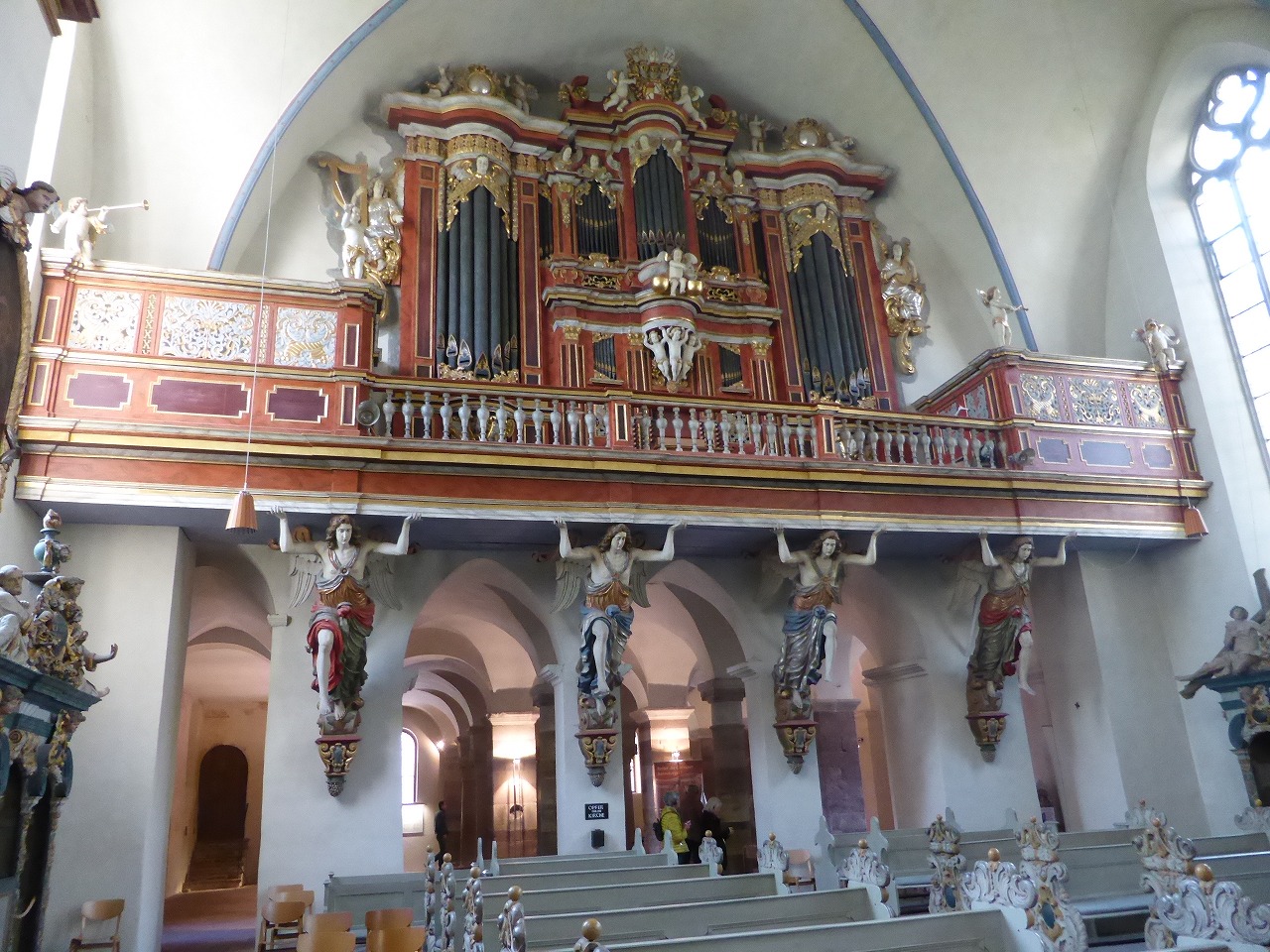 ���E��Y�u�R�����@�C�C���@�v ���E��Y�u�R�����@�C�C���@�v
����̃p�C�v�I���K���B
UNESCO World Heritage Site "Imperial Abbey of Corvey"
A pipe organ in the church. |
| �@�h�C�c���s�E���F�X�g���F���O Trip to Germany/Westphalia�@Junko�@ 2015�N5��12��(��) 20:25 |
�C�� |
 ���E��Y�u�R�����@�C�C���@�v ���E��Y�u�R�����@�C�C���@�v
�������������͍����ˁB
UNESCO World Heritage Site "Imperial Abbey of Corvey"
A confession booth of it is also gorgeous. |
| �@�h�C�c���s�E���F�X�g���F���O Trip to Germany/Westphalia�@Junko�@ 2015�N5��12��(��) 20:26 |
�C�� |
 ���E��Y�u�R�����@�C�C���@�v ���E��Y�u�R�����@�C�C���@�v
�C���@�����ɓ���܂��B30�N�푈�̊ԂɏC���@�͑��Q���A���̌����܂����B�������ʂ������c��܂����B17���I�ɏC���@�͍Č�����܂����B
UNESCO World Heritage Site "Imperial Abbey of Corvey"
We visit a monastery side. During the Thirty Years War the abbey was damaged and later demolished. Only the Westwerk remained. In the 17th century, the abbey was reconstructed. |
| �@�h�C�c���s�E���F�X�g���F���O Trip to Germany/Westphalia�@Junko�@ 2015�N5��12��(��) 20:27 |
�C�� |
 ���E��Y�u�R�����@�C�C���@�v ���E��Y�u�R�����@�C�C���@�v
�C���@�̉�L�B
UNESCO World Heritage Site "Imperial Abbey of Corvey"
A cloister of the abbey. |
| �@�h�C�c���s�E���F�X�g���F���O Trip to Germany/Westphalia�@Junko�@ 2015�N5��12��(��) 20:28 |
�C�� |
 ���E��Y�u�R�����@�C�C���@�v ���E��Y�u�R�����@�C�C���@�v
����̂悤�ɍ��ȍL�ԁB
UNESCO World Heritage Site "Imperial Abbey of Corvey"
It's a luxury hall like a castle's. |
| �@�h�C�c���s�E���F�X�g���F���O Trip to Germany/Westphalia�@Junko�@ 2015�N5��12��(��) 20:32 |
�C�� |
 ���E��Y�u�R�����@�C�C���@�v ���E��Y�u�R�����@�C�C���@�v
��������̑���������܂����B�L���ȏC���@�}���ق͒����ԎU�킵���܂܂ł����A��Ƀh�C�c�A�t�����X�A�p���74000���̑���������A���悻1834�N���ɖv�������M���̉Ƒ��̐}���فh�̎�̐}���فh�͍����c���Ă��܂��B
UNESCO World Heritage Site "Imperial Abbey of Corvey"
There was a big collection of books. The famous abbey library has long since been dispersed, but the "princely library", an aristocratic family library, containing about 74,000 volumes, mainly in German, French, and English, with a tailing off circa 1834, survives in the Schloss. |
| �@�h�C�c���s�E���F�X�g���F���O Trip to Germany/Westphalia�@Junko�@ 2015�N5��12��(��) 20:33 |
�C�� |
 ���E��Y�u�R�����@�C�C���@�v ���E��Y�u�R�����@�C�C���@�v
�Â��lj悪�c���Ă��܂����B
UNESCO World Heritage Site "Imperial Abbey of Corvey"
Old wall paintings remain. |
| �@�h�C�c���s�E���F�X�g���F���O Trip to Germany/Westphalia�@Junko�@ 2015�N5��12��(��) 20:35 |
�C�� |
 ���E��Y�u�R�����@�C�C���@�v�̌��w���I���� ���E��Y�u�R�����@�C�C���@�v�̌��w���I����
�u�J�b�Z���v�Ɍ������܂��B
We finished the visit of UNESCO World Heritage Site "Imperial Abbey of Corvey" and headed for "Kassel". |
| �@�h�C�c���s�E�J�b�Z�� Trip to Germany/Kassel�@Junko�@ 2015�N5��12��(��) 20:37 |
�C�� |
 �u�J�b�Z���v�s���ɁB �u�J�b�Z���v�s���ɁB
The city hall of Kassel. |
| �@�h�C�c���s�E�J�b�Z�� Trip to Germany/Kassel�@Junko�@ 2015�N5��12��(��) 20:39 |
�C�� |
 �����̂��[�сB �����̂��[�сB
�����j���O�E�X�V�ŐH�ו���B���͒��ؗ���������ł����B�������Ɛ��N���[���������ꂽ�����i��H�ׂ܂����[�B
Today's dinner. We had it at a running sushi restaurant offering as much as one can eat for a standard charge. Actually it's a chinese restaurant. I ate a sushi made rolled in nori seaweed with a strawberry and fresh cream. |
| �@2015.05.03 �h�C�c���s�E�J�b�Z�� Trip to Germany/Kassel�@Junko�@ 2015�N5��12��(��) 20:43 |
�C�� |
 �u�I�����W�����[�v �u�I�����W�����[�v
�w�b�Z�����J�b�Z�������J�[���̉���1703�N����11�N�̊ԂɌ��Ă��܂����B����ȗ��A�J�[���U�E�����̖k���R�[�i�[���߂Ă��܂��B���݂̓v���l�^���E���ƕ����w�W�����Ƃ��Ďg���Ă��܂��B
"Orangerie"
It was built under Landgrave Charles between 1703 and 1711. Since then, it forms the northern corner of the Karlsaue park. Today it is used as an astronomy and physical cabinet. |
| �@�h�C�c���s�E�J�b�Z�� Trip to Germany/Kassel�@Junko�@ 2015�N5��12��(��) 21:00 |
�C�� |
 ���E��Y�u���B���w�����X�w�[�G�����v�̐��̌|�p�����ɍs���܂����B ���E��Y�u���B���w�����X�w�[�G�����v�̐��̌|�p�����ɍs���܂����B
We came UNESCO World Heritage Site "Bergpark Wilhelmshohe" to see Water features. |
| �@�h�C�c���s�E�J�b�Z�� Trip to Germany/Kassel�@Junko�@ 2015�N5��12��(��) 21:35 |
�C�� |
 ���E��Y�u���B���w�����X�w�[�G�����v ���E��Y�u���B���w�����X�w�[�G�����v
���ʐ�240�w�N�^�[���A�u�ˌ����Ƃ��Ă̓��[���b�p�ő�̌����ł��BBergpark�A�u�R�̌����v�̌��݂̓w�b�Z�����J�b�Z�������̖̂��߂�1696�N�Ɏn�܂�A150�N�قǂ������Ă��܂��B
UNESCO World Heritage Site "Bergpark Wilhelmshohe"
The area of the park is 2.4 square kilometres, making it the largest European hillside park. Construction of the Bergpark, or "mountain park", began in 1696 at the behest of the Landgraves of Hesse-Kassel and took about 150 years. |
| �@�h�C�c���s�E�J�b�Z�� Trip to Germany/Kassel�@Junko�@ 2015�N5��12��(��) 21:43 |
�C�� |
 ���E��Y�u���B���w�����X�w�[�G�����v ���E��Y�u���B���w�����X�w�[�G�����v
�u���B���w�����X�w�[�G��v
1786�N����1798�N�ɂ����Č��݂���܂����B��̒����̑啔���͑�2�����Ŕj��܂����B�P��ڂ̍Č���1968�N����74�N�ɍs���Ă��܂��B1994�N����2000�N�̏C���ŏ�̓I���W�i���̌`�����Ȃ���߂��܂����B�����ł͐��E�ő�̃����u�����g�R���N�V�������܂ދ����̃M�������[��Ñ㒤����O���t�B�b�N�E�A�[�g�̔��p�قɂȂ��Ă��܂��B
UNESCO World Heritage Site "Bergpark Wilhelmshohe"
"Schloss Wilhelmshohe"
It was built from 1786 to 1798. The middle tract of the castle was substantially destroyed during the Second World War. The first reconstruction was made in 1968-1974. From 1994 to 2000 a renovation was made to bring it closer to the original structure. Today the Wilhelmshöhe Castle Museum houses the antiquities collection, the Gallery of the Old Masters (which includes one of the world's largest Rembrandt collections) and the Graphic Arts Collection. |
| �@�h�C�c���s�E�J�b�Z�� Trip to Germany/Kassel�@Junko�@ 2015�N5��12��(��) 21:50 |
�C�� |
 ���E��Y�u���B���w�����X�w�[�G�����v ���E��Y�u���B���w�����X�w�[�G�����v
�����̃����`�͔��p�ق̃J�t�F�Ńc�i�T���_�B
UNESCO World Heritage Site "Bergpark Wilhelmshohe"
Today's lunch was a tuna salad at the cafe of the museum. |
| �@�h�C�c���s�E�J�b�Z�� Trip to Germany/Kassel�@Junko�@ 2015�N5��12��(��) 21:52 |
�C�� |
 ���E��Y�u���B���w�����X�w�[�G�����v ���E��Y�u���B���w�����X�w�[�G�����v
�J�t�F�̃��j���[�Ɣ��p�ٓ��ꌔ�B2���Ԃ͂�������p�ق����ǁA7���[���̓��ꗿ�͈����ˁB
UNESCO World Heritage Site "Bergpark Wilhelmshohe"
A menu of cafe and an entrance ticket of the museum. Though it takes 2hours to see this museum, I think an admission of 7euros is reasonable. |
| �@�h�C�c���s�E�J�b�Z�� Trip to Germany/Kassel�@Junko�@ 2015�N5��12��(��) 22:14 |
�C�� |
 ���E��Y�u���B���w�����X�w�[�G�����v ���E��Y�u���B���w�����X�w�[�G�����v
�u���[���F���u���N��v�B�u�ˌ����̒����ɂ���܂��B�����̂���̂悤�Ɍ����܂����A���z��1793�N�`98�N�̊Ԃł��B
UNESCO World Heritage Site "Bergpark Wilhelmshohe"
"Schloss Lowenburg" It is on the middle of the hillside. Although it looks like a medieval castle, it was built during 1793-1798. |
| �@�h�C�c���s�E�J�b�Z�� Trip to Germany/Kassel�@Junko�@ 2015�N5��12��(��) 22:23 |
�C�� |
 ���E��Y�u���B���w�����X�w�[�G�����v ���E��Y�u���B���w�����X�w�[�G�����v
�u���B���w�����X�w�[�G��v�����������̃w���N���X���������܂��B�����炠�����܂ŏ��܂��B�w���N���X����1701�N����10�N�ɂ����Č��Ă��܂����B
UNESCO World Heritage Site "Bergpark Wilhelmshohe"
We can see "Hercules monument" on the top of the park from "Schloss Wilhelmshohe". We will climb there from now on. The Hercules statue was built in the years 1701 to 1717. |
| �@�h�C�c���s�E�J�b�Z�� Trip to Germany/Kassel�@Junko�@ 2015�N5��12��(��) 22:26 |
�C�� |
 ���E��Y�u���B���w�����X�w�[�G�����v ���E��Y�u���B���w�����X�w�[�G�����v
�r�����牺���݂�Ƃ���Ȋ����B�J�b�Z���̊X���L����܂��B
UNESCO World Heritage Site "Bergpark Wilhelmshohe"
When we look at the bottom from the middle of stairs, we can see such a landscape. A town of Kassel spreads out. |
| �@�h�C�c���s�E�J�b�Z�� Trip to Germany/Kassel�@Junko�@ 2015�N5��12��(��) 22:30 |
�C�� |
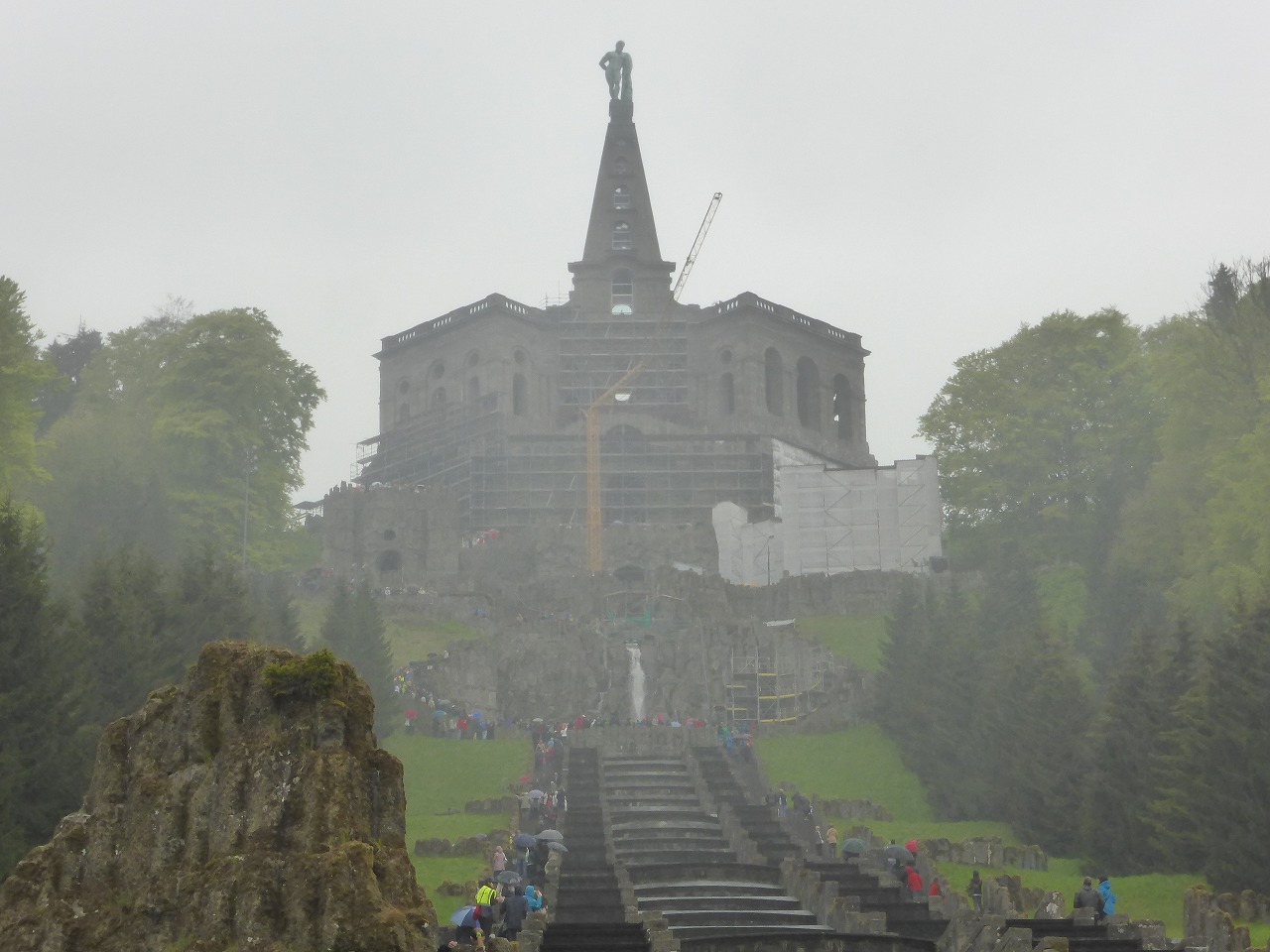 ���E��Y�u���B���w�����X�w�[�G�����v ���E��Y�u���B���w�����X�w�[�G�����v
�Ď��Ԃ̐��j���Ɠ��j���̌ߌ�2��������u���̌|�p�v���s���܂��B
�w���N���X���̑������琅��������A�u�J�X�J�[�f���v�Ƃ����K�i��`�������܂��B�������𐅂̗���ƂƂ��Ɉړ����A���ǂ���Ő��̃V���[�i����邾�������ǁj���y���݂܂��B�Q���R�O���A�u���̌|�p�v���n�܂�܂����B
UNESCO World Heritage Site "Bergpark Wilhelmshohe"
Water features is carried out from 2:30pm of every Wednesday and Sundy in the summertime. Water flows from the foot of Hercules statue and run down the stairs called "cascades", People follow the flow of water in the park and enjoy the water show at the point of note(Only flowing). Water features began at 2:30. |
| �@�h�C�c���s�E�J�b�Z�� Trip to Germany/Kassel�@Junko�@ 2015�N5��12��(��) 22:33 |
�C�� |
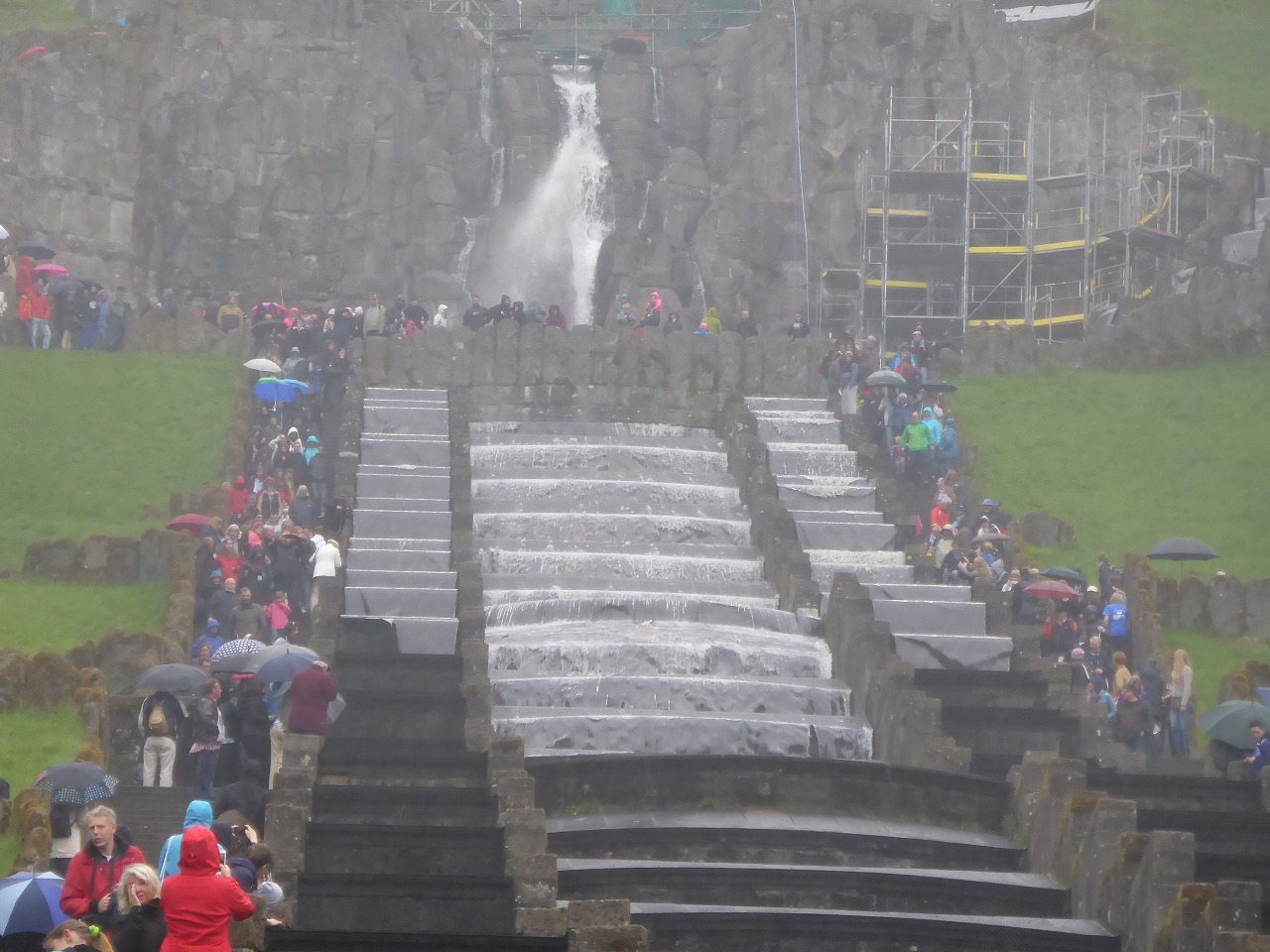 ���E��Y�u���B���w�����X�w�[�G�����v ���E��Y�u���B���w�����X�w�[�G�����v
�u�J�X�J�[�f���v�𗬂ꗎ���Ă��āc
UNESCO World Heritage Site "Bergpark Wilhelmshohe"
Water was running down the cascades. |
| �@�h�C�c���s�E�J�b�Z�� Trip to Germany/Kassel�@Junko�@ 2015�N5��12��(��) 22:35 |
�C�� |
 ���E��Y�u���B���w�����X�w�[�G�����v ���E��Y�u���B���w�����X�w�[�G�����v
�҂��Ă���r�ɓ͂��܂��B
UNESCO World Heritage Site "Bergpark Wilhelmshohe"
Water reached the pond where we were waiting. |
| �@�h�C�c���s�E�J�b�Z�� Trip to Germany/Kassel�@Junko�@ 2015�N5��12��(��) 22:36 |
�C�� |
 ���E��Y�u���B���w�����X�w�[�G�����v ���E��Y�u���B���w�����X�w�[�G�����v
���ʂ������Ă��ꂢ�ȑ�ɂȂ�܂����B�����Ńh�C�c�l�͑劅�сI�i��������Ă��邾���ł����ǁc�j
UNESCO World Heritage Site "Bergpark Wilhelmshohe"
The quantity of water increased and made a beautiful waterfall. Germans cheered it very much. (Only water was flowing) |
| �@�h�C�c���s�E�J�b�Z�� Trip to Germany/Kassel�@Junko�@ 2015�N5��12��(��) 22:39 |
�C�� |
 ���E��Y�u���B���w�����X�w�[�G�����v ���E��Y�u���B���w�����X�w�[�G�����v
���͂R���Ɂu�V���^�C���z�[�t�@�[��v�ł��B�ϋq�������Ĉړ��B
UNESCO World Heritage Site "Bergpark Wilhelmshohe"
The next was "the Steinhofer's waterfall" at 3pm. The audience moved on foot. |
| �@�h�C�c���s�E�J�b�Z�� Trip to Germany/Kassel�@Junko�@ 2015�N5��12��(��) 22:40 |
�C�� |
 ���E��Y�u���B���w�����X�w�[�G�����v ���E��Y�u���B���w�����X�w�[�G�����v
�R���O�Ɂu�V���^�C���z�[�t�@�[��v�֓����B
UNESCO World Heritage Site "Bergpark Wilhelmshohe"
We arrived at "the Steinhofer's waterfall" before 3pm. |
| �@�h�C�c���s�E�J�b�Z�� Trip to Germany/Kassel�@Junko�@ 2015�N5��12��(��) 22:42 |
�C�� |
 ���E��Y�u���B���w�����X�w�[�G�����v ���E��Y�u���B���w�����X�w�[�G�����v
�u�V���^�C���z�[�t�@�[��v�ɐ������܂����B
UNESCO World Heritage Site "Bergpark Wilhelmshohe"
Water also arrived at "the Steinhofer's waterfall". |
| �@�h�C�c���s�E�J�b�Z�� Trip to Germany/Kassel�@Junko�@ 2015�N5��12��(��) 22:43 |
�C�� |
 ���E��Y�u���B���w�����X�w�[�G�����v ���E��Y�u���B���w�����X�w�[�G�����v
���������������āc
UNESCO World Heritage Site "Bergpark Wilhelmshohe"
Water was increasing little by little. |
| �@�h�C�c���s�E�J�b�Z�� Trip to Germany/Kassel�@Junko�@ 2015�N5��12��(��) 22:46 |
�C�� |
 ���E��Y�u���B���w�����X�w�[�G�����v ���E��Y�u���B���w�����X�w�[�G�����v
�Ăуh�C�c�l�A�劅�сB
UNESCO World Heritage Site "Bergpark Wilhelmshohe"
Germans cheered it very much again. |
| �@�h�C�c���s�E�J�b�Z�� Trip to Germany/Kassel�@Junko�@ 2015�N5��12��(��) 22:49 |
�C�� |
 ���E��Y�u���B���w�����X�w�[�G�����v ���E��Y�u���B���w�����X�w�[�G�����v
���͂R���P�O���Ɂu�g�C�t�F���X�u�����b�P�i�����̋��j�v�B���̏ォ�牺������Ɛ�������̂�҂��Ă���l�������܂��B
UNESCO World Heritage Site "Bergpark Wilhelmshohe"
The next was "the devil's bridge" at 3:10pm. When we looked down on the bridge, we could see the people who was waiting for the arrival of water. |
| �@�h�C�c���s�E�J�b�Z�� Trip to Germany/Kassel�@Junko�@ 2015�N5��12��(��) 22:50 |
�C�� |
 ���E��Y�u���B���w�����X�w�[�G�����v ���E��Y�u���B���w�����X�w�[�G�����v
�u�g�C�t�F���X�u�����b�P�i�����̋��j�v�ɐ������ꂾ���܂����B
UNESCO World Heritage Site "Bergpark Wilhelmshohe"
Water began to flow under "the devil's bridge". |
| �@�h�C�c���s�E�J�b�Z�� Trip to Germany/Kassel�@Junko�@ 2015�N5��12��(��) 22:52 |
�C�� |
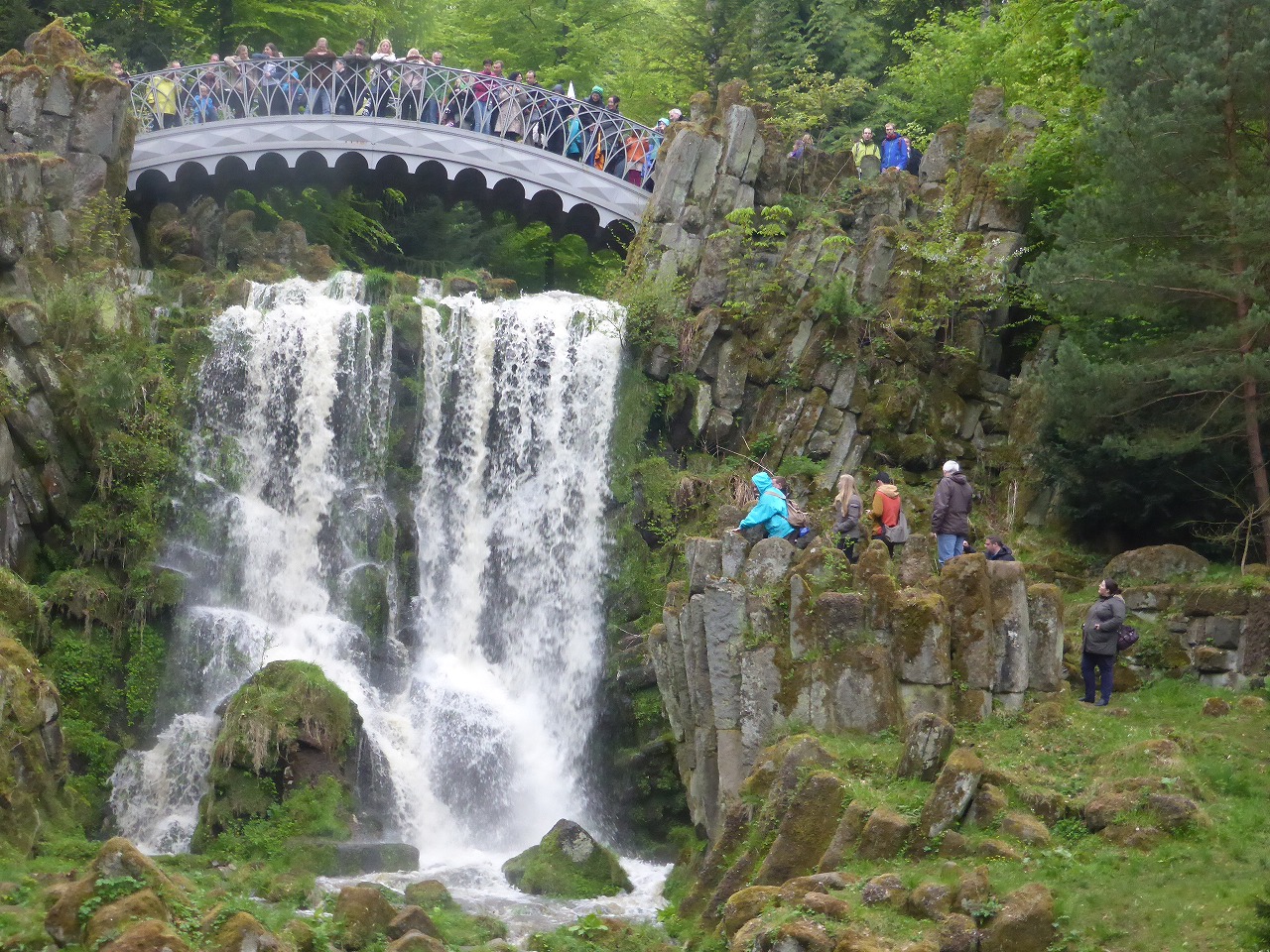 ���E��Y�u���B���w�����X�w�[�G�����v ���E��Y�u���B���w�����X�w�[�G�����v
�傫�ȑ�ɂȂ��āA�劅�сB
UNESCO World Heritage Site "Bergpark Wilhelmshohe"
It became the big waterfall and Germans cheered it very much again. |
| �@�h�C�c���s�E�J�b�Z�� Trip to Germany/Kassel�@Junko�@ 2015�N5��12��(��) 22:55 |
�C�� |
 ���E��Y�u���B���w�����X�w�[�G�����v ���E��Y�u���B���w�����X�w�[�G�����v
���͂R���Q�O���Ɂu�A�N���F�h�D�N�g�i�������j�v�B���̗���ɉ����Ĉړ��ł��B
UNESCO World Heritage Site "Bergpark Wilhelmshohe"
The next was "the aqueduct" at 3:20. We moved along the flow of water. |
| �@�h�C�c���s�E�J�b�Z�� Trip to Germany/Kassel�@Junko�@ 2015�N5��12��(��) 22:57 |
�C�� |
 ���E��Y�u���B���w�����X�w�[�G�����v ���E��Y�u���B���w�����X�w�[�G�����v
���̗���ɒǂ��z����܂����I
UNESCO World Heritage Site "Bergpark Wilhelmshohe"
We were overtaken by descent from water. |
| �@�h�C�c���s�E�J�b�Z�� Trip to Germany/Kassel�@Junko�@ 2015�N5��12��(��) 22:58 |
�C�� |
 ���E��Y�u���B���w�����X�w�[�G�����v ���E��Y�u���B���w�����X�w�[�G�����v
�u�A�N���F�h�D�N�g�i�������j�v�B���̂����𐅂�����Ă��܂��B
UNESCO World Heritage Site "Bergpark Wilhelmshohe"
"The aqueduct" Water was flowing on this bridge. |
| �@�h�C�c���s�E�J�b�Z�� Trip to Germany/Kassel�@Junko�@ 2015�N5��12��(��) 23:00 |
�C�� |
 ���E��Y�u���B���w�����X�w�[�G�����v ���E��Y�u���B���w�����X�w�[�G�����v
�u�A�N���F�h�D�N�g�i�������j�v����啬���r�֑�ʂ̐��������܂��B
UNESCO World Heritage Site "Bergpark Wilhelmshohe"
A large amount water was sent from "The aqueduct" to the lake of the castle. |
| �@�h�C�c���s�E�J�b�Z�� Trip to Germany/Kassel�@Junko�@ 2015�N5��12��(��) 23:03 |
�C�� |
 ���E��Y�u���B���w�����X�w�[�G�����v ���E��Y�u���B���w�����X�w�[�G�����v
�u�A�N���F�h�D�N�g�i�������j�v����啬���r�ցB���͂R���R�O���A���R�̈��͂ɂ���ĂT�Q���[�g���܂ŕ����グ���u���̌|�p�v�̃t�B�i�[���ƂȂ�܂��B
UNESCO World Heritage Site "Bergpark Wilhelmshohe"
We moved from "The aqueduct" to the lake of the castle. At 3:30, water was blowing up to 52m by natural pressure and that was the final of "Water features". |
| �@�h�C�c���s�E�J�b�Z�� Trip to Germany/Kassel�@Junko�@ 2015�N5��12��(��) 23:05 |
�C�� |
 ���E��Y�u���B���w�����X�w�[�G�����v ���E��Y�u���B���w�����X�w�[�G�����v
�u�啬���r�v�B�����グ���n�߂܂����B
UNESCO World Heritage Site "Bergpark Wilhelmshohe"
"The lake of the castle". Water began to be blown up. |
| �@�h�C�c���s�E�J�b�Z�� Trip to Germany/Kassel�@Junko�@ 2015�N5��12��(��) 23:07 |
�C�� |
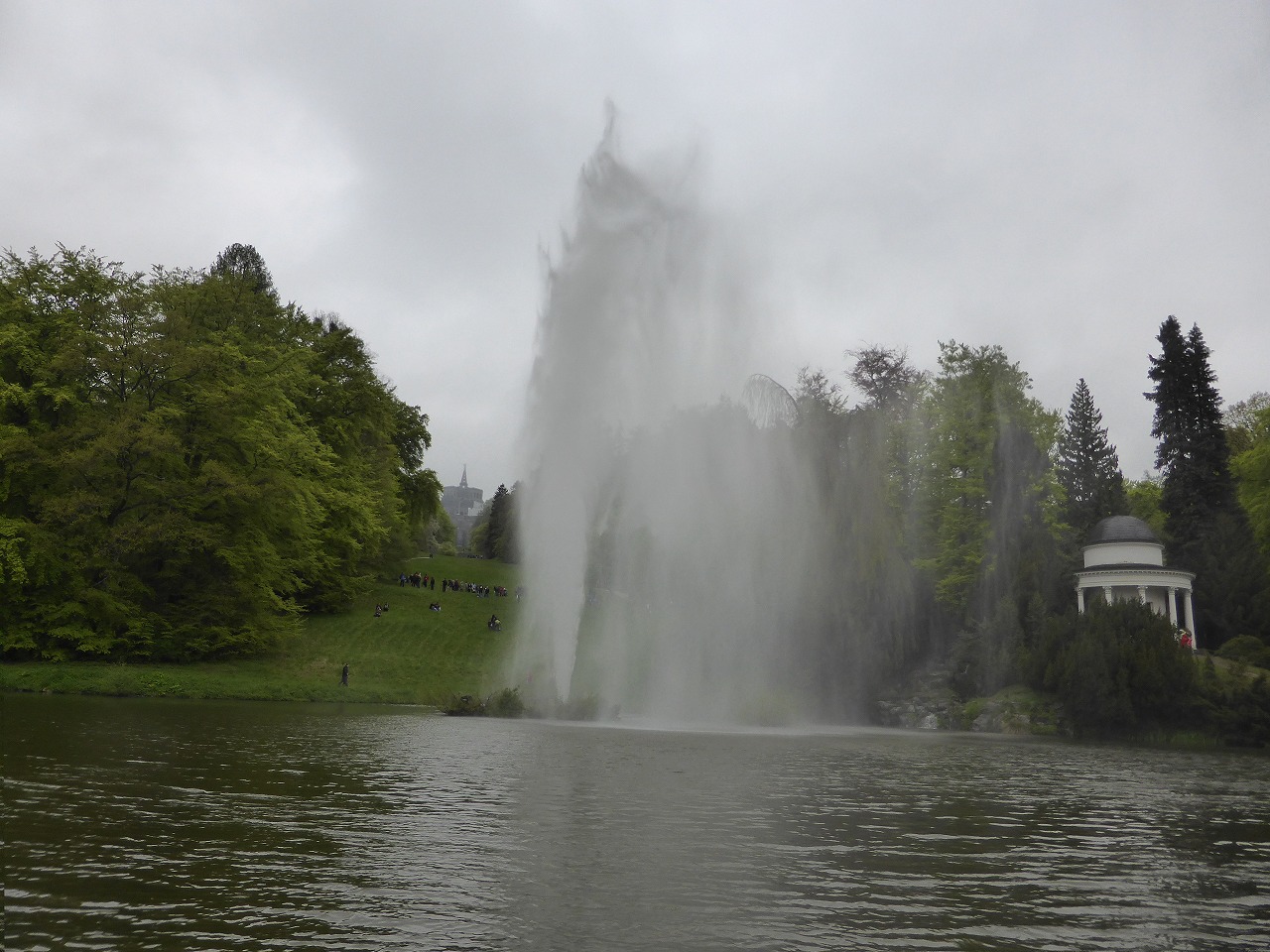 ���E��Y�u���B���w�����X�w�[�G�����v ���E��Y�u���B���w�����X�w�[�G�����v
�����������ŕ����グ���Ă��܂��B�h�C�c�l�A�劅�сB�P���Ԃ́u���̌|�p�v�̃t�B�i�[���ł����B
UNESCO World Heritage Site "Bergpark Wilhelmshohe"
Water was blowing up by great force. Germans cheered it up again. That was tha final of "Water features" of 1hour. |
| �@�h�C�c���s�E�J�b�Z�� Trip to Germany/Kassel�@Junko�@ 2015�N5��12��(��) 23:11 |
�C�� |
 ���E��Y�u���B���w�����X�w�[�G�����v ���E��Y�u���B���w�����X�w�[�G�����v
�u���[���F���u���N��v�킴�ƈꕔ��p�Ђ̂悤�ɂ��ă��}���e�B�b�N�ȕ��͋C�������Ă��邻���ł��B
UNESCO World Heritage Site "Bergpark Wilhelmshohe"
"Schloss Lowenburg" I heard this castle brings on a romantic atmosphere by making a part like the ruins proposely. |
| �@�h�C�c���s�E�J�b�Z�� Trip to Germany/Kassel�@Junko�@ 2015�N5��12��(��) 23:16 |
�C�� |
 �u�J�b�Z���E���B���w�����X�w�[�G�v�w�B �u�J�b�Z���E���B���w�����X�w�[�G�v�w�B
�X������������l���c�I�����̓h�C�c�̌Ï�z�e���ɏh���ł��B������������܂��B
"Kassel Wilhelmshohe station"
We found the person who was walkin on a leaning pillar. We would stay overnight at the old castle hotel in Germany. We were going to leave now. |
| �@�h�C�c���s�E��z�e�� Trip to Germany/The Old Castle Hotel�@Junko�@ 2015�N5��12��(��) 23:18 |
�C�� |
 �J�b�Z������ԂłR�O��������ƁB�Ï�z�e���u�U�o�u���O��v�ɓ����B1334�N���A���̏�͏���҂���邽�߂Ɍ��Ă��A160�N��A�̎�̎�p�̊ق�X�Ƃ��Ďg���܂����B���̓Ɠ��̊O�ς��炱�̊G�̂悤�Ȕp�Ђ́u�����X�̔����̏�v�ƌĂ�܂����B �J�b�Z������ԂłR�O��������ƁB�Ï�z�e���u�U�o�u���O��v�ɓ����B1334�N���A���̏�͏���҂���邽�߂Ɍ��Ă��A160�N��A�̎�̎�p�̊ق�X�Ƃ��Ďg���܂����B���̓Ɠ��̊O�ς��炱�̊G�̂悤�Ȕp�Ђ́u�����X�̔����̏�v�ƌĂ�܂����B
It took about 30minutes from Kassel. We arrived at the old castle hotel "Dornroeschenschloss Sababurg". As early as 1334, this castle was erected to protect the pilgrims. Roughly 160 years on, it was used as a sumptuous hunting lodge and horse stud of the lord. The vernacular gave the picturesque ruin the name �gCastle of the Sleeping Beauty�h. |
| �@�h�C�c���s�E��z�e�� Trip to Germany/The Old Castle Hotel�@Junko�@ 2015�N5��12��(��) 23:19 |
�C�� |
 �ƂĂ����킢���������ł��B �ƂĂ����킢���������ł��B
The room was very cute. |
| �@�h�C�c���s�E��z�e�� Trip to Germany/The Old Castle Hotel�@Junko�@ 2015�N5��12��(��) 23:20 |
�C�� |
 �����Ă��Ï�z�e���̎���͂Ȃɂ��Ȃ���ł���ˁB �����Ă��Ï�z�e���̎���͂Ȃɂ��Ȃ���ł���ˁB
Usually there are anything special around the old castke hotel. |
| �@�h�C�c���s�E��z�e�� Trip to Germany/The Old Castle Hotel�@Junko�@ 2015�N5��12��(��) 23:20 |
�C�� |
 �^�]������̂ň���䖝���Ă����r�[���Ŋ��t�B �^�]������̂ň���䖝���Ă����r�[���Ŋ��t�B
Masaki toasted it with the beer which he endured all day long due to drive a car. |
| �@�h�C�c���s�E��z�e�� Trip to Germany/The Old Castle Hotel�@Junko�@ 2015�N5��12��(��) 23:21 |
�C�� |
 �A�~���[�Y�B����̂���łƂꂽ�H�p�Ԃ������ł��B �A�~���[�Y�B����̂���łƂꂽ�H�p�Ԃ������ł��B
Amuse bouche. I heard it was a edible flower which was gotten in the garden of the castle. |
| �@�h�C�c���s�E��z�e�� Trip to Germany/The Old Castle Hotel�@Junko�@ 2015�N5��12��(��) 23:22 |
�C�� |
 �C�m�V�V�̃n���B �C�m�V�V�̃n���B
Ham of a wild boar. |
| �@�h�C�c���s�E��z�e�� Trip to Germany/The Old Castle Hotel�@Junko�@ 2015�N5��12��(��) 23:23 |
�C�� |
 �X�[�v�B�܂��̃_���v�����O���o���̌`�ɂȂ��Ă��܂��B �X�[�v�B�܂��̃_���v�����O���o���̌`�ɂȂ��Ă��܂��B
A soup. A dumpling od a trout has a shape of the rose. |
| �@�h�C�c���s�E��z�e�� Trip to Germany/The Old Castle Hotel�@Junko�@ 2015�N5��12��(��) 23:24 |
�C�� |
 ���C���B ���C���B
�Q��ނ̃��C���̃\�[�X�������ł��B
A main dish. I heard a sauce of 2 kind of wine was used. |
| �@�h�C�c���s�E��z�e�� Trip to Germany/The Old Castle Hotel�@Junko�@ 2015�N5��12��(��) 23:25 |
�C�� |
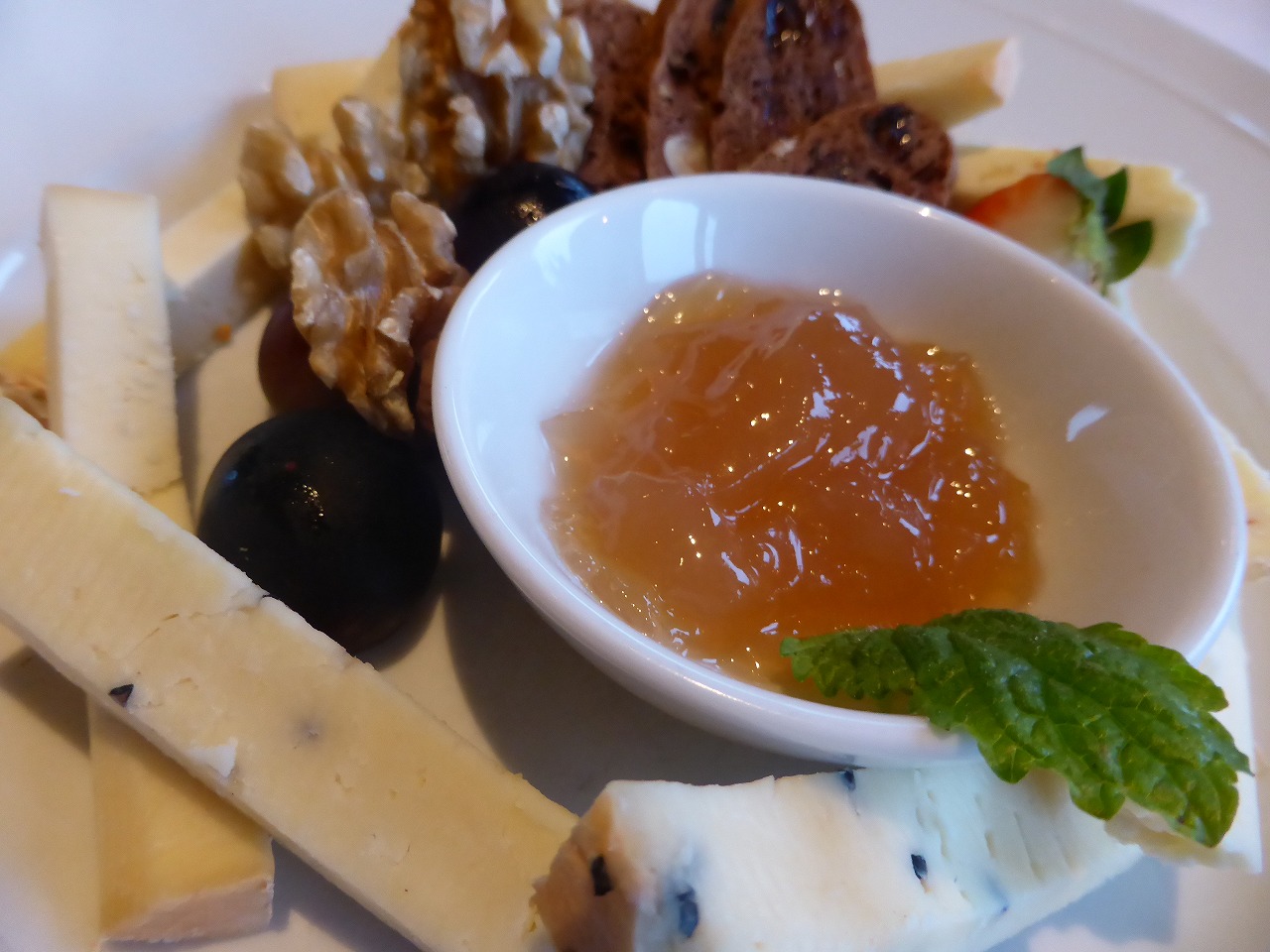 �`�[�Y�̐��荇�킹�B �`�[�Y�̐��荇�킹�B
���C�̋����`�[�Y�ƊÂ��W�����̑g�ݍ��킹�����������B
Assorted cheese.
A combination of cheese with strong salty taste and sweet jam was very good. |
| �@�h�C�c���s�E��z�e�� Trip to Germany/The Old Castle Hotel�@Junko�@ 2015�N5��12��(��) 23:26 |
�C�� |
 �f�U�[�g�B�p�C�i�b�v���P�[�L�ł����B �f�U�[�g�B�p�C�i�b�v���P�[�L�ł����B
Dessert. It was a pineapple cake. |
| �@�h�C�c���s�E��z�e�� Trip to Germany/The Old Castle Hotel�@Junko�@ 2015�N5��12��(��) 23:27 |
�C�� |
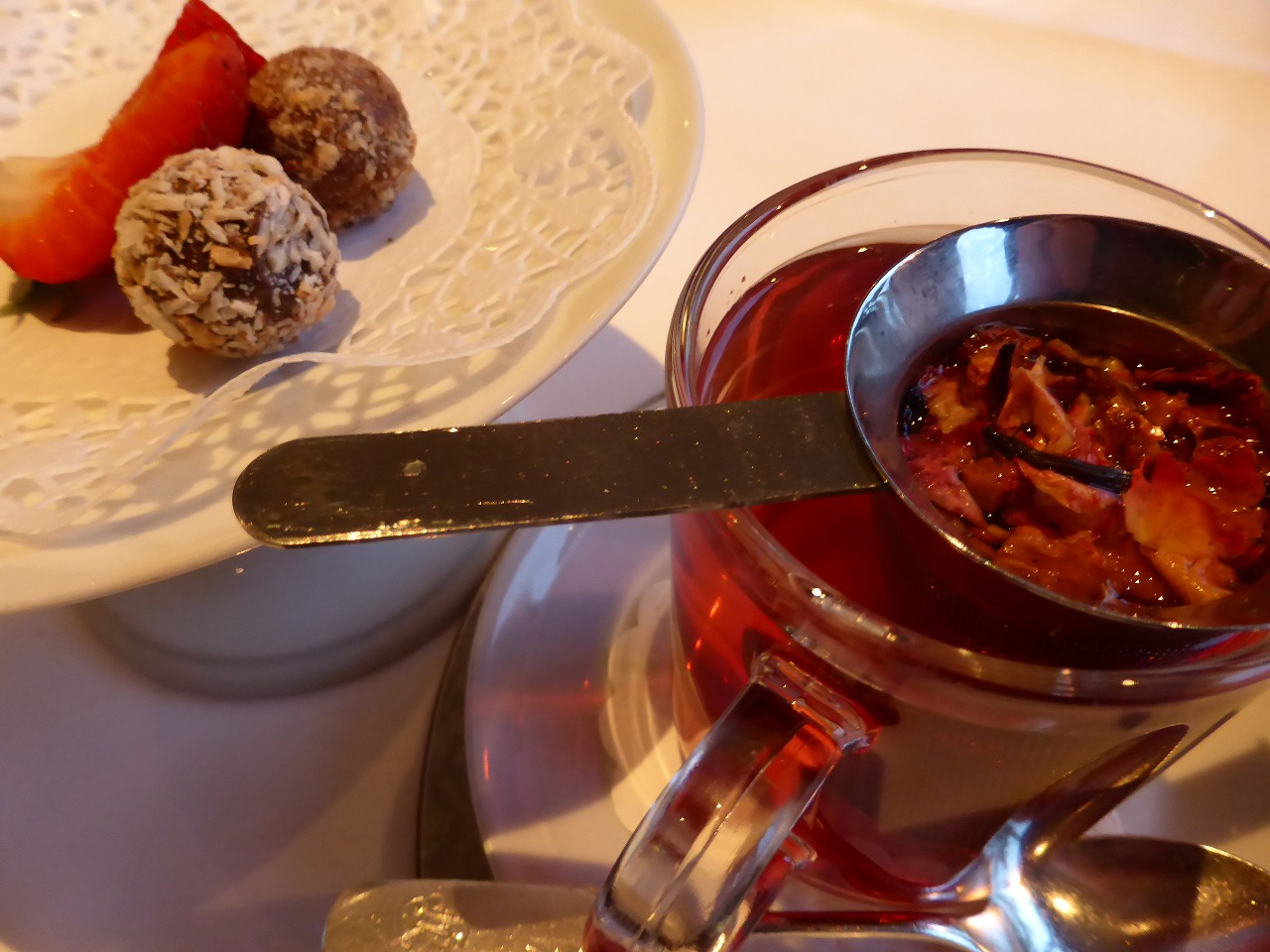 ���[�Y�E�t���[�c�e�B�B����̃`���R�ƈꏏ�ɁB ���[�Y�E�t���[�c�e�B�B����̃`���R�ƈꏏ�ɁB
A rose-fruit tea with hand-made chocolates. |
| �@�h�C�c���s�E��z�e�� Trip to Germany/The Old Castle Hotel�@Junko�@ 2015�N5��12��(��) 23:28 |
�C�� |
 �J�b�Z���̃g����������A���p�ٓ��ꌔ�A�������V���g���o�X�`�P�b�g�B�����͋A���B �J�b�Z���̃g����������A���p�ٓ��ꌔ�A�������V���g���o�X�`�P�b�g�B�����͋A���B
One day tickets of the tram, the entrance tickets of the art museum and shuttle bus tickets of the park in Kassel. We were going to go home tomorrow. |
| �@2015.05.04�@�h�C�c���s�E��z�e�� Trip to Germany/The Old Castle Hotel�@Junko�@ 2015�N5��12��(��) 23:31 |
�C�� |
 ���A�V�C���ǂ��Ȃ����̂Ńz�e���̎�������U���B ���A�V�C���ǂ��Ȃ����̂Ńz�e���̎�������U���B
We took a walk around the hotel in the morning because it was a good weather. |
| �@�h�C�c���s�E��z�e�� Trip to Germany/The Old Castle Hotel�@Junko�@ 2015�N5��12��(��) 23:34 |
�C�� |
 ����ȓ������Ă����Ɓc ����ȓ������Ă����Ɓc
When we walked such a way, |
| �@�h�C�c���s�E��z�e�� Trip to Germany/The Old Castle Hotel�@Junko�@ 2015�N5��12��(��) 23:35 |
�C�� |
 ����Ȃ��킢���Ƃ���������c ����Ȃ��킢���Ƃ���������c
We found such a pretty house. |
| �@�h�C�c���s�E��z�e�� Trip to Germany/The Old Castle Hotel�@Junko�@ 2015�N5��12��(��) 23:35 |
�C�� |
 ����ȓc�ɂ̕��i���݂���ł��܂��B ����ȓc�ɂ̕��i���݂���ł��܂��B
And we found such a country landscape. |
| �@�h�C�c���s�E��z�e�� Trip to Germany/The Old Castle Hotel�@Junko�@ 2015�N5��12��(��) 23:37 |
�C�� |
 �A�낤���ȁ[�Ǝv���Ă����獡���̐H�ނ��^��Ă��܂����B�傫�ȃC�m�V�V���Q���I �A�낤���ȁ[�Ǝv���Ă����獡���̐H�ނ��^��Ă��܂����B�傫�ȃC�m�V�V���Q���I
When we began to leave and saw the window, we found that today's foodstuff was brought. Two big wild boars ! |
| �@�h�C�c���s�E��z�e�� Trip to Germany/The Old Castle Hotel�@Junko�@ 2015�N5��12��(��) 23:38 |
�C�� |
 �r���A�f���b�Z���h���t�Ń����`�����ċA��\��ł��B �r���A�f���b�Z���h���t�Ń����`�����ċA��\��ł��B
We planed on going home after the lunch in Dusseldorf on the way home. |
| �@�h�C�c���s�E�f���b�Z���h���t Trip to Germany/Dusseldorf�@Junko�@ 2015�N5��12��(��) 23:39 |
�C�� |
 �����̃����`�B �����̃����`�B
���q�z�e���u�ٌc�v�̎��i�����`�ł��B����ɓ����ǂ��܂��B
Today's lunch.
Sushi-lunch of the Japanese restaurant "Benkei" in Nikko hotel. A meat udon came along with it. |
| �@�h�C�c���s�E�f���b�Z���h���t Trip to Germany/Dusseldorf�@Junko�@ 2015�N5��12��(��) 23:40 |
�C�� |
 �����̃����`�B �����̃����`�B
������͓��ւ��B�X�^�~�i���ɂ킩�߂��ǂ�A�����i����҂�ł����j�����ĂP�Q���[���I�₷�[���I�I
Today's lunch.
This is a today's special. It was 12 euro with a roasted meal bowl, a meat udon and a small bowl (Chopped burdock root cooked in sugar and soy sauce). I think it was very reasonable. |
| �@�h�C�c���s Trip to Germany�@Junko�@ 2015�N5��12��(��) 23:44 |
�C�� |
 �C���@�Ŕ��������C���A�X�p�[�N�����O���C���ƌÏ�z�e���Ŕ������X�p�[�N�����O���C���B�J�b�Z���̓O�����Z�킪������炵���ꏊ�Ƃ������Ƃ������āA���x���ɂ̓O�����Z�킪�f�U�C������Ă��܂��B �C���@�Ŕ��������C���A�X�p�[�N�����O���C���ƌÏ�z�e���Ŕ������X�p�[�N�����O���C���B�J�b�Z���̓O�����Z�킪������炵���ꏊ�Ƃ������Ƃ������āA���x���ɂ̓O�����Z�킪�f�U�C������Ă��܂��B
A wine and a sparkling wine which we bought at the abbey and a sparkling wine which we bought at the old castle hotel. Grimm brothers are drawed on the label of the hotel's sparkling wine, because they had lived in Kassel for a long time. |
| �@�h�C�c���s Trip to Germany�@Junko�@ 2015�N5��12��(��) 23:45 |
�C�� |
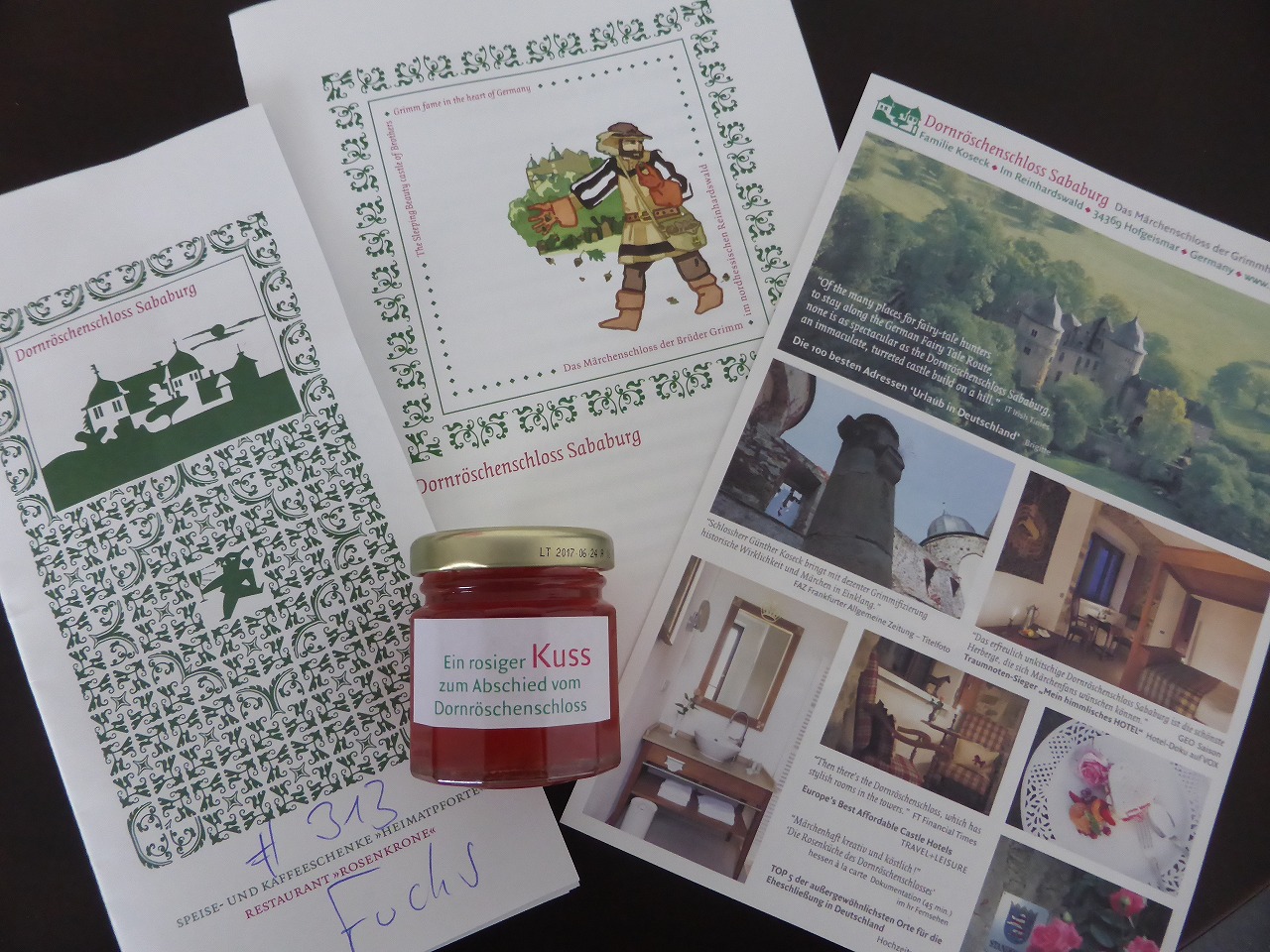 �Ï�z�e�����O�������b���e�[�}�ɂ��Ă��܂����B���݂₰�ɂ�̃W���������������܂����B �Ï�z�e�����O�������b���e�[�}�ɂ��Ă��܂����B���݂₰�ɂ�̃W���������������܂����B
The old castle hotel features the theme of Grimm's Fairy Tales. They gave us a rose-jam for a souvenior. |
| �@�h�C�c���s Trip to Germany�@Junko�@ 2015�N5��12��(��) 23:46 |
�C�� |
 Nici�̂ʂ�����݁B�A�E�g���b�g�Ŕ��z�ł����B Nici�̂ʂ�����݁B�A�E�g���b�g�Ŕ��z�ł����B
Stuffed animals of Nici. I bought them half-price at their outlet shop. |
|